BASEL MOMENTS
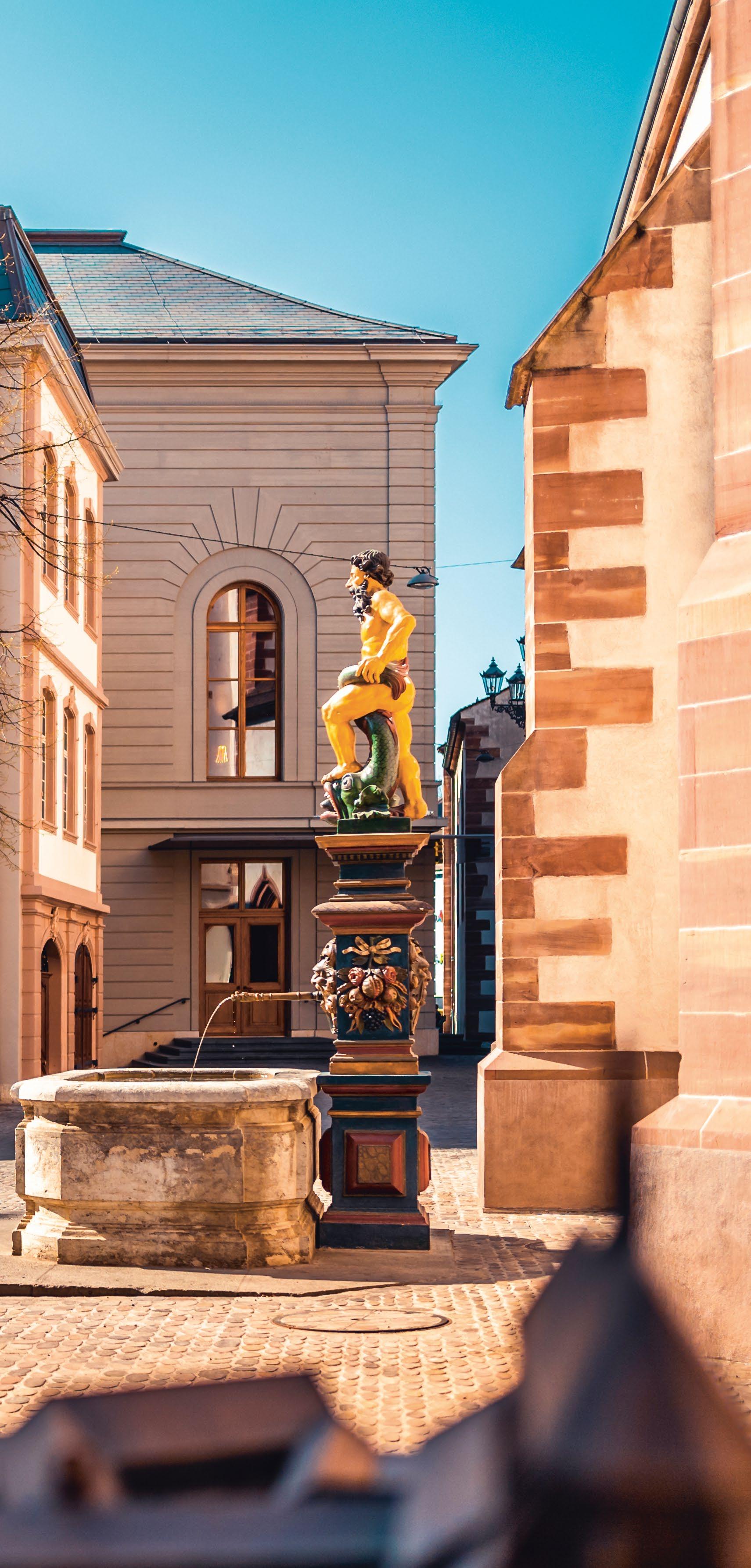
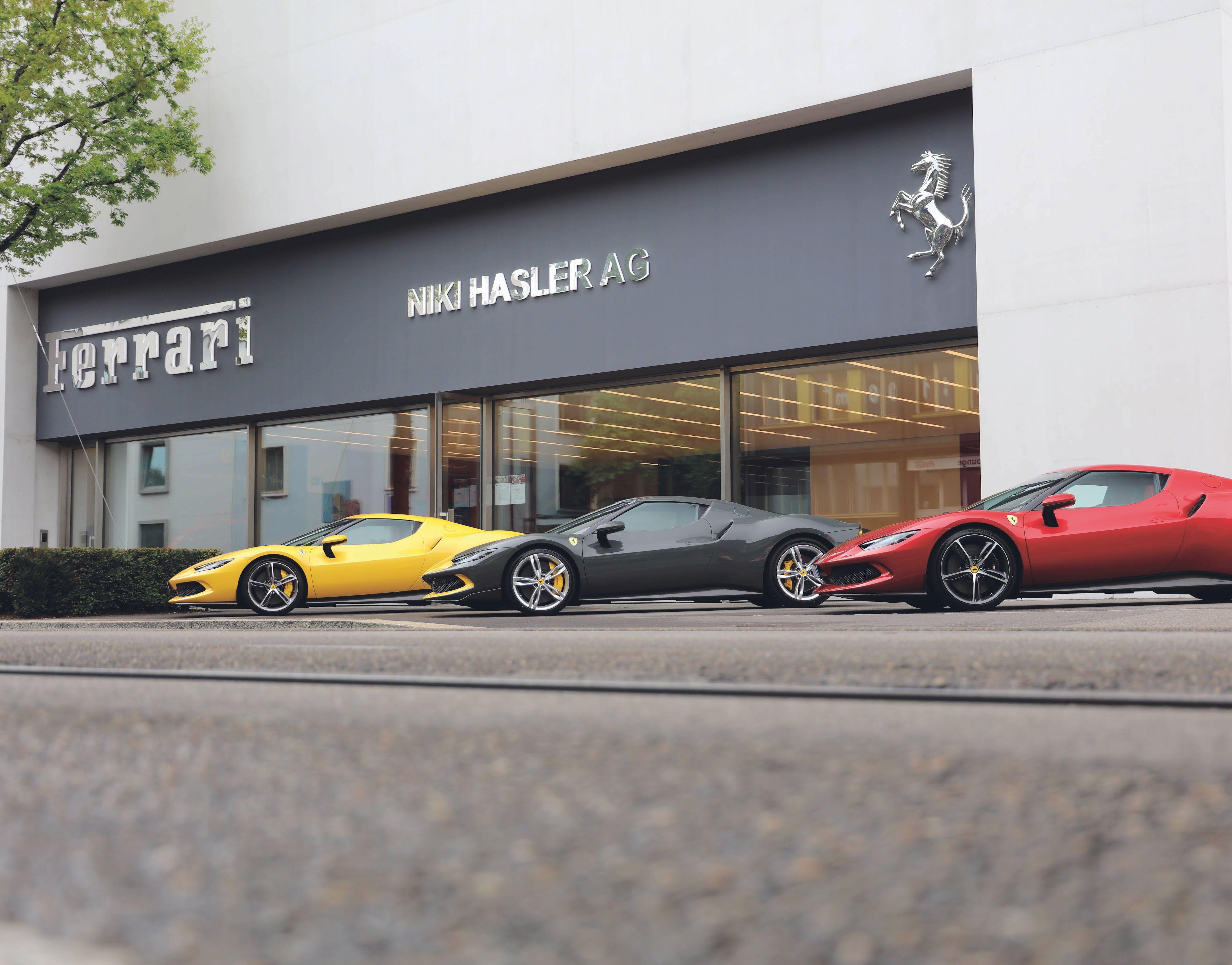
AUF, GLÜCK REIN
Einfach mal so am Rhein rumhängen. In die Sonne blinzeln, die frische Luft einsaugen, den Leuten beim Menschsein zusehen und die blubbernde Freude in der Brust geniessen. Die Restaurants und Bars sind voll, die Spielplätze belebt, Strassenmusik tröpfelt zwischen plappernden Studis, quietschenden Velobremsen und klingelnden Trams hindurch, Hunde bellen, Möwen schreien, Menschen lachen – Basel klingt so schön! Am Rheinufer sitzend beschert einem das fröhliche Scheiaweia aus Englisch, Französisch, Türkisch oder Spanisch Urlaubsgefühle. Und dann erst die Schiffe: gemächlich tuckern Lebens mittel aus Asien, Spielzeug aus China, Rohstoffe aus Nahost und Autos aus den USA an einem vorbei. Zudem Schiffspassagiere aus Düsseldorf, Köln oder Amsterdam.
Tatsächlich braucht es nur einen bewussten Moment am Fluss, um die Lebensqualität der Stadt zu erkennen. Literatur und Comedy, Theater, Zirkus und Tanz, dazu experimentelle Mischungen verschie denster Sparten – check, haben wir. Alte Geschichte, neue Kunst, grosse Architektur und grossartige Gastronomie – alles hier. In den Fluss hüpfen, aufs Münster steigen, über sieben Brücken gehen –alles möglich. Je nach Jahres- oder Tageszeit begleitet vom Duft nach frischem Kaffee oder Flusswasser, nach Glyzinien oder Mimosen, gebrannten Mandeln oder verbrannten Würsten.
Basel ist die Welt in Kleinformat. Zu Fuss kannst du hier innerhalb weniger Minuten die Grenze zu Frankreich und Deutschland erreichen, eine Kuh streicheln oder zu den höchsten Türmen der Schweiz hochblicken. Um dir deines Glücks bewusst zu werden, musst du lediglich einmal in Ruhe ans andere Ufer blicken – zack, schon kommt das Glück rein. Vielleicht nimmst du bei der Gelegenheit ja dieses Magazin mit, setzt dich auf eine Bank und geniesst diesen seltenen analogen Moment.
EYES OPEN, SOAK UP THE HAPPINESS
Hanging around near the Rhine. Squinting in the sun, soaking up the fresh air, watching people being people and enjoying that feeling of happiness welling up in your chest. The restaurants and bars are full, the playgrounds are bustling, street musicians play through the chatting students, squeaky bike breaks and tram bells ringing, dogs barking, seagulls crying, people laughing – Basel sounds so wonderful! When you sit on the banks of the Rhine, the cheerful mixture of English, French, Turkish and Spanish makes it all feel like a vacation. And then there are the ships: foodstuffs from Asia, toys from China, raw materials from the Middle East and cars from the USA chug serenely past you. Plus the passenger ships from Düsseldorf, Cologne and Amsterdam.
All it really takes to grasp the quality of life this city has to offer is moment of conscious appreciation at the river. Literature and comedy, theatre, circus and dance, plus an experimental mixture of very different genres – check, we have them all. Ancient history, modern art, marvellous architecture and excellent gastronomy – all here. Leap into the river, climb the cathedral tower, cross over seven bridges – it’s all possible. Depending on the time of year, or day, you’ll be accompanied by the scent of fresh coffee or river water, wisteria or mimosas, roasted almonds or burnt sausages.
Basel is the world in miniature. You can walk to the borders of France and Germany from here in a few minutes, you can stroke a cow or gaze up at Switzerland’s highest tower. To realise how lucky you are, all you have to do is take a quiet look across at the other river bank – and bang, happiness floods in. Perhaps while you’re there, you’ll take this magazine with you, sit down on a bench and enjoy a rare non-digital moment.
EDITORIAL
#LoveYourCity
#LoveYourCity
Love Your City 3
AUGEN
Der Maître d'Hotel der Brasserie Les Trois Rois lässt sich über die Schulter blicken Im Gespräch mit Zolli-Direktor Olivier Pagan
Auf einen Kaffee mit Theaterintendant Benedikt von Peter
Vier Fähren für eine der schönsten Traditionen der Stadt
GLOBALES PROBLEM? BASLER LÖSUNG!
Die verrückte Geschichte von Tide Ocean
Kunsthalle-Direktorin Elena Filipovic über irritierte Väter und die Stars von morgen
Celestino Piattis Atelier im St. Johann
6
42
60 DER
VISUELLES
PRÄGTE 21
16
51
34
HERVÉ MAHLER IST GASTGEBER, AUSBILDNER, GENTLEMAN
STADTOASE, ERLEBNISWELT & RETTUNGSRING
MANN, DER UNSER
GEDÄCHTNIS
DIE GUTEN SEELEN AUF DEM RHEIN
GEKOMMEN, UM BARRIEREN ABZUBAUEN
EINE NEUE SICHT AUF DIE WELT
In
12
38 57 STAUNEN. LERNEN & GENIESSEN 30 WIE IM HIMMEL 4
URBAN, HIP & LOKAL IN D ER DICHTE DER B AUKUNST


GASTGEBER, AUSBILDNER, GENTLEMAN
Er ist ein Meister der Gastfreundschaft und beherrscht sein Handwerk mit Herzlichkeit und absoluter Präzision. Hervé Mahler, Maître d'Hotel und Gastgeber in der Brasserie Les Trois Rois, sorgt mit einer grossen Portion Herzlichkeit dafür, dass das junge Herz dieser geschichtsträchtigen Institution ambitioniert und kerngesund schlägt.
Text & Bilder: Andreas Schwald
Monsieur Mahler ist eine Erscheinung, wie man sie nicht mehr jeden Tag trifft. Akkurat ist das graumelierte Haar gekämmt, makellos sitzt die Livrée, der Blick ist wach und aufmerksam. Schon zur Begrüssung liegt der Charme in seinem Lächeln. Man merkt im ersten Moment (und danach immer und immer wieder): Dieser Mann ist Gastgeber durch und durch. Mit Vornamen heisst Monsieur Mahler Hervé, aber angesichts dieser würdevollen Person ist man geneigt, die Höflichkeitsform zu verwenden – aus Respekt gegenüber seiner freundlichen, stets zuvorkommenden Art, aber auch aus Respekt gegenüber der Tatsache, dass dieser Mann die Brasserie des Grand Hotel Les Trois Rois mit all ihrer Eleganz und ihrer Geschichte repräsentiert. Ja, Hervé Mahler verkörpert, was man in Basel als «Monsieur» bezeichnet.
Hervé Mahler ist aber nicht nur der Mann, der in der Brasserie den Betrieb orchestriert, er ist auch Maître d'Hotel der angesehensten Herberge am Rheinknie, dem historischen Grand Hotel Les Trois Rois am Blumenrain. Gemeinsam mit Chef de Cuisine Thomas Schaefer stellt er sicher, dass die Brasserie einer der hellsten Sterne am Gastrohimmel der Region bleibt.

HERVÉ MAHLER IST
6 BASEL MOMENTS
In einschlägigen Kreisen ist es schon lange bekannt: Maître Mahler und Chef Schaefer sind der Inbegriff eines eingespielten Teams. Küche und Service greifen ineinander wie ein wohlkalibriertes Uhrwerk, ohne auch nur ansatzweise technisch zu wirken. Nichts lenkt von der sinnli chen und genussvollen Erfahrung ab, die einem diese eingespielte Brigade kredenzt. Schliesslich ist genau dies der Zauber, der grosser Handwerkskunst innewohnt. Absolute Präzision in der täglichen Arbeit? Selbstverständlich. Ein erstklassig informierter, topmoderner Service? Fraglos. Geniale Produzenten und dazu ein prononcierter regionaler Fokus? Geschenkt.
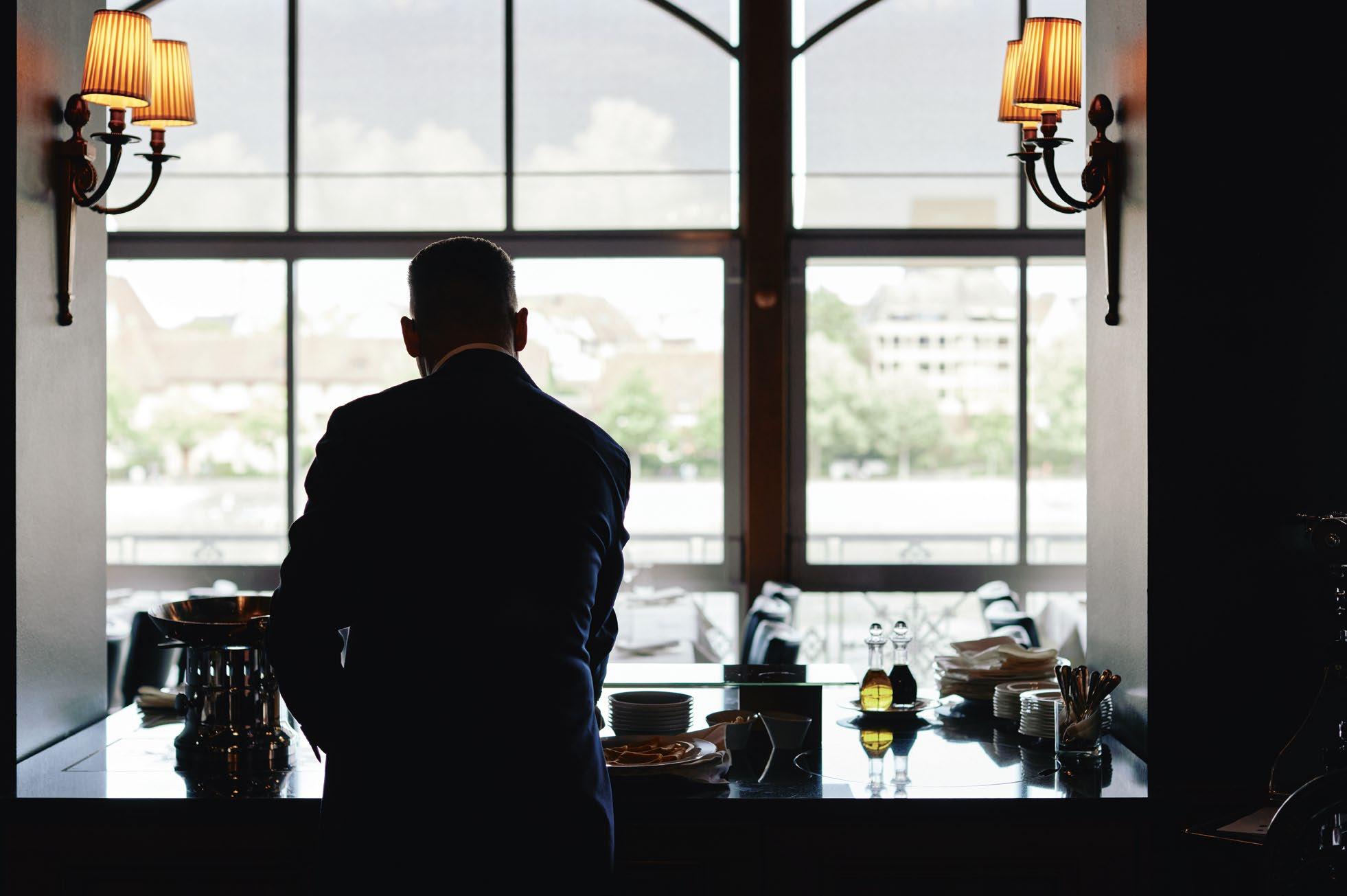

Beim Gespräch sitzen wir an einem Tisch am Entrée zur Brasserie, das Mittagsgeschäft hat noch nicht ganz begonnen. Während der ersten pandemiebedingten Schliessung wurde hier die Zeit genutzt, dem Raum ein neues Gesicht mit neuer Farbe und Kunst – wohlgemerkt aus dem Chez Donati – zu verleihen. Die petrolblauen Wände strahlen eine wunderbare Ruhe aus, während weiches Tageslicht von der grossen Fensterfront auf den Rhein hin den Raum flutet. Wie die Kunden reagier ten? «Begeistert!», sagt der Maître. Die Werke an den Wänden würden regelmässig zum Gesprächsthema an den Tischen, bei vielen Gästen habe die Kunst einen hohen Stellenwert und nicht wenige besuchen gerade deswegen die Brasserie so gerne. Die Neugestaltung durch die Besitzerfamilie Straumann nahm er auch als eine persönliche Wertschät zung wahr, als Ausdruck des Vertrauens, das ihm stets von den Direktoren entgegengebracht worden war – und wird.

7 BASEL MOMENTS
16 Jahre ist Hervé Mahler nun am Stück für das Les Trois Rois tätig. Die Brasserie ist sein Baby, wie er selbst sagt: «Qualität braucht Kontinuität. Der Gast – der Mensch! – steht im Zentrum, seine Bedürfnisse, sein Wohl kommen bei uns immer an erster Stelle.» Das ist kein Klischee, das ist Hervé Mahlers Maxime. Das A und O sei eben, dass jeder Mensch individuell behandelt wird, man sich der Situation anpasse: «Hat ein Gast Probleme, kümmert man sich sofort darum.» Die Kundenbedürfnisse wirklich zu kennen und zu verstehen, das ist die hohe Kunst des Berufs. Hinzu kommt, dass Hervé Mahler das Leitmotiv des Grand Hotels auch selbst verkör pert: «Rich in history, young at heart.» Ursprünglich aus Strasbourg, führten ihn seine Stationen nach Südfrankreich, nach England, nach Deutschland und danach in die Schweiz. 1998 war er bereits zum ersten Mal während zwei Jahren im Grand Hotel Les Trois Rois tätig. Dann wechselte er fürs Erste nach Zürich. 2006 sollte schliesslich zum Schicksals jahr werden. Das Grand Hotel Les Trois Rois fragte ihn, ob er für die Neueröffnung der Brasserie nach Basel zurückkehren wolle? Ja, aber er wollte eigent lich nur ein Jahr bleiben – der Rest ist Geschichte. Hervé Mahler verliebte sich in die Region, wurde hier ansässig, gründete eine Familie und ist mittler weile selbst zu einer Institution geworden. Das wissen seine Stammgäste, das merken aber auch die neuen Gäste schnell, die genauso herzlich und aufmerksam willkommen geheissen werden wie langjährige Freunde und Familie der Brasserie.

Zurzeit gibt Hervé Mahler neben dem Gästewohl und der Sicherstellung der grossen Klasse dieser Lokalität noch etwas anderes zu denken. Die Pande miemassnahmen waren auch hier deutlich zu spüren. Nun geht es darum, aufzubauen. Und weil ein Maître d'Hotel sich um weitaus mehr kümmert, als der Gast mitbekommt – und mitbekommen sollte –, macht auch dies einen nicht unwesentlichen Teil des Ge schäfts von Hervé Mahler aus. Als Verantwortlicher für Personal und Ausbildung laufen beim Maître alle Fäden zusammen. «Die Lage ist in der Tat ange spannt», sagt Hervé Mahler. «Gute Leute finden in der Gastronomie immer einen Job, immer. Die Szene ist bestens vernetzt. Aber man merkt schon, an Nachwuchs fehlts.» Deshalb wird zurzeit die Ausbildung grossgeschrieben. Es laufen bereits mehrere Kampagnen und einen wesentlichen Teil davon machen die Quereinsteiger aus. Besonders ambitionierte, motivierte Quereinsteiger sind ausgesprochen gefragt.
Natürlich fordert der Job als Gastgeber seine Opfer. Der Anspruch ist hoch, es geht darum, Beziehungen zu pflegen, Bedürfnisse zu erkennen, schnelle Ent scheidungen zu treffen, den Betrieb und das Busi ness zu kennen. Selbst Hervé Mahler begibt sich nach wie vor in die Zimmerstunde. Das heisst: Schon am Morgen bereit sein, um den Mittagsservice sicherzustellen, danach eine längere Pause – das ist die besagte Zimmerstunde –, um dann frisch in den Abendservice zu starten. Es sind manchmal lange,
«Qualität braucht Kontinuität.
Der Gast - der Mensch! - steht im Zentrum, seine Bedürfnisse, sein Wohl kommen bei uns immer an erster Stelle.»
8 BASEL MOMENTS
sehr lange Tage, aber es sind lohnende Tage. Wer sich in diesem Business behauptet, der hat das Zeug zum hervorragenden Gastgeber. Oder wie es Hervé Mahler sagt: «Viel investieren und dann nicht da sein, wenn es darauf ankommt, das geht natürlich nicht.» Dass sich die Investition lohnt, zeigt seine Karriere. Längst ist sein Wirkungsraum nicht mehr nur auf die Brasserie beschränkt, als Maître d’Hotel – einer höchst angesehenen Funktion – ist er beispielsweise auch für Events und Caterings zuständig.

Wer bei Hervé Mahler eine Ausbildung absolviert, ist bestens für die Welt der gehobenen Küchen gerüstet: «Wir formulieren immer Ziele und schaffen die nötigen Bedingungen, diese zu erreichen. Ein Ziel ist es zum Beispiel, dass auch wer ein Praktikum macht, nach sechs Monaten selbst ständig eine Station bedienen kann.» Das ist nicht üblich und spricht für den Gedanken des Förderns und Forderns, der bei Hervé Mahler in allen Aspekten dominiert. Als Ausbildner wird er geschätzt und respektiert, die Belegschaft weiss, dass sie mit ihrem Maître einen umsichtigen Chef hat. Dass die Brasserie heute noch über Mitarbeiter verfügt, die bereits zwischen sechs und zehn Jahren im Betrieb arbeiten, ist in dieser schnell lebigen Branche insbesondere auch dem Maître zu verdanken. Die Szene weiss, wer bei Hervé Mahler in der Ausbildung war, der oder die kann was. Und wie der Maître bereits sagte: Wer etwas auf dem Kasten hat, der findet in dieser Szene immer einen Job. Immer.

In dieser Klasse der Gastronomie ist es auf allen Ebenen so und Hervé Mahler lebt es beispielhaft vor: Wenn man etwas aufbaut, dann muss man es auch pflegen. Man muss sich zwar am Zeitgeist ausrich ten, natürlich, soll sich aber nie einfach der Mode hingeben, sondern muss seine eigene Sprache und seinen eigenen Stil entwickeln. Menschlich, fachlich, kulinarisch. So gelingt, was dem Team der Brasserie Les Trois Rois immer wieder aufs Neue gelingt: In einem Traditionslokal, das so reich an Geschichte wie kaum ein anderes ist, ein unablässig junges, ambitioniertes und kerngesundes Herz schlagen zu lassen.
BRASSERIE LES TROIS ROIS
Blumenrain 8, lestroisrois.com
9 BASEL MOMENTS
HERVÉ MAHLER IS A HOST, INSTRUCTOR, GENTLEMAN
He is a master in hospitality and exercises his craft with warmth and absolute precision. Hervé Mahler, maître d’hôtel and host at the Brasserie Les Trois Rois, ensures, with generous heartiness, that the young heart of this institution so rich in history, continues to beat in good health and full of ambition.
Monsieur Mahler is the kind of figure you don’t meet every day anymore. His hair, streaked with grey, is carefully com bed, his livery fits immaculately, his gaze is lively and alert. His charm is apparent in the first smile as he greets you. You notice straight away (and then again and again) that this man is a host to the core. Monsieur Mahler’s first name is Hervé, but confronted with the dignity of his person, you feel in clined to address him politely as Monsieur – out of respect for his friendly and always obliging manner, but also out of respect for the fact that this man represents the brasserie of the Grand Hotel Les Trois Rois with all its elegance and long history. Indeed, Hervé Mahler embodies what we understand by “Monsieur” in Basel.
Hervé Mahler is not only the man who orchestrates the running of the Brasserie, he is also the Maître d'Hotel of the most prestigious hotel at the bend in the Rhine, the historic Grand Hotel Les Trois Rois at the Blumenrain. Together with the executive chef, Urs Gschwend, and the chef de cuisine, Thomas Schaefer, he ensures that the Brasserie continues to radiate as one of the brightest stars in the region’s gastronomic heavens. It has been a matter of common knowledge in well-connected circles for some time now, that Maître Mahler, executive chef Gschwend and chef de cuisine Schaefer are the epitome of a perfectly-tuned team. The kitchen and service engage like well-calibrated clockwork, but without ever appearing even remotely mechanical. Nothing distracts from the luscious and deeply pleasurable experience offered by this well-practised brigade. In the end, it is precisely this that is the heart of great craftsmanship. No wonder the Brasserie’s classics are legendary: The tartare de boeuf, which for Hervé Mahler is a top-priority issue, or the bisque de homard, a labour of love by chef Gschwend. Absolute precision in day-to-day work? Of course. Superbly informed, state-ofthe-art service? Without doubt. Choice producers and a decidedly regional focus? What else!
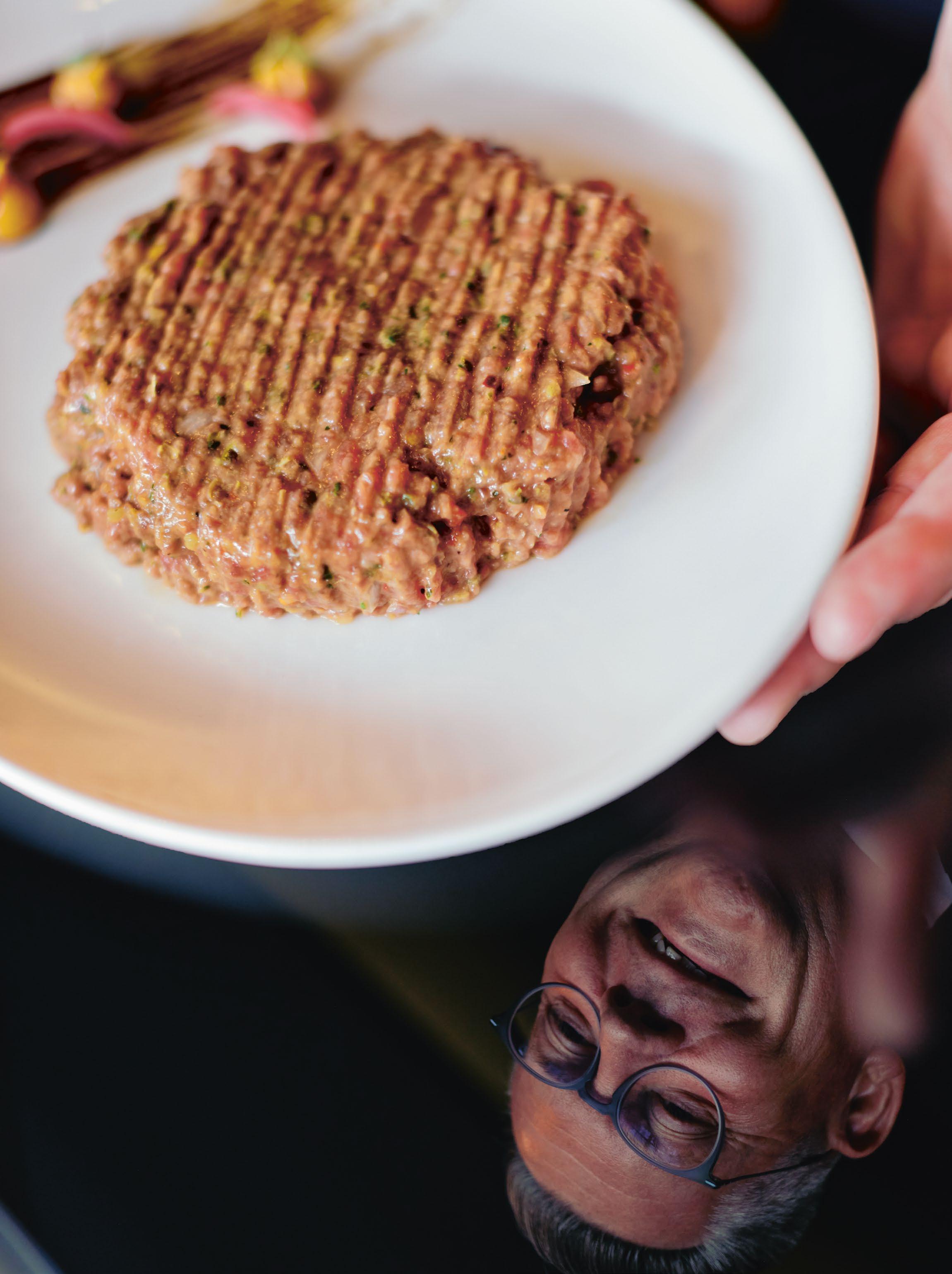
10
We are talking at a table near the entrance to the Brasserie; the lunch guests are only just starting to arrive. The time during the first closure due to the pandemic was used to give the room a new look with new paint and artworks – from Chez Donati it should be noted. The petrol-blue walls radiate a wonderful calm, while soft daylight floods into the room from the large row of windows facing the Rhine. How did their clientele react? “Impressed!”, says the Maître. The works displayed on the walls are often a topic of conversation at the tables, art is important to a lot of the guests and quite a number of them enjoy coming to the brasserie for this very reason. He also appreciated the redesign by the owners, the Straumann family, as a personal sign of their esteem, as an expression of the trust that has always been – and still is –placed in him by the management.
Hervé Mahler has been working for the Les Trois Rois for 16 continuous years now. The Brasserie is his baby, and as he himself says: “Quality requires continuity. The guests – human beings! – are the focal point; for us, their needs, their well-being always come first.” This is not a cliché, it is Hervé Mahler’s motto. Fundamentally important is that each person is treated individually, and that every new situation is adapted to: “If a guest has a problem, we attend to it immedi ately.” Really recognising and understanding your customers’ needs, that is the high art of the profession. Added to that is the fact that Hervé Mahler himself embodies the motif of the Grand Hotel: “Rich in history, young at heart.” Originally from Strasbourg, his employment took him to the South of France, to England, Germany and then to Switzerland. In 1998 he started his first two years of employment at the Grand Hotel Les Trois Rois. Then he moved to Zurich for a while. 2006 was the year his fate was sealed. The Grand Hotel Les Trois Rois asked whether he would come back to Basel for the reopening of the brasserie? Yes, but in fact he had only been planning to stay for one year – the rest is history. Hervé Mahler fell in love with the region, settled down here, started a family and in the meanwhile he himself has become an institution. His regular guests know this, but new visitors realise it very quickly too, as they are greeted just as warmly and attentively as long-standing friends and family of the brasserie.

There is currently something else on Hervé Mahler’s mind, besides the well-being of his guests and maintaining the high reputation of this locality. The measures taken to deal with the pandemic left their mark here too. Now it is a matter of building things up again. And because a maître d'hotel takes care of far more things than a guest realises – or should realise – this also constitutes a not-insignificant part of Hervé Mahler’s work. He is ultimately responsible for the staff and training, so he holds all the strings in his hands. “The situation is actually quite difficult”, says Hervé Mahler. “Good people will always find a job in gastronomy. The scene has a very good network. But we are definitely noticing that we are lacking fresh young talent.” That is why there is so much emphasis on training at the moment. Several campaigns have already been launched and a significant proportion of those addressed are newcomers from other branches because it is ambitious, motivated lateral recruits who are in particularly high demand.
Of course, the job of being the host requires sacrifices. It is a demanding position, it’s about maintaining relationships, noticing requirements, making decisions quickly, knowing the establishment and the business inside out. Even Hervé Mahler still takes an unpaid break each day. That’s to say: he is there in the morning to ensure the lunch service works, then he takes a long unpaid break, to later restart the workday in preparation for the dinner guests. Sometimes the days are long, very long, but also rewarding. Anyone who can hold their own in this business has what it takes to be an outstanding host. Or as Hervé Mahler says: “To invest a great deal and then not be there when it really counts, of course that doesn’t work.” His career is proof that the investment pays off. For some time already, his sphere of influence has not been limited to just the brasserie, as the maître d’hotel – a highly respected position –he is also responsible for areas such as events and catering.
Anyone who completes an apprenticeship with Hervé Mahler is perfectly prepared for the world of fine dining: “We always formulate our goals and then create the conditions necessary to achieve them. One goal, for example, is anyone completing an internship will be able to operate a station independently within 6 months.” This is not so common and says something for the philosophy of encouraging and challenging, which is predominant in every aspect of Hervé Mahler’s style of management. He is very highly regarded and respected as a training instructor; the staff know that they have a prudent boss in their maître. The fact that the brasserie still has employees who have been working here for between six and ten years in such a fast-moving industry, is especially thanks to this Maître. It is well-known throughout the scene that anyone who has trained with Hervé Mahler knows what they are doing. And as the Maître himself pointed out: Anyone with some aptitude, will always find a job in this branch. Always.
In this class of gastronomy, it is like this at every level, and Hervé Mahler is an exemplary role model: If you establish something, then you have to take care of it afterwards as well. You have to bow to the spirit of the times, of course, but you should not simply be enslaved by fashions, you have to develop your own idiom and your own style. As a person, professionally, gastronomically. This is how the team at the Brasserie Les Trois Rois succeeds time and again: keeping the young, healthy and ambitious heart of this hotel, with its long tradition and a history richer than almost any other, beating.

11 BASEL MOMENTS
URBAN, HIP & LOKAL
HIER IST SHOPPING EINE PFLICHT!
Es gibt Läden, in die möchte man am liebsten einziehen. Weil sie dermassen stylisch daherkommen, nachhaltige Konzepte umsetzen, individuelle Marken und angesagte Produkte führen. Wir stellen dir hier ein paar Shops vor, die du besucht haben musst.
QWSTION/SOEDER
Rebgasse 10 - madefromplants.ch
Pflanzen statt Plastik; die beiden Schweizer Labels QWSTION + SOEDER machen in diesem Store gemeinsame Sache. Und sie machen es richtig: Sie fertigen zeitlose Taschen und Naturkosmetik mit Kreislauf-Denken und verantwortungsvoller Herstellung. Extrem angesagt – nicht nur in Basel!
Plants instead of plastic; the two Swiss labels QWSTION + SOEDER share a mission in this store. And they do it just right: manufacturing timeless bags and natural cosmetics while respecting the environment and with responsible production methods. Extremely popular – and not just in Basel!
 AHOI AHOI
AHOI AHOI
Untere Rheingasse 10 – ahoiahoi.ch

Concept Store, Webshop und Projektraum – Ahoi Ahoi ist ein Ankerplatz für interdisziplinäre Projekte. Hier wirst du von Design, Mode, Accessoires, Wohnzubehör, Möbel und Kunst aus aller Welt umgarnt. Hier entdeckst du Unbekanntes und Unerwartetes. Gefährlich, wenn du nur ein wenig gucken willst, weils aus allen Ecken schreit: Kauf mich!
Concept store, web shop and project room – Ahoi Ahoi is a harbour of interdisci plinary projects. You will find yourself beguiled by all the design, fashion, accesso ries, home equipment, furniture and art from all over the world. You will discover the unknown and the unexpected here. A bit dangerous, if you only want to look around, because from every corner the merchandise is screaming: Just buy me!
12 BASEL MOMENTS
JOYNE
Spalenberg 15 – joyne.com
In diesem Lifestyle-Mekka im nordisch-minimalistischen Stil findest du so ziemlich alles, was das Leben stilvoller macht. Im ersten Stock gibts zudem ein Café mit skandinavischem Gebäck und kleinen warmen Mahlzeiten.
At this lifestyle mecca with its minimalistic Nordic style, you’ll find almost everything that makes life more elegant. On the upper floor there is also a café with Scandinavian biscuits and small cooked meals.
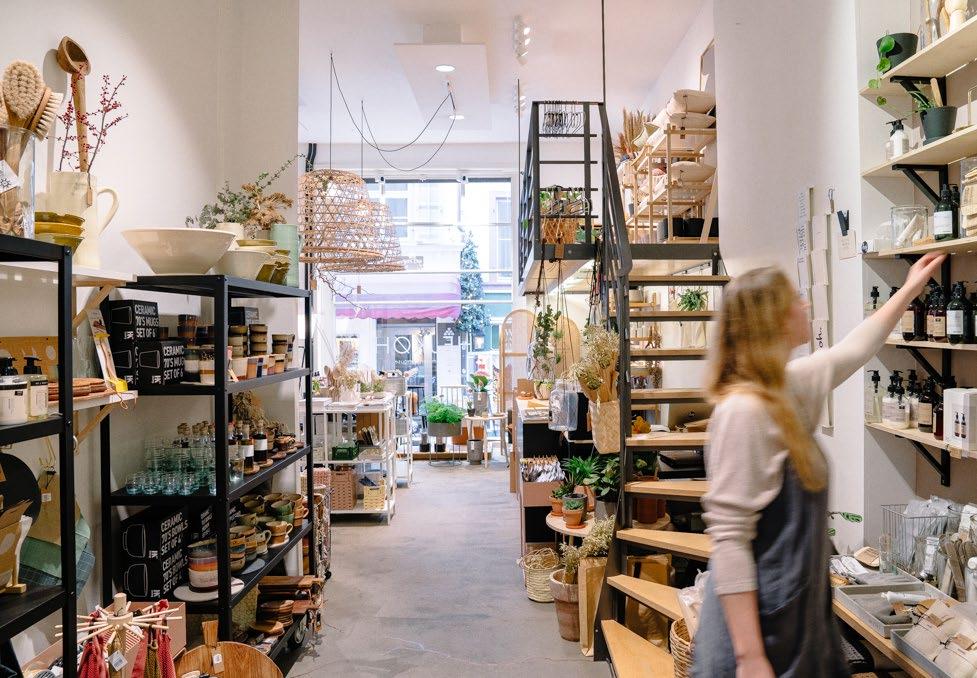
OOID
St. Johanns-Vorstadt 33 – ooid-store.com
Kennst du die Marken Norse Projects, Libertine-Libertine, Papu Stories, Won Hundred, Royal Republiq, Demylee oder Berenik? Ja, nein – egal!
Bei Ooid findest du unzählige internationale und Schweizer Modelabels für sie und ihn. Hier trifft Design auf Nachhaltigkeit und Qualität, hier bist du im Himmel der zeitlosen Lieblingsteile.
Do you know any of these brands: Norse Projects, Libertine-Libertine, Papu Stories, Won Hundred, Royal Republiq, Demylee and Berenik? Yes, no – it doesn’t matter!
At Ooid you’ll find an incredible range of international and Swiss fashion labels for him and her. Design is coupled with sustainability and quality here and you’ll find yourself in a paradise of timeless favourites.
TARZAN
Spalenberg 39 – tarzan.ch
Cool, nachhaltig und wild: Das Basler Label Tarzan stellt eine eigene Kollektion aus Bio-Baumwolle her und ergänzt diese mit skandinavischen Brands, coolen Accessoires und Lifestyle-Produkten für kleine und grosse Mode- und Design-Fans. Bei Tarzan gibts übrigens auch die schönsten Schwimmsäcke – das beste Mitbringsel aus Basel!
Cool, sustainable and wild: the Basel label Tarzan produces its own collection made of organic cotton and supplements it with Scandinavian brands, cool accessories and lifestyle products for young and old fans of fashion and design. By the way, Tarzan also has the most beautiful waterproof swimming bags –the best souvenir from Basel!
ZOOLOOSE PURE
Falknerstrasse 9 – zooloose.ch
Hier findest du auf 175m² hochwertige Kleidermarken, Accessoires und Lifestyle-Produkte aufstrebender Labels wie APC, Humanoid, Hannes Roether oder Harris Wharf. Für Exklusivität sorgt neben den kleinen Stückzahlen auch die goldene Umkleide, in der du garantiert glamourös aussiehst.
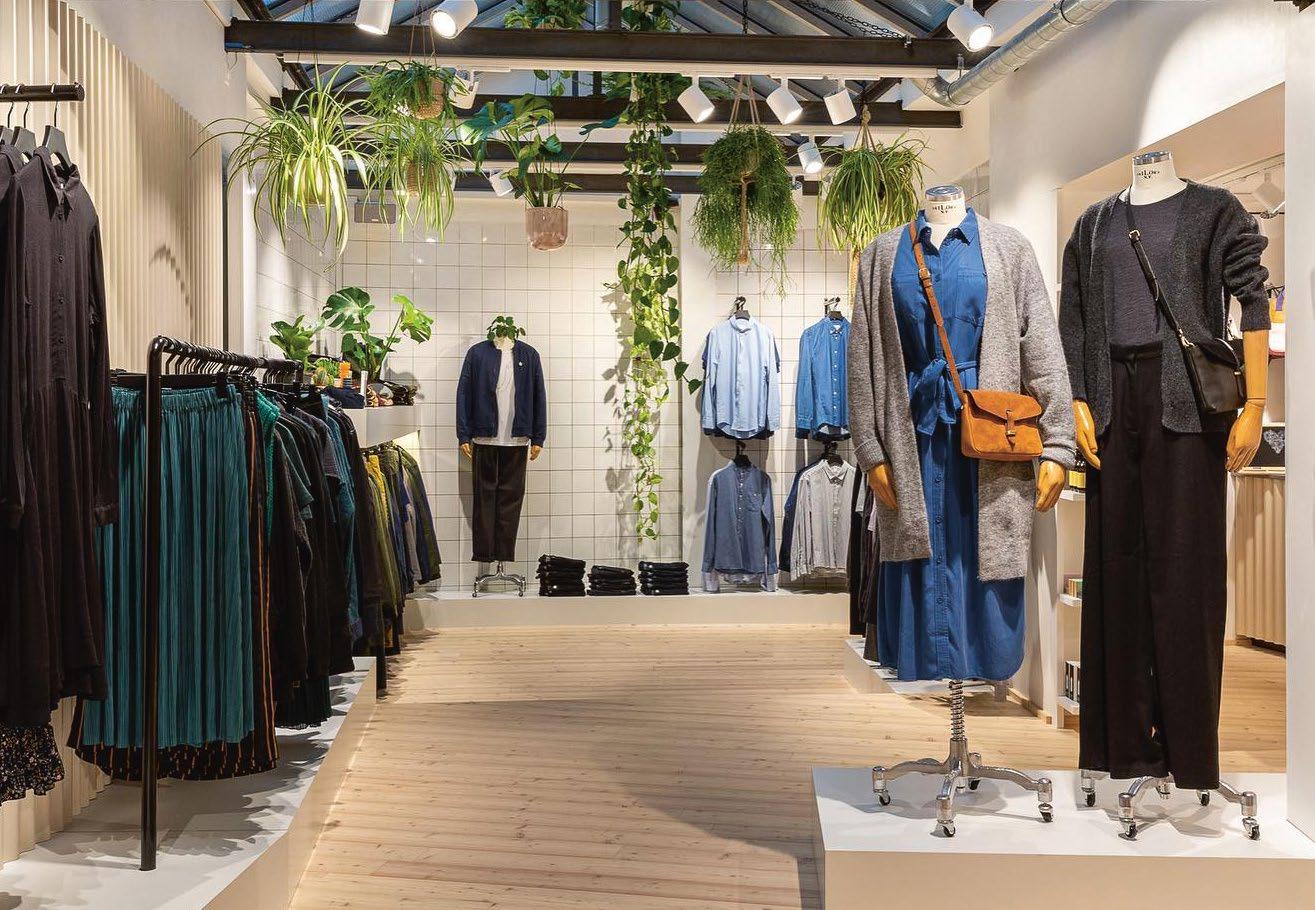

You will find 175 square metres of top-quality clothing brands, accessories and lifestyle products here, up-and-coming labels such as APC, Humanoid, Hannes Roether and Harris Wharf. Exclusivity is catered for, not just with the limited quantities on offer, but also with the golden changing rooms, where you can’t help but look glamorous.

13 BASEL MOMENTS
FEINFRACHT
Spalenberg 34 – feinfracht.com
Stetson Cap, Passion France-Messer oder Eat Dust-Jacke – hier findet Mann alles, was er für seinen Trip durch die Wildnis und den Kampf mit dem Bären braucht. Und überdies echtes Handwerk, Erfahrung und die Wertschätzung von Details. Was du hier einkaufst, ist ein Stück Geschichte, die bald schon zu deiner eigenen werden wird.
A Stetson cap, a Passion France knife or an Eat Dust jacket – men can find anything they want here for that trip into the wilderness and the wrestling match with a bear. Apart from that, genuine craftsmanship, experience and a delight in details. What you buy here is a piece of history, and one that will soon become part of your own story.
SET & SEKT
Rümelinsplatz 5 – setandsekt.com
Dieser architektonisch minimalistische Concept Store führt eine feine Auswahl an jungen sowie etablierten Designerinnen und Designern wie Dries van Noten, Issey Miyake, Totême oder Acne Studios. Das Angebot der Frauen- und Männermode wird von einer feinen Auswahl an Schuhen, Schmuck und Lederwaren ergänzt.

This architectonically minimalist Concept Store offers a fine selection of both young and well-established designers including Dries van Noten, Issey Miyake, Totême and Acne Studios. The range of fashion for men and women is complemented with a fine array of shoes, jewellery and leather goods.
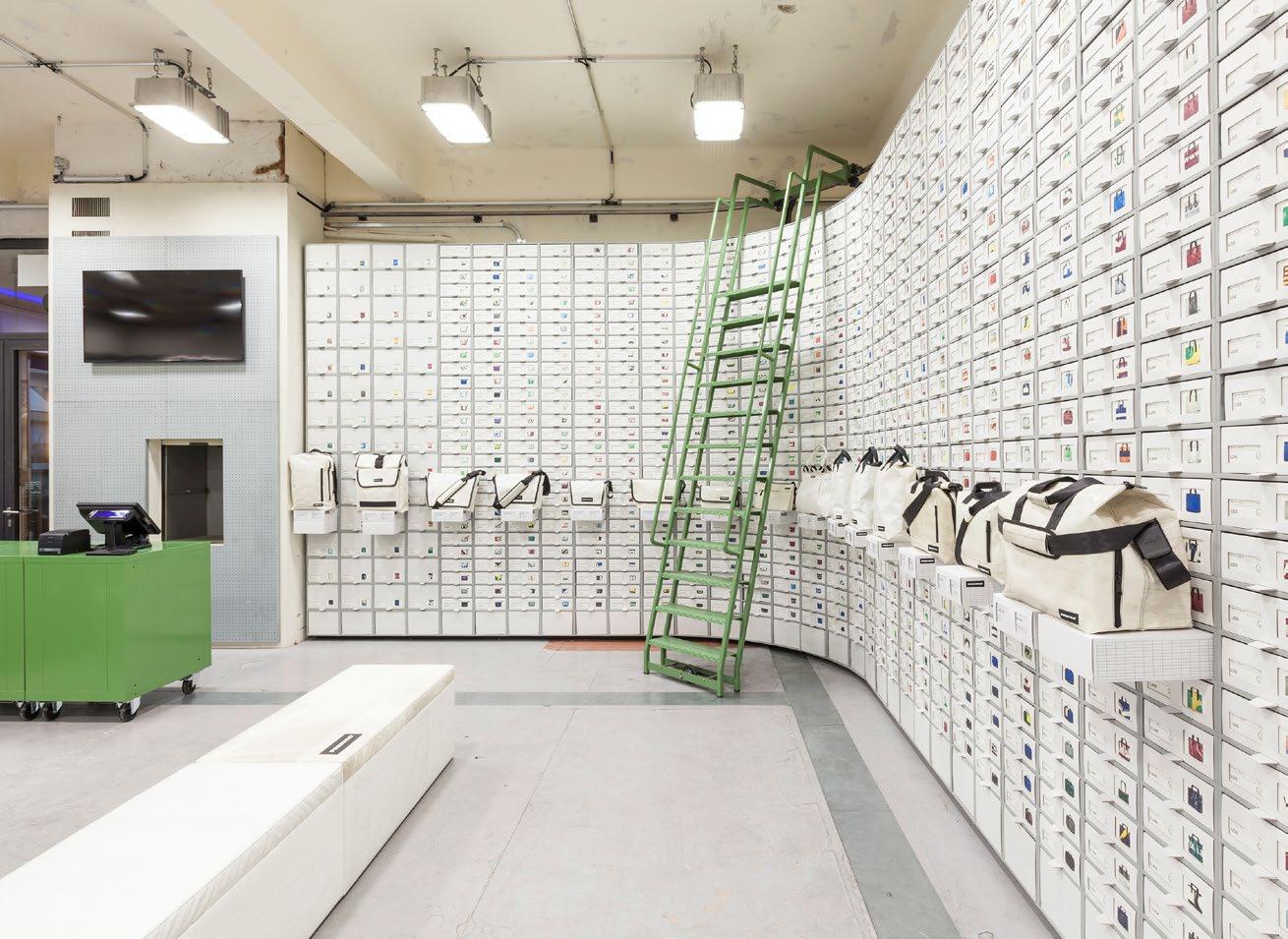

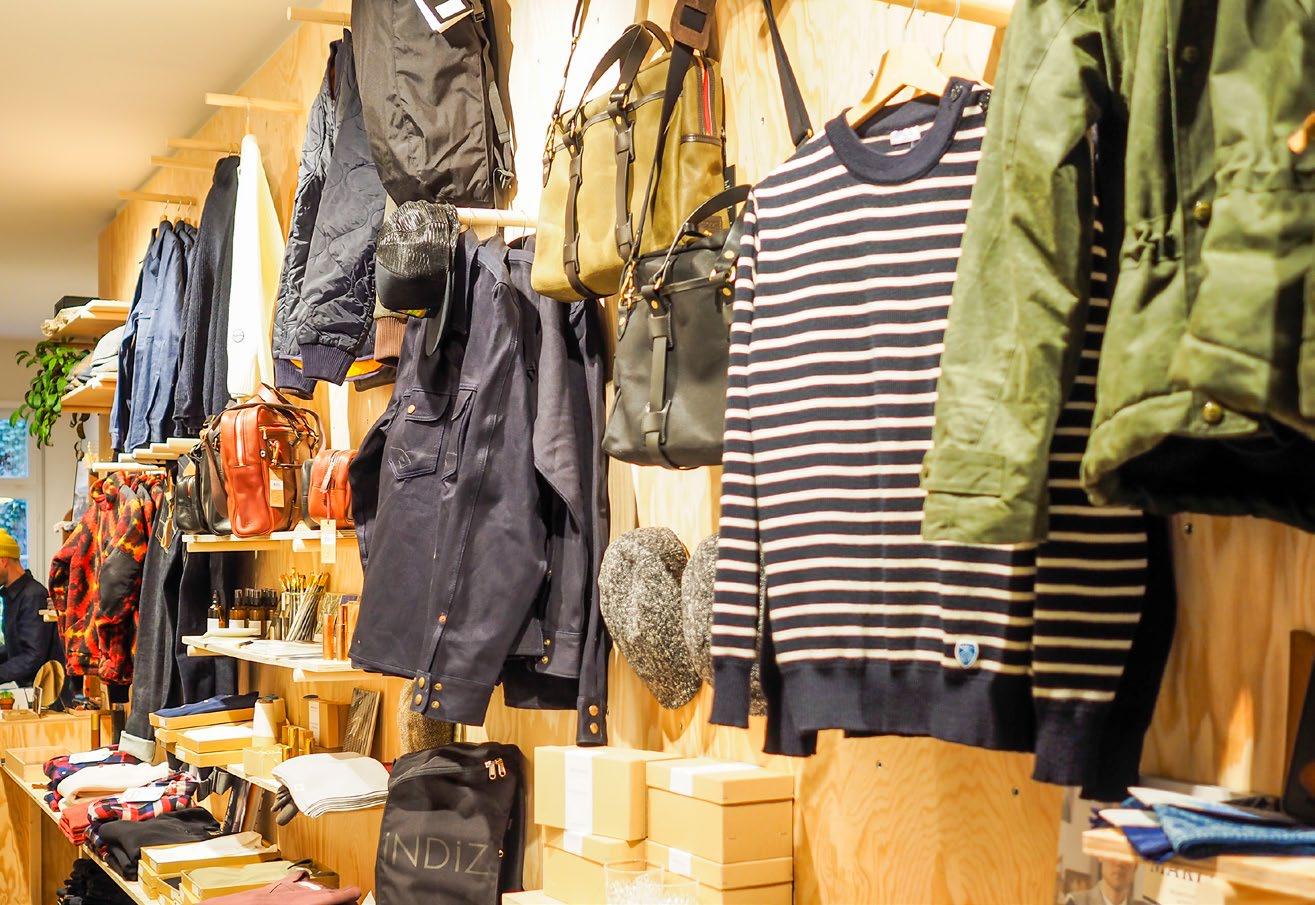
FREITAG
Grünpfahlgasse – freitag.ch
Bis ins MoMA New York hat es die 1993 in Zürich entwickelte Freitag-Tasche bereits gebracht – Kult! Die unikaten Rucksäcke, Handtaschen, Laptophüllen oder Portemonnaies aus gebrauchten LKW-Planen, Fahrradschläuchen und Autogurten sind bis heute ein Muss für urbane Individualisten.
They made it as far as the MoMA in New York, the Freitag bags, designed in Zurich in 1993 – cult! The unique rucksacks, handbags, laptop cases and wallets, fabricated from old truck tarpaulins, bicycle inner tubes and seat belts are still a must for urban individualists.
WICKY
Brunngässlein 6 – wickybasel.com
Mit Marken wie Forte Forte, Raquel Allegra, Ienki Ienki, N°21, Plan C, R13 oder Citizens of Humanity erleben Modefrettchen hier einen kunterbunten, exklusiven Shopping-Spass. Dazu gibts Drinks und Snacks, umfassende Beratung und gute Laune. Im Vorteil ist, wer gerne aus der Masse heraussticht – hier geschieht Fashion!
The fashion conscious will enjoy the colourful and exclusive shopping experience here, with brands such as Forte Forte, Raquel Allegra, Ienki Ienki, N°21, Plan C, R13 and Citizens of Humanity. There are also drinks and snacks available, plenty of advice and a good mood. Anyone who likes to stand out from the crowd is at an advantage here – because this is where fashion happens!
14 BASEL MOMENTS
LE ROI GOURMET
1 Übernachtung mit Rheinsicht inkl. Frühstück
Champagneraperitif an der Bar
• 6-Gang-Menu des Rois im Cheval Blanc by Peter Knogl, exkl. Getränke (3 Sterne im Guide Michelin, 19 GaultMillau-Punkte)
BaselCard (freie Benutzung des ÖV in Basel, 50 % auf Kultur- und Freizeitangebote) Ein Überraschungsgeschenk
River King Room ab CHF 745 pro Person
Erleben Sie, wie schön und intensiv Gaumenfreuden sein können.
Grand Hotel LES TROIS ROIS T +41 61 260 50 50 | info@lestroisrois.com www.lestroisrois.com

GEKOMMEN,
UM BARRIEREN ABZUBAUEN
Benedikt von Peter ist ein Macher. Der Theaterintendant hat 2020 die Intendanz in Basel übernommen und trotz Pandemiezeiten bereits einiges verändert. Er hat eine klare Vision von der Zukunft des Theaters und sehr viel Energie.
Text: Dominique Simonnot
Bilder: Janine Wagner
Dieser Mann ist, was er trinkt: schwarzer Kaffee. Und zwar eine starke Robustamischung – nichts für schwache Nerven. Belebend, anregend, stärkend. Gleichzeitig ist Benedikt von Peter mit 45 Jahren auch noch recht jung für einen Theaterintendanten, die Energiereserven vielleicht noch prall gefüllt. «Ich habe früh Karriere gemacht, war mit 26 Jahren schon Regisseur», erinnert er sich. «Irgendwie ging alles sehr schnell.» Die Theaterintendanz ist also die logische Konsequenz seiner Karriere – gepaart mit seinem Wunsch nach mehr Sesshaftigkeit, denn bis vor acht Jahren war er als freiberuflicher Regisseur noch viel unterwegs. Freuen wir uns, dass er diesen Schritt in der Schweiz gemacht hat – erst in Luzern, nun in Basel. Denn er hat viel vor.
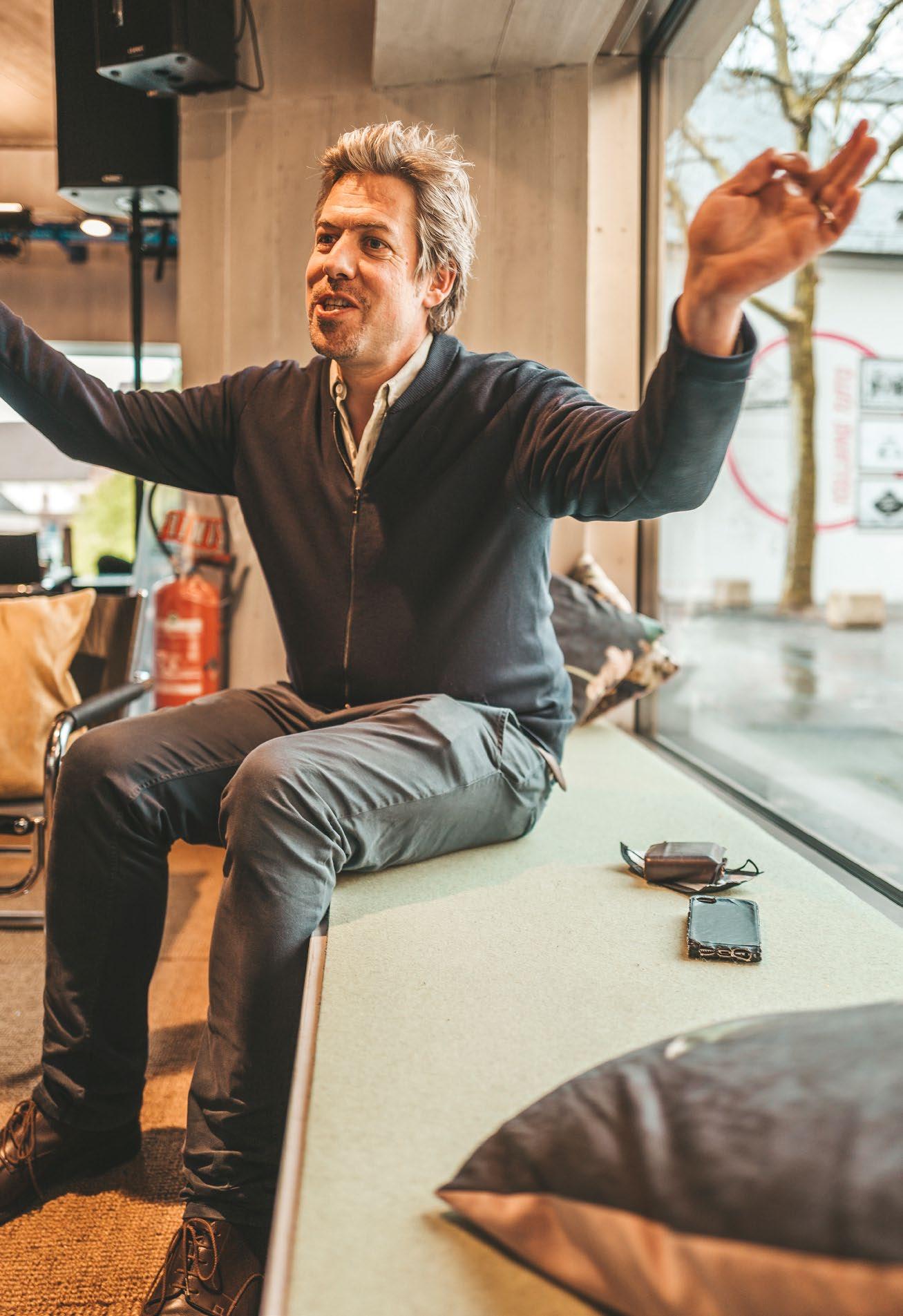
Das Foyer
als Begegnungsort
Wir sitzen im gemütlichen Theatercafé, das Teil des Foyer Public ist. Seit rund einem Jahr dient das Foyer nun schon als erweiterter Stadtraum und somit als Begegnungsort zwischen Theaterschaffenden und der Bevölkerung. Im Foyer Public trifft man sich mittlerweile zum Arbeiten, Diskutieren, Lesen, Spielen, Tanzen oder Chillen. Chillen ist für uns die nächste Dreiviertelstunde nicht angesagt, denn für Benedikt von Peter braucht es höchste Aufmerk samkeit. Zeit für Abschweifungen bleibt kaum, denn die 45 Minuten sind strikt gesetzt. Überhaupt wirkt alles sehr durchgetaktet in dem Leben des jungen Intendanten. Freizeit? Geniesst er am liebsten mit seiner Frau und seinem kleinen Sohn. «Da kann ich am besten abschalten, ebenso bei guten Gesprächen mit Freunden.» Abschalten im sozialen Umfeld. Allerdings bleibt bei Arbeitstagen von 16 bis 17 Stunden gar nicht viel Freizeit. Dazu kommen zahlreiche Abende, an denen er im Theater sein muss.
16 BASEL MOMENTS
«Die Arbeit am Theater ist oft nicht sehr familien freundlich, das bringt die Struktur einfach mit sich», erklärt er. «Allerdings entwickelt sich auch das Theater und man achtet immer mehr darauf, das Familienleben möglich zu machen.» Vielleicht ist diese Unvereinbarkeit auch ein Grund, weshalb Benedikt von Peter mehr Kinder ins Theater holen möchte – auf die Bühne und ins Publikum.
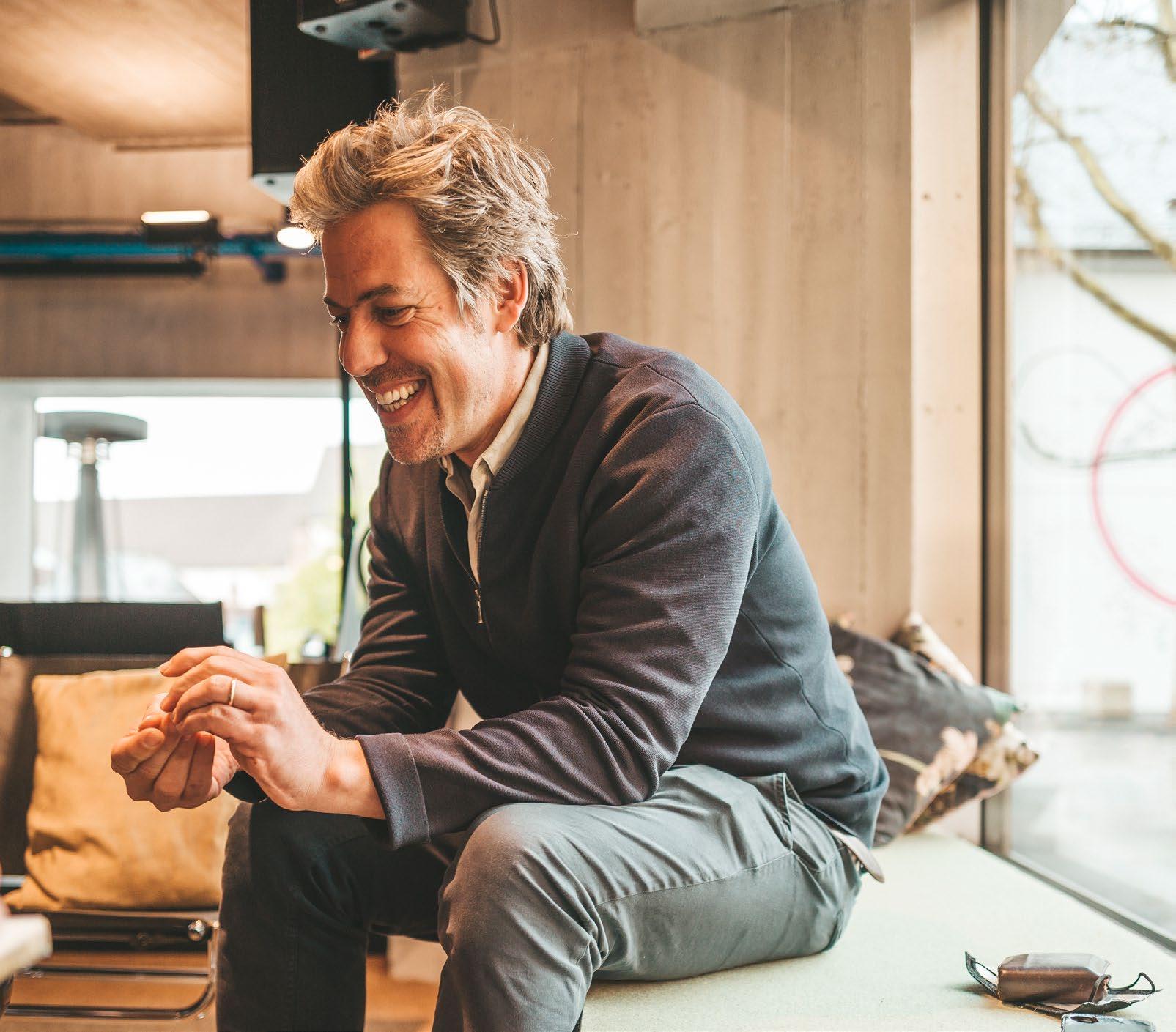
Die Kraft der Kinder Mit der von ihm inszenierten Matthäus-Passion lässt er erstmals eine Gruppe von Kindern die Passion von Johann Sebastian Bach nachspielen. Oper bzw. Oratorium und Kinder, passt das über haupt zusammen? «Sogar sehr gut, wenn die Musik schön ist. Und über den Gesang lassen sich Emotionen transportieren, die Szenen erklären sich fast von selbst», weiss der Intendant aus seiner Erfahrung mit der Zusammenarbeit mit den Kindern. «Zudem sind die Geschichte vom Leiden und Sterben Christi sowie die damit ver bunden Werte bekannt und somit auch schnell erzählt. Viel schwerer war die Umsetzung dieses aufwendigen Projektes.» Das Engagement der Kinder überraschte dabei selbst den erfahrenen Profi: «Es ist erstaunlich, was die Kinder da auf der Bühne zeigen, insbesondere der Kinderchor, denn das Oratorium ist nicht leicht zu singen. Und die Proben während der Pandemiezeit waren für alle herausfordernd.» In der Regel führt die Teilnahme von Kindern auf der Bühne auch zu mehr Kindern im Publikum, auch wenn bei der Oper die Hemm schwelle noch immer höherliegen dürfte als beim Schauspiel und Ballett. Doch Benedikt von Peter empfiehlt, Kinder einfach mal mit in eine Oper zu nehmen. Es muss ja nicht gleich Richard Wagner sein». Zum Einstieg – insbesondere für jüngere Kinder – eignen sich Produktionen wie zum Bei spiel die Oper Trallalali Trallalala!, die seit dem 10. Juni auf der kleinen Bühne des Theater Basel zu sehen ist. Sie ist mit Kindern zusammen entstanden und dauert nur eine Stunde.

BASEL MOMENTS
«Um uns herum gibt es eine aussergewöhnliche Dichte an Kulturinstitutionen, gemütlichen Cafés und eine ideale Anbindung.»
Zugang zum Theater vereinfachen Doch nicht nur Kinder sollen mehr Gefallen an der Oper im Speziellen und am Theaterangebot im Allgemeinen finden. Benedikt von Peter möchte das Theater einer breiteren Bevölkerungsschicht zugänglich machen, das Publikum soll heterogener werden. Mit seiner Idee des Foyer Public ist ihm ein wichtiger erster Schritt gelungen. «Die Lage des Theaters war dabei entscheidend, denn um uns herum gibt es eine aussergewöhnliche Dichte an Kulturinstitutionen, gemütlichen Cafés und eine ideale Anbindung», schwärmt Benedikt von Peter. «Ziel ist es, dass die Leute nicht einfach vorbeilaufen, sondern sich überwinden, die Institutionen kennenzulernen.» Man merkt, wie wichtig ihm Dialog und Austausch istauch mit den umliegenden Kulturhäusern. «Ich möchte peer-groups zusammenbringen, verschiedene Generationen, unterschiedliche Interessengruppen.

Bei Sport, Spiel, Diskussionen oder sonstigen Begegnungen.» So wie bereits beim Digital Café von Pro Senectute, das regelmässig im Foyer stattfindet. Studenten helfen dann älteren Personen bei Fragen rund um digitale Anwendungen. Der Kaffee: nicht nur Energielieferant, sondern auch Eisbrecher.
THEATER BASEL
 Theatertrasse 7 – theater-basel.ch
Theatertrasse 7 – theater-basel.ch
18 BASEL MOMENTS
Benedikt von Peter is a man of action. He took over as theatre director in Basel in 2020 and has already made a lot of changes despite the pandemic. He has a clear vision for the theatre’s future and a great deal of energy.
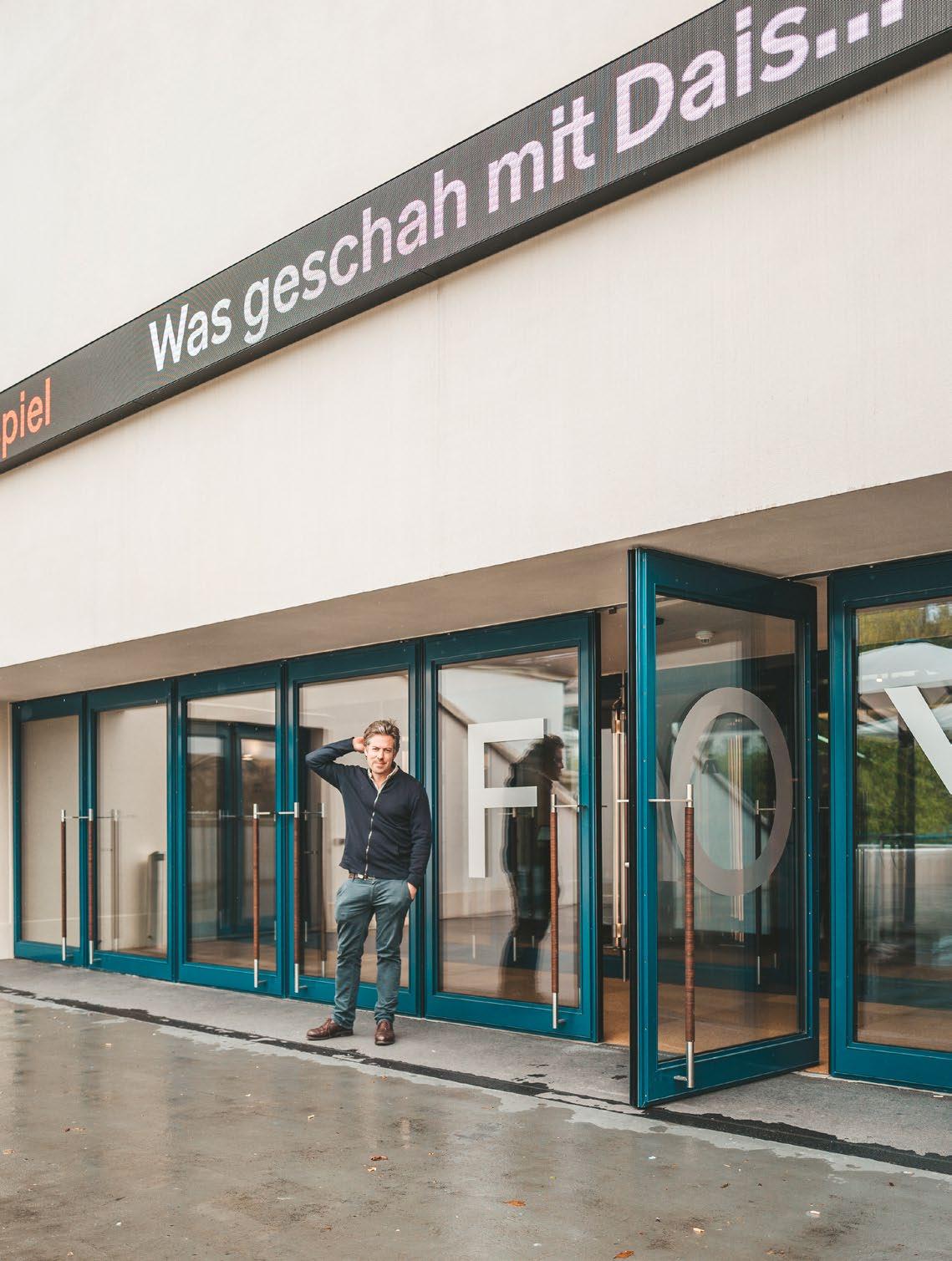
This man is what he drinks: black coffee. And a strong Robusta blend to boot – not for the faint-hearted. Energising, stimulating, empowering. At the age of 45, Benedikt von Peter is also quite young to be a theatre director, his reserves of energy still bursting. “I started my career early, and I was already a director by the time I was 26 years old”, he recalls. “Everything happened very quickly somehow or other.” So the directorship of the theatre is a logical consequence of his career – coupled with his wish for a more settled lifestyle, because until eight years ago he was a freelance director and therefore on the road a lot. And we can be happy that he made this move to Switzerland – first to Lucerne, and now to Basel. Because he has a lot of plans.
The foyer as a place for encounters
We are sitting in the comfortable theatre café, which is part of the Foyer Public. For about a year now, the foyer has been used as an addition to the city’s public spaces and thus also as a place where theatre professionals and the general public can meet. In the meanwhile, people have started to meet in the Foyer Public to work, discuss, read, play, dance or just chill. However, chilling out is not what we’ll be doing for the next three quarters of an hour, because with Benedikt von Peter you need to pay the utmost attention. There is scarcely any time for digressions, because the 45 minutes are strictly arranged. And in fact, everything in the life of this young theatre director seems to be jam-packed. His free time? He loves to spend it with his wife and young son. “That’s when I feel the most relaxed, that or when I’m having a good conversation with friends.” Relaxing in his social environment. But with working days lasting 16 – 17 hours, there’s not that much free time available. Then there are the many evenings when he has to be at the theatre. “Working in theatre is often not very family-friendly, that is just how it is structured”, he explains. “Mind you, the theatre world is developing too and more and more attention is being paid to making family life possible.” This incompatibility may be one of the reasons Benedikt von Peter wants to entice more children into the theatre – on stage and in the audience.
The power of children
The St. Matthew Passion that he staged was the first time there was a group of children re-enacting the Passion composed by Johann Sebastian Bach. Opera, or rather an oratorio and children, is that a good combination? “A very good one actually, if the music is beautiful. And emotions can be conveyed through singing, so that the scenes are almost self-explanatory”, as the director knows from his experience of working with those children. “What’s more, the stories of the suffering and death of Christ and the virtues associated with them are familiar and therefore quickly told. It was the realisation of this elaborate project that was much more difficult.” The children’s dedication surprised even this experienced professional: “It is amazing what the children managed up there on the stage, especially the children’s choir, because the oratorio is not easy to sing. And the rehearsals during the pandemic were a challenge for everyone.” On the whole, there tend to be more children in the audience when there are children on stage, although the psychological barrier for taking them to the opera is still higher than for drama or ballet. Benedikt von Peter recommends just taking children along to the opera. “It doesn’t have to be Richard Wagner.” As a start – particularly for young children – productions like the Trallalali Trallalala! opera which has been playing on the small stage since 10 June are particularly suitable for younger children. It was developed together with the children and only lasts an hour.

Making theatre more easily accessible
But it is not just the children whom he is hoping will discover the pleasures of opera in particular, and what the theatre has to offer in general. Benedikt von Peter wants to open theatre up to a wider segment of the general population, so that the audience becomes more mixed. His concept for the Foyer Public is the first important step he has taken in that direction. “The theatre’s location was crucial to this decision, because all around us there is an incredibly dense network of cultural institutions, welcoming cafés and ideal accessibility”, enthuses Benedikt von Peter. “The aim is that people don’t just wander past, but overcome their inhibitions and get to know these institutions.” It is very clear how important dialogue and interaction are to him – with the other cultural institutions nearby as well. “I want to bring different peer groups together, different generations, different interests. With sport, games, discussions or other types of encounters.” As is already the case with the Digital Café arranged by Pro Senectute, which takes place regularly in the foyer. Students help elderly people with their queries about digital applications. Coffee, not just a source of energy, but also an icebreaker.
19 BASEL MOMENTS
COME TO BREAK DOWN BARRIERS
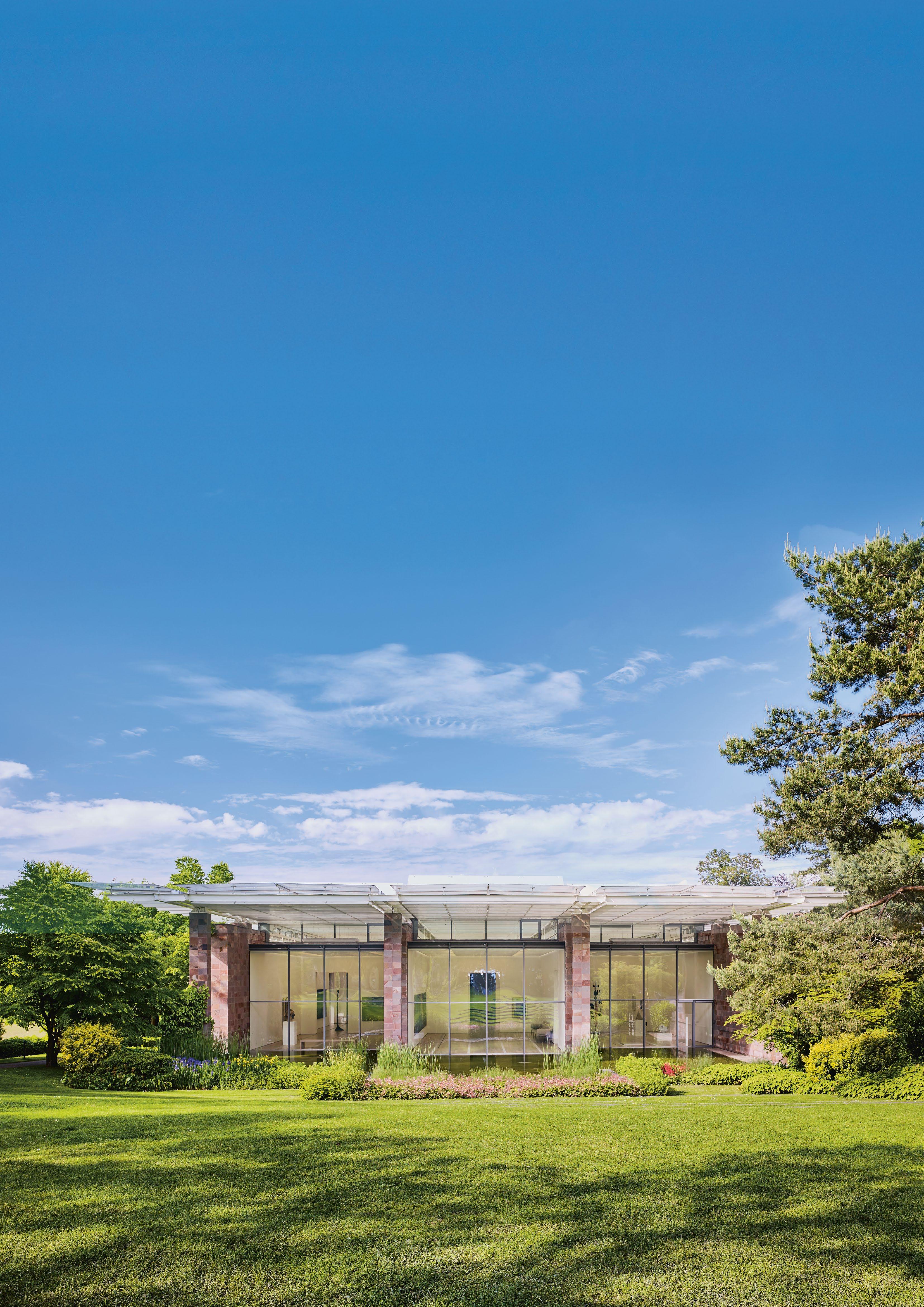
FONDATION BEYELER RIEHEN / BASEL KUNST ARCHITEKTUR NATUR MONET CÉZANNE PICASSO GIACOMETTI ROTHKO WARHOL BOURGEOIS SERRA RICHTER DUMAS
Photo: Mark Niedermann
DIE GUTEN SEELEN
AUF DEM RHEIN
Vier Fähren verbinden das Kleinbasel mit dem Grossbasel. Das sind vier völlig unterschiedliche Blickwinkel auf die Stadt, die dir auf jeder Fähre ein anderes Gesicht zeigt. Die Fährimänner und Fährifrauen begleiten dich dabei sicher von der einen Rheinseite auf die andere. Sie sind der Charakter und die guten Seelen der vier Basler Fähren und tragen Sorge zu einer der schönsten Traditionen und Wahrzeichen Basels.
Text & Bilder: Nicola Mathis
Bitte keine Hektik!
Wer heute den Rhein überqueren will und es eilig hat, wird dafür kaum die vier Basler Fähren benutzen. Schneller gehts über die Brücke. Zu Fuss, per Tram, Bus oder Velo. Nein, wer heute mit der Fähre zwischen Kleinbasel und Grossbasel hin- und herschaukelt, macht das aus einer sehr bewussten Entscheidung heraus. Eine Entscheidung für die Entschleuni gung, die Ruhe und den Ausbruch aus dem stressigen Alltag. Mit dem Schritt vom sicheren Fährensteg auf die den Launen des fliessenden Rheins ausgesetzte Fähre begibst du dich auf ein kleines Abenteuer. Eines, das zwar nur wenige Minuten andauert, aber die Stadt und ihre Geschichte auf beispiellose Weise spüren lässt. In dieser Stadtgeschichte nehmen auch die Fähren einen wichtigen Teil ein. Als sogenannte «fliegende Brücken» sollten sie einst dem Brückenmangel in Basel entgegenwirken. Denn lange war die Mittlere Brücke die einzige Brücke, um die Stadt überqueren zu können.
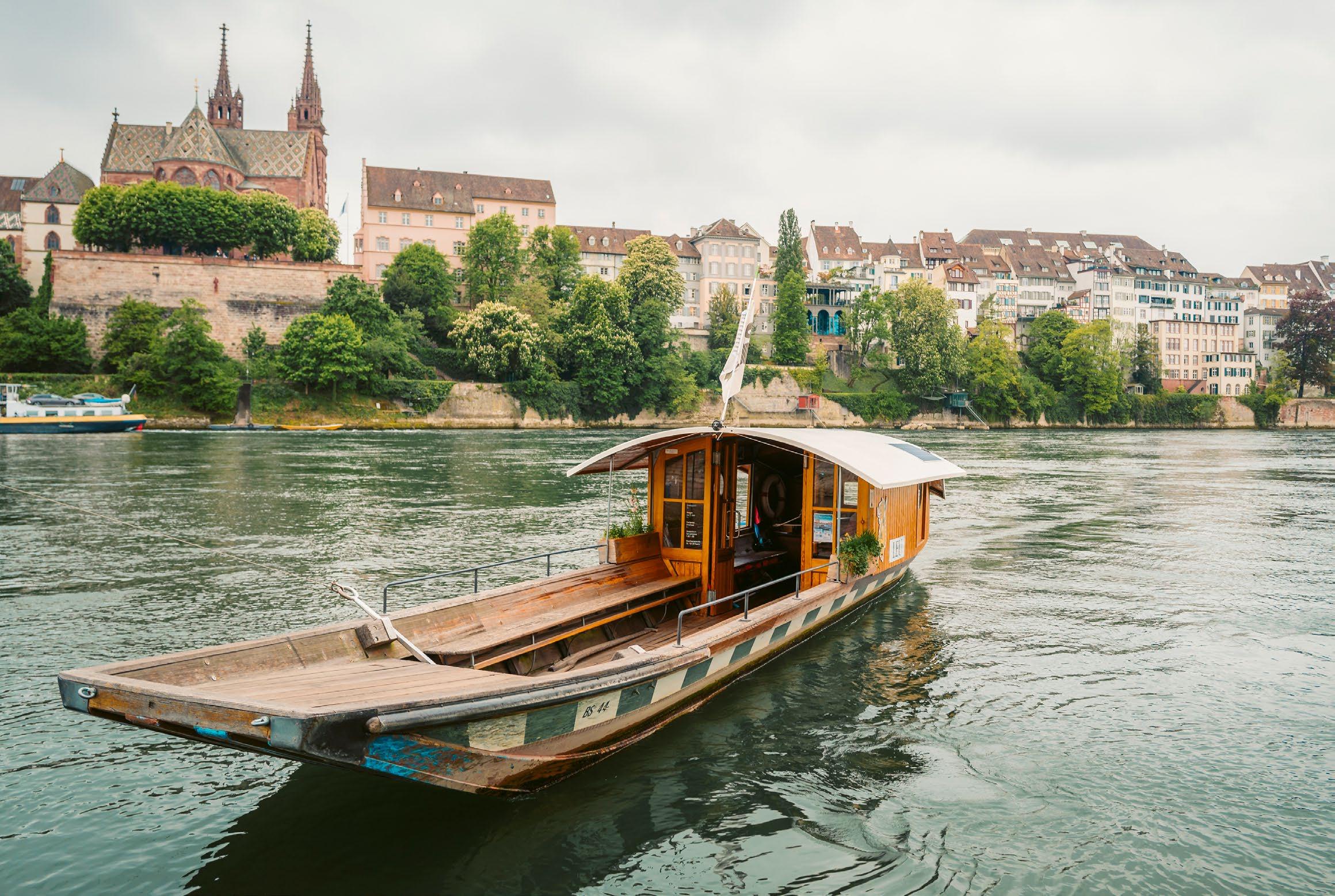
21 BASEL MOMENTS
ST. JOHANN-FÄHRE (UELI)
RÉMY WIRZ
Was braucht es, um ein guter Fährimaa zu sein?
Rémy: Liebe. Denn ganz egal, was man macht: Wenn man etwas gut machen möchte, braucht es immer Liebe.
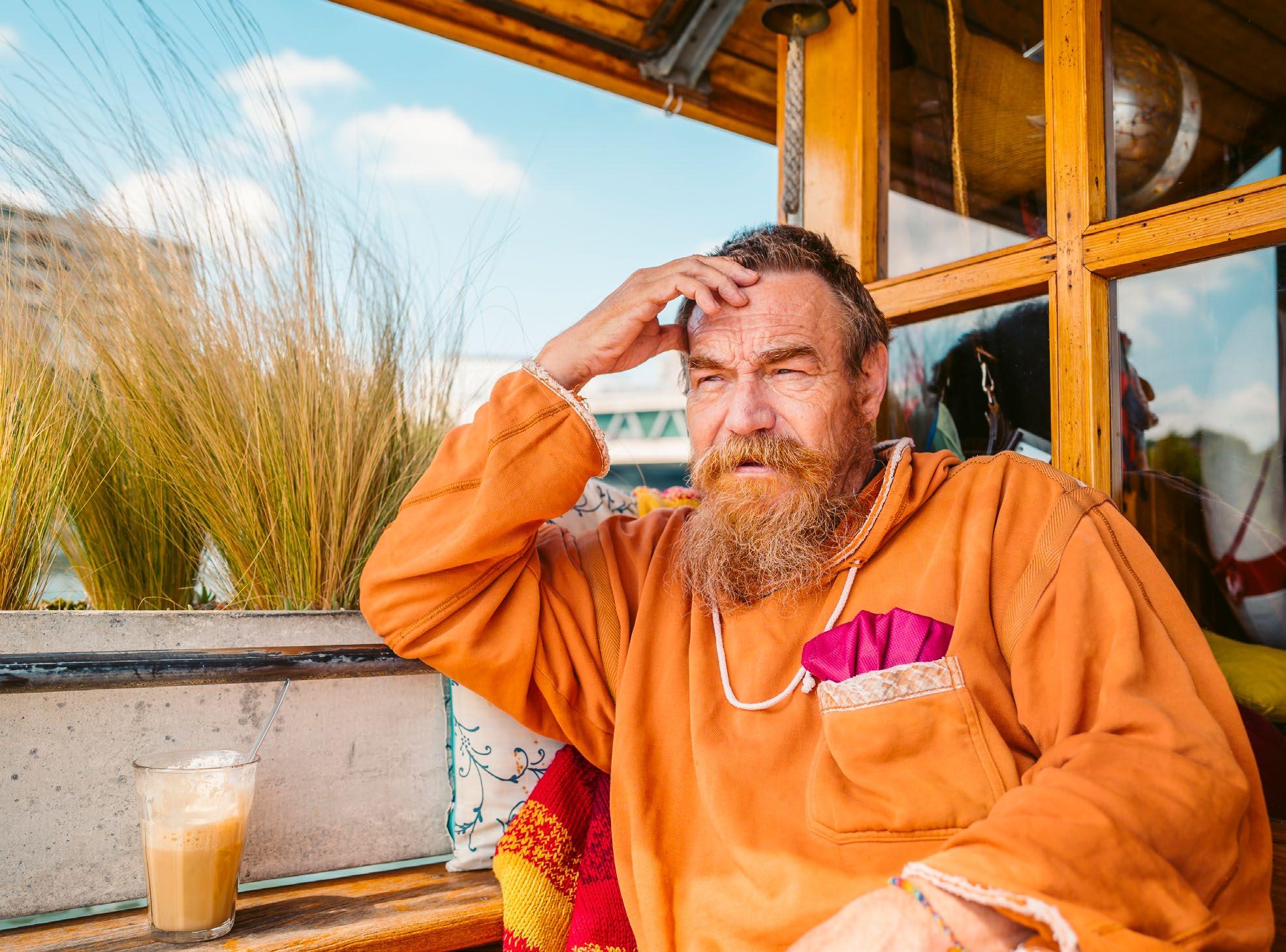
Wieso bist du am liebsten auf dieser Fähri und nicht auf einer anderen unterwegs?
Rémy: Es sind zwei tolle Quartiere mit tollen Menschen, die ich hier verbinde. Jeweils im Sommer findet oben auf der Dreirosenbrücke die traditionelle Wasserschlacht statt. 4056 gegen 4057 – das ist immer ein Spektakel.
Was war dein schönstes Erlebnis auf deiner Fähri?
Rémy: Anfang 80er-Jahre habe ich im tiefsten Winter eine alte Frau aus dem Rhein gerettet. Ich erinnere mich vor allem an diesen wachen Zustand in diesem Moment. Einerseits voller Energie und andererseits ganz ruhig und entspannt. Es war ein Gefühl, mit dem ganzen Universum und überhaupt mit der ganzen Existenz verbunden zu sein – und genau zu wissen, was zu tun ist.
Beende folgenden Satz: Der Blick von meiner Fähri auf Basel ist besonders schön, …

Rémy: … weil man nicht mitten in der Stadt ist und trotzdem ein wunderbares Stadtbild zu sehen kriegt. Abgesehen vom neuen Baloise-Hochhaus … liebe Stadtbildkommission!
Zu welcher Tageszeit bist du am liebsten auf der Fähri unterwegs?
Rémy: Ich bin gerne abends unterwegs, vor allem im Sommer. Ich mag das Nachtpublikum. Manchmal kommts dann auch zu kleinen, spontanen Konzerten auf der Fähri. Das macht einen Sommer-Abend auf der Fähri dann schon sehr besonders.
22 BASEL MOMENTS
Rémy Wirz
Fliegende Brücken für den guten Zweck Den Grundstein für die Tradition der Basler Fähren legte 1853 die Birsfel der Fähre auf der Höhe des Birskopfs. Nur ein Jahr später wurde 1854 mit der Harzgrabenfähre die erste städtische Fähre eingeweiht – am Standort der heutigen Wettsteinbrücke. Die Konzession dafür besass die Basler Künstlergesellschaft, eine Vereinigung von Künstlern und Kunstfreunden zur Förderung und Bekanntmachung der lokalen Kunstszene und ihren Arbeiten. Die hohe Nachfrage und die gute Rentabilität der Harzgraben fähre bewegte die Basler Künstlergesellschaft dazu, eine zweite Fähre zu realisieren. So wurde 1862 zwischen dem Grossbasler Totentanz und der Kleinbasler Kaserne mit der Totentanz-Fähre – der heutigen Klingen tal-Fähre – die zweite «fliegende Brücke» Basels eingeweiht. Damit erreichte die Basler Künstlergesellschaft dann auch ihr Ziel, eine Institution für Ausstellungen und Zusammenkünfte der lokalen Kunstszene zu erschaffen und konnte mit dem erwirtschafteten Gewinn die Kunsthalle Basel realisieren.
Mit dem Bau der Harzgrabenbrücke 1877 – der heutigen Wettsteinbrücke – wurde die erste Basler Fähre, die Harzgrabenfähre, aber wieder eingelagert. Ein neuer Standort wurde gesucht und auf der Höhe des Basler Münsters gefunden – der heutigen Münster-Fähre. Mit der fortlau fenden Ausdehnung der Bevölkerung in die Quartiere wuchs der Wunsch nach weiteren Fähren, um die Quartiere beidseitiger Rheinufer miteinan der zu verbinden. So kam 1894 die St. Alban-Fähre zwischen St. Alban und Schaffhauserrheinweg dazu und 1895 die Schlachthoffähre zwischen St. Johann und Klybeck – heute St. Johann-Fähre genannt.
Erst viel später sollten die Basler Fähren originelle Namen erhalten. Die Idee, die Fähren nach den Ehrenzeichen der Kleinbasler Ehrengesellschaf ten und dem Ueli zu taufen, überzeugte und so wurde 1944 im Rahmen eines langen Festzugs entlang dem Basler Rheinufer eine Fähre nach der anderen feierlich auf die Namen «Vogel Gryff», «Leu», «Wild Maa» und «Ueli» getauft. Unter diesen Namen sind sie auch heute eingefleischten Baslerinnen und Baslern bekannt.
Wieso bist du am liebsten auf dieser Fähri und nicht auf einer anderen unterwegs?
Urs: Auf dieser Fähri war schon mein Vater der Fährimaa – deshalb ist es auch meine Traumfähri.
Was war dein schönstes Erlebnis auf deiner Fähri?
Urs: An der Fasnacht vor ein paar Jahren hat die Bajass-Clique den Morgestraich um 4 Uhr morgens bei mir auf der Fähri gepfiffen. Mitten auf dem Rhein. Das war Gänsehaut pur.
Beende folgenden Satz: Der Blick von meiner Fähri auf Basel ist besonders schön, …

Urs: … wenn am Morgen die Sonne aufgeht. Oder abends, wenn sie untergeht.
Welche Gedanken machst du dir über Basel, wenn du ganz alleine auf deiner Fähri unterwegs bist?
Urs: Wie schön doch Basel ist – und dass ich hier den schönsten Beruf habe.
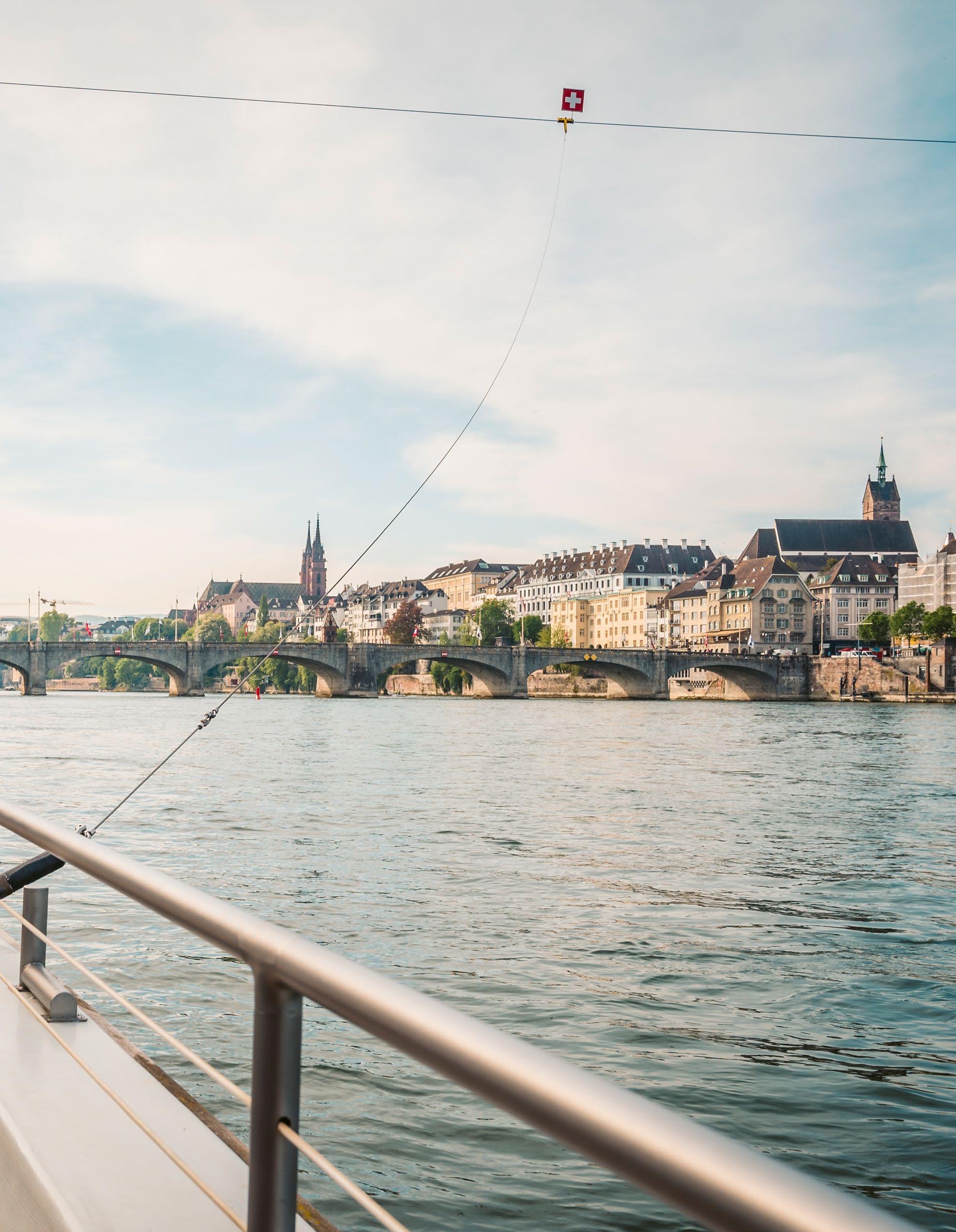
KLINGENTAL-FÄHRE (VOGEL GRYFF) URS ZIMMERLI
23
MOMENTS
BASEL
Urs Zimmerli
ALBAN-FÄHRE (WILD MAA) ROSI TIEFENTHAL & HAMBBE TSCHUDI
Was braucht es, um ein guter Fährimaa/ eine gute Fährifrau zu sein?
Rosi & Hambbe: Es braucht Verbundenheit mit der Stadt Basel, Freude am Kontakt und Umgang mit Menschen aus Basel, der Schweiz und der ganzen Welt. Zu guter Letzt braucht es Liebe zum Wasser – speziell zu unserem «Bach».


Was macht den Alltag als Fährimaa/Fährifrau spannend?
Rosi & Hambbe: Man weiss nie, was einem erwartet. Viele tolle Menschen, mit welchen man zum Teil auch spannende Geschichten austauschen kann. Aber natürlich auch die Elemente. Der Umgang mit den stets wechselnden Verhältnissen auf dem Rhein – vom Niederwasser bis zum Hochwasser und den damit verbundenen Herausforderungen.
Was war euer schönstes Erlebnis auf eurer Fähri?
Rosi & Hambbe: Unser erster gemeinsamer Tag als Pächter-Duo am 1. Januar 2021. Einerseits ist Rosi die erste Frau, welche eine Pacht von einer der vier Basler Fähren übernehmen durfte. Andererseits sind wir das erste Pächter-Duo, welches eine Fähre im Job-Sharing übernehmen konnte.
Weshalb sollte die Tradition der Fähri immer erhalten bleiben?
Rosi & Hambbe: Weil die Basler Fähren zur Geschichte unserer Stadt gehören und das Stadtbild bereichern. Zudem sind gerade heute die Basler Fähren «en vogue» –gleiten sie doch fast lautlos über den Rhein und erzeugen keinerlei CO2-Emissionen. Zudem ist eine Fahrt mit einer Fähre für viele Menschen ein Augenblick im Alltag, welcher ein Entspannen und ein Sich-gehen-lassen erlaubt.
Welche Gedanken macht ihr euch über Basel, wenn ihr ganz alleine auf eurer Fähri unterwegs seid?
Rosi & Hambbe: Das Privileg zu haben, in der schönsten Stadt, unserer Heimat, der schönsten Berufung nachgehen zu dürfen: Fährifrau respektive Fährimaa zu sein!
Bitte keine schwimmenden Reklamen! Rentabel sind die Basler Fähren nun schon lange nicht mehr. Mit dem Bau weiterer Rhein brücken sowie den zunehmenden Möglichkeiten der Mobilität kam es bald zu massiven Umsatzeinbussen. So wurden die vier Fähren von der Basler Künstlergesellschaft erst an ihre aktuellen Pächter verkauft und gingen später in den Besitz einer Stiftung über. Denn als zu Beginn der 1970er-Jahre der Pächter der Klingental-Fähre seine Fähre aus Altersgründen verkaufen wollte und diese von einem internationalen Getränke konzern übernommen werden sollte, drohte die Kommerzialisierung der Basler Fähren. Aus diesem Grund – und um die Fähren für die Allgemeinheit zu bewahren – wurde die heutige «Stiftung Basler Fähren» gegründet, die gemein sam mit dem «Fähri-Verein Basel» dafür sorgt, dass genügend finanzielle Mittel aufgetrieben werden können, um den defizitären Fährbetrieb für weitere Generationen am Leben zu erhalten.
24 BASEL MOMENTS
ST.
Rosi Tiefenthal & Hambbe Tschudi
Was war dein schönstes Erlebnis auf deiner Fähri?
Sabine: Bei einer Beisetzung als stille Beobachterin so nahe dabei sein zu dürfen, ist jedes Mal ein berüh render Moment für mich. Diese besondere Zeit der Verwandlung eines Menschen gehört zum Leben wie die Geburt – ein immerwährendes Gehen und Kommen, von der Quelle zur Mündung, von der Mündung zur Quelle. Der Rhein macht es uns unmissverständlich vor.
Weshalb sollte die Tradition der Fähri immer erhalten bleiben?
Sabine: Die Fährifahrt schenkt den Menschen eine kleine Auszeit. Fliessendes Wasser ist hautnah erlebbar, ein Begegnungspunkt und Ruhepol, mitten in der Stadt – in diesen bewegten Zeiten eine willkommene Gabe.

Beende folgenden Satz: Der Blick von meiner Fähri auf Basel ist besonders schön, …
Sabine: … wenn ein Schneesturm unterwegs ist.

BASEL MOMENTS
Sabine Matejicek
MÜNSTER-FÄHRE (LEU) SABINE MATEJICEK
THE GOOD-HEARTED SOULS ON THE RHINE
Four ferries connect the two halves of the city, Kleinbasel and Grossbasel. You get four completely different perspectives of the city, which reveals itself from a different angle on each ferry. The ferrymen and ferrywomen take you safely from one side of the river to the other. They are the personalities and good-hearted souls of the four Basel ferries, and they maintain one of the loveliest traditions and emblems of Basel.
No rush!
Nowadays, anyone who wants to cross the Rhine quickly will almost certainly not take one of the four ferries. It’s quicker to cross the bridge. On foot, by tram, bus or bike. No, the people who rock gently to-and-fro between Kleinbasel and Grossbasel on the ferry, have decided to do so quite deliberately. They have chosen to slow down and peacefully escape the hectic of everyday life. When you take that step from the safety of the wooden pier onto the ferry, exposed to the vagaries of the flowing river, you are setting off on a little adventure. One that only lasts a few minutes, it's true, but you do experience the city and its history in a truly unique manner in those brief moments. And the ferries themselves have played an important role in the city’s history. Once known as the “flying bridges”, they made up for the lack of actual bridges in Basel. Because for a long time, the Mittlere Brücke was the only bridge in the city.
Flying bridges for a good cause
In 1853, the foundations for the tradition of Basel’s ferries were laid by the Birsfelden ferry, which crossed where the river Birs flows into the Rhine (Birskopf). Only one year later in 1854, the first city ferry, the Harzgraben ferry, was inaugurated at the site of what is now the Wettstein bridge. The permit for this ferry was held by the Basel Künstlergesellschaft, an association of artists and art lovers founded to promote and publicise the local art scene and its works. The Harzgraben ferry was so popular and profitable that the Basel Association of Artists decided to arrange a second ferry. So, in 1862, the second flying bridge within the city was inaugurated: the Totentanz ferry – now the Klingental ferry – between the “Totentanz” (danse macabre) on the Grossbasel side and the Kaserne (barracks) on the Kleinbasel side. This allowed the Basel Association of Artists to achieve their goal of establishing an institution for exhibitions and gatherings of the local art scene; the profits from the ferries were used to cons-truct the Basel Kunsthalle (public art gallery).
However, in 1877, the first Basel ferry, the Harzgraben ferry had to be put into storage due to the construction of the Harzgraben bridge – now the Wettstein bridge. A new location was sought and found near Basel Münster, the cathedral – which is still known as the Münster ferry these days. As the population in the various neighbourhoods of Basel continued to grow, so did the wish for more ferries to connect the neighbourhoods on either side of the Rhine. So, in 1894, the St. Alban ferry between the St. Alban and the Schaff hauserrheinweg was added, then in 1895 the Schlachthof ferry between St. Johann and Klybeck – now known as the St. Johann ferry.
The Basel ferries were only christened with inventive names quite some time later. Calling them after the heraldic figures of the Klein Basel Honourable Societies and the Ueli was considered a good idea, and so, in 1944, a long procession along the banks of the Rhine was organised, during which one ferry after the other was solemnly baptised with the names “Vogel Gryff”, “Leu”, “Wild Maa” und “Ueli”. And they are still known by these names by the inveterate people of Basel.
What does it take to be a good ferryman?
Rémy: Love. Because it doesn’t matter what you do: if you want to do it well, you have to do it with love.
Why do you like being on this ferry more than any of the others?
Rémy: I am the link here between two great neighbourhoods with great people. Each summer up there on the Dreirosen bridge there is a traditional water fight between the two sides. Postcode 4056 against 4057 – that is always quite a spectacle.
What’s the best thing that has ever happened to you on the ferry?

Rémy: At the beginning of the 1980s, in the middle of winter, I rescued an old lady out of the Rhine. My clearest memory is of how very awake I was at that moment. On the one hand so full of energy, and on the other so calm and relaxed. It was a feeling of being connected with the whole universe and in fact with the whole of existence – and knowing exactly what I had to do.
Complete the following sentence: The view of Basel from my ferry is particularly beautiful ...
Rémy: … because you’re not in the middle of town but you have a wonderful view of the city. Apart from the new Baloise tower block … dear urban planning commission!
What time of day do you most like being on the ferry?
Rémy: I like being out there in the evening, especially in summer. I like the people who are out at night. Sometimes there are even small, spontaneous concerts on the ferry. That makes a summer evening on the ferry very special.
26 BASEL MOMENTS
ST. JOHANN FERRY (UELI) RÉMY WIRZ
Rémy Wirz
KLINGENTAL FERRY (VOGEL GRYFF)
URS ZIMMERLI
Why do you like being on this ferry more than any of the others?

Urs: My father was already the ferryman on this ferry – that’s why it’s my dream ferry too.
What’s the best thing that has ever happened to you on the ferry?
Urs: A few years ago, during the carnival, at four o’clock in the morning, the Bajass clique played the Morgestraich on my ferry. That gave me real goosebumps.
Complete the following sentence: The view of Basel from my ferry is particularly beautiful ...
Urs: … when the sun rises in the morning. Or in the evening, when it sets.
What thoughts come into your head about Basel, when you are completely alone on your ferry?
Urs: How lovely Basel is – and that I have the most beautiful job here.

27 BASEL MOMENTS
Urs Zimmerli
ST. ALBAN FERRY (WILD MAA)
ROSI TIEFENTHAL & HAMBBE TSCHUDI
What does it take to be a good ferryman/ferrywoman?
Rosi & Hambbe: It takes loyalty to the city of Basel, enjoying the contact and interaction with people from Basel, Switzerland and the whole world. And last but not least, you have to love the water – especially our “stream”.
What makes the daily routine on the ferry so exciting?
Rosi & Hambbe: You never know what to expect. Plenty of great people, and with some of them you can swap exciting stories. And of course, the elements. Dealing with the ever-changing conditions on the Rhine – from low water levels through to flood waters and all the challenges they present.

What’s the best thing that has ever happened to you on the ferry?
Rosi & Hambbe: Our first day together as a duo of leaseholders on 1 January 2021. For a start, Rosi is the first woman who has ever been allowed to take over the lease for one of the four Basel ferries. Secondly, we are the first pair of leaseholders to have taken over a ferry with job-sharing.
Why should the tradition of the Basel ferries be maintained forever?
Rosi & Hambbe: Because the Basel ferries are part of the history of our city and they enrich the city’s character. And the Basel ferries are actually “en vogue” these days – they glide across the Rhine almost silently and they don’t cause any CO2 emissions either. Plus, a ride on the ferry is a moment in every day life for a lot of people when they can relax and let go a bit.
What thoughts come into your head about Basel, when you are completely alone on your ferry?
Rosi & Hambbe: What a privilege it is to be able to pursue the loveliest vocation in the most beautiful city, our city: to be a ferrywoman or a ferryman!
MÜNSTER FERRY (LEU)
SABINE MATEJICEK
What’s the best thing that has ever happened to you on the ferry?
Sabine: Being so close, as a silent observer, at a funeral is a touching moment for me every time. This special moment of transmutation is as much part of a person’s life as their birth – an eternal coming and going, from the source to the estuary, from the estuary to the source. The Rhine shows us the way unambiguously.
Why should the tradition of the Basel ferries be maintained forever?
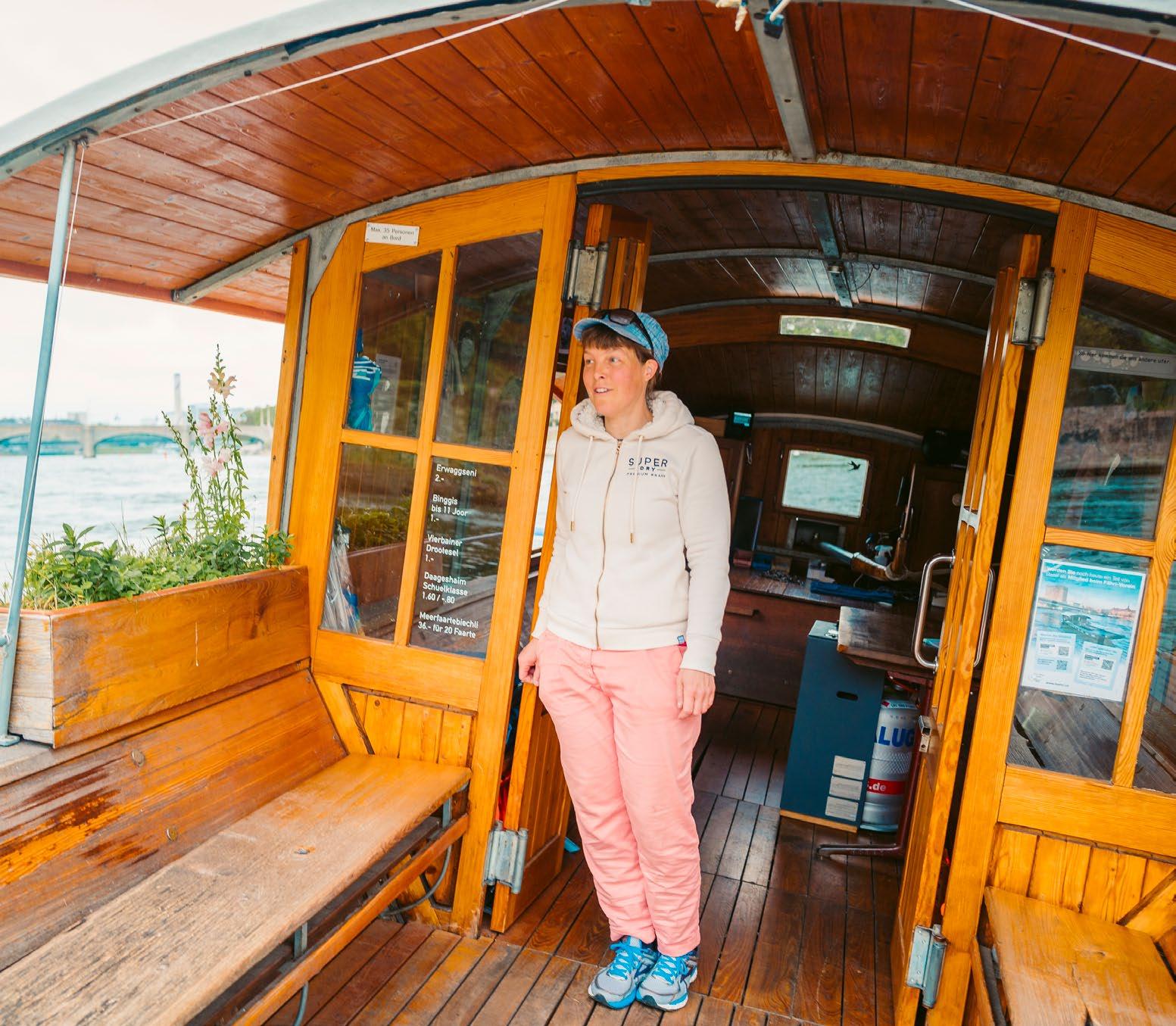
Sabine: A ride on the ferry gives people a short break. You experience the flowing water from up close, a meeting place and haven of peace in the middle of the city –a welcome gift in these turbulent times.
Complete the following sentence: The view of Basel from my ferry is particularly beautiful …
Sabine: … when a snowstorm is raging.
No floating billboards, thank you!
The Basel ferries have not been profitable for a long time now. The construction of the other bridges across the Rhine and the steady increase in mobility by other means soon led to a massive decrease in turnover. So first the Basel Association of Artists sold the four ferries to the people who were leasing them and then later they became the property of a foundation. At the beginning of the 1970s, when the leaseholder of the Klingental ferry wanted to sell his ferry and retire, it was almost taken over by an international beverage company which meant the ferries were threatened with commercialisation. Which is why – along with ensuring the ferries are open to the general public – that the current “Stiftung Basler Fähren” (Foun dation for Basel’s Ferries) was founded, which, together with the “Fähri-Verein Basel” (Basel Ferry Association) ensures that sufficient financial resources are raised to preserve the loss-making ferry service for future generations.
28
Rosi Tiefenthal & Hambbe Tschudi
Sabine Matejicek
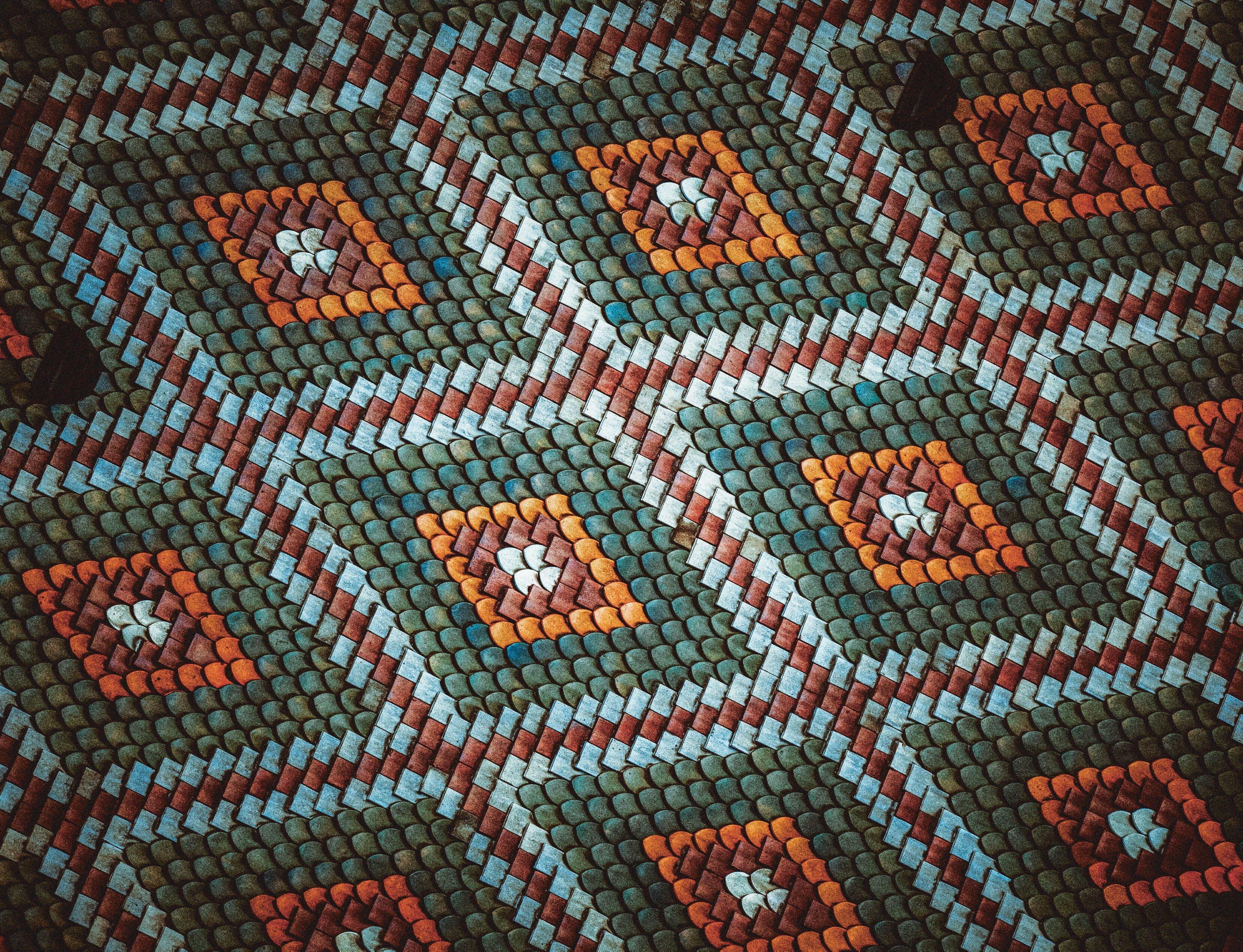
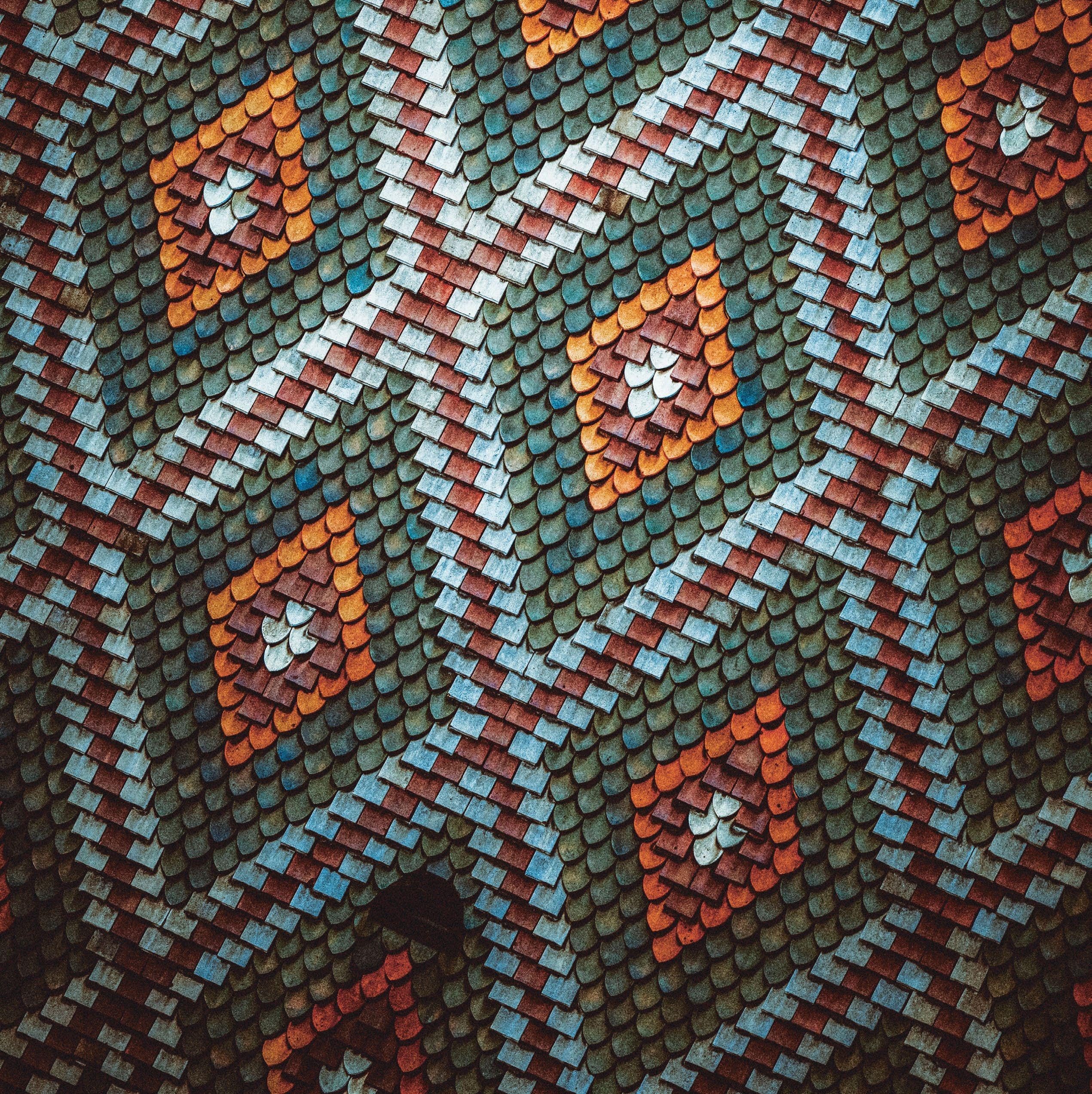



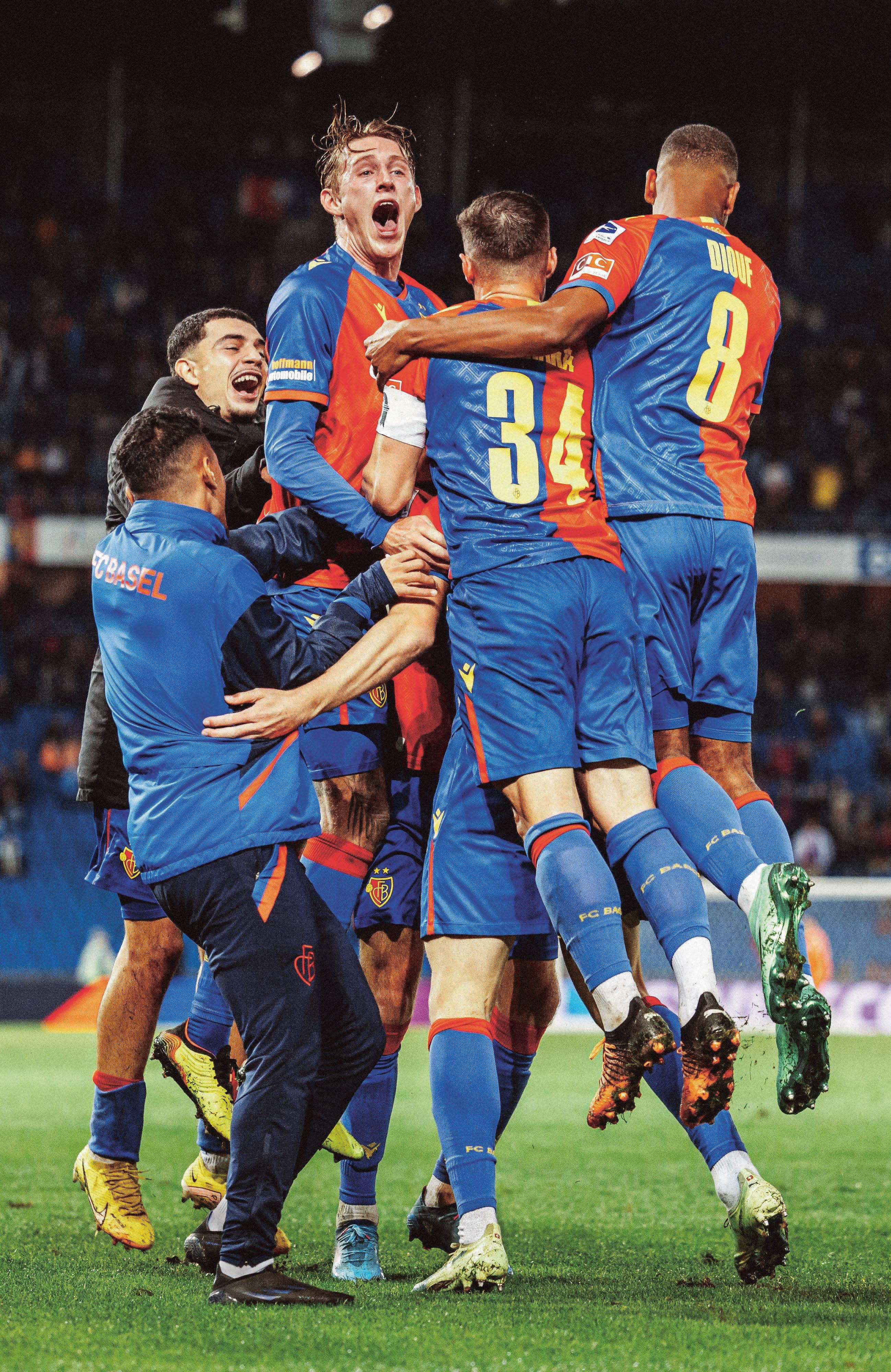
IM HIMMEL WIE
Essen macht glücklich – vor allem in Restaurants, die mit Sternen dotiert und mit Gault MillauPunkten ausgezeichnet sind. Wir zeigen dir, wo der Himmel die Erde küsst.
STUCKI
19 Gault Millau-Punkte, 2 Michelin-Sterne Bruderholzallee 42 – tanjagrandits.ch
Tanja Grandits zelebriert Genuss mit allen Sinnen. Ihre monochromen Teller verzaubern die Augen, berauschen die Sinne und inspirieren den Geist. Kochen ist für die Sterneköchin eine Sache des Herzens – das schmeckst, fühlst und erlebst du hier in Vollendung.
Tanja Grandits celebrates pleasure with all the senses. Her monochrome plates enchant the eye, intoxicate the senses and inspire the spirit. Cooking is a matter of the heart for this Michelin-starred chef –you will taste, feel and experience that here to perfection.
CHEVAL BLANC BY PETER KNOGL
19 Gault Millau-Punkte, 3 Michelin-Sterne Blumenrain 8 – chevalblancbasel.com

Kochen ist Kunst, das beweist dir der Chef de Cuisine hier mit stilsicheren Aroma-Symphonien und Geschmacks-Gemälden. Nicht umsonst gehört das Cheval Blanc zu den 100 besten Restaurants der Welt. Und dann noch diese Aussicht …!
Cooking is an art, the chef de cuisine here proves that with his stylish and confident symphonies of aromas and tableaux of flavours. It is not for no reason that the Cheval Blanc is counted among the 100 best restaurants in the world. And then there is the view …!
ROOTS
17 Gault Millau-Punkte, 2 Michelin-Sterne Mülhauserstrasse 17 – roots-basel.ch


Da ist zum einen diese Lage: Direkt am Rheinufer, mit freier Sicht auf die Altstadt. Und dann ist da Küchenchef Pascal Steffen, der das Gemüse in den Mittelpunkt stellt. Fleisch und Fisch sind mit einer Nebenrolle besetzt. Mit einer Oscarverdächtigen!
Well first there’s the location: right on the banks of the Rhine, with a clear view of the historic city centre. And then there is the chef, Pascal Steffen, who makes vegetables the centrepiece of his meals. Meat and fish in supporting roles, but close to winning an Oscar!
30 BASEL MOMENTS
IM ACKERMANNSHOF
16 Gault Millau-Punkte, 1 Michelin-Stern St. Johanns-Vorstadt 19/21 – ackermannshof.ch
Dass ungezwungene Atmosphäre und herausragende Kulinarik sich prima ergänzen, beweist Flavio Fermi im Ackermannshof. Wo vor einigen hundert Jahren noch Seidenbänder produziert wurden, begegnen sich heute fröhliche Menschen mit Liebe zum Fine Dining.
Flavio Fermi at the Ackermannshof proves that an informal atmosphere and outstanding culinary art are a wonderful combination. Silk ribbons were produced here a few centuries ago, now cheerful people with a love of fine dining gather in their stead.
BEL ETAGE
16 Gault Millau-Punkte, 1 Michelin-Stern Leonhardsgraben 47-49 – teufelhof.com

Hier dinierst du in einem Salon eines ehemaligen Herrschaftshauses aus dem 18. Jahrhundert. Die schnörkellose Gourmetküche ist jedoch absolut modern; dank Küchenchef Michael Baader, der seit über 30 Jahren für den Genuss bei Tisch verantwortlich ist.

Here you will dine in the salon of an old patrician house from the 18th century. But the unfussy gourmet cuisine served is absolutely modern; thanks to the chef Michael Baader, who has been responsible for indulging guests at the table for more than 30 years.
OLIV

16 Gault Millau-Punkte, im Guide Michelin erwähnt Bachlettenstrasse 1 – restaurantoliv.ch
Seit 2005 wird im Oliv von einem engagierten Team eine leichte, mediterrane Küche mit asiatischen Einflüssen serviert. Absolut zu Unrecht wird es von den Locals oft vergessen, denn es liegt unweit des Bahnhofs und überzeugt mit hervorragender Preis-Leistung.
Since 2005, a dedicated team have been serving a light Mediterranean cuisine with Asian influences at Oliv. A restaurant often forgotten by the locals, but quite wrongly so, because it is located not far from the station and offers excellent value for money.
31 BASEL MOMENTS
ROTER BÄREN
14 Gault Millau-Punkte, im Guide Michelin erwähnt Ochsengasse 17 – roterbaeren.ch
Der Beizenhimmel voller Leuchten, gefliester Boden, gestreifte Tapete; der Rote Bären ist cool, lebendig und fabelhaft: Bei den Gerichten in Einheitsgrösse ist Probierlust gefragt, je mutiger deine Kombination, desto virtuoser das Geschmackserlebnis!
The restaurant’s ceiling dangling full of lights, tiled floor, striped wallpaper; the Roter Bären is cool, lively and marvellous: you should be ready to try out the dishes, served in standard portions, the braver the combination you choose, the more perfect the culinary experience!


PURO
14 Gault Millau-Punkte Aeschengraben 25 – restaurants.accor.com
Der argentinische Chefkoch Pablo Löhle lässt dich hier kulinarisch von Südamerika bis Asien reisen – dank Showküche kannst du ihm dabei sogar zugucken. Dass Löhle früher bereits die Speisekarte im Grand Hotel Les Trois Rois geprägt hat, ist für das Puro ein Glücksfall.
The Argentinian chef here, Pablo Löhle, takes you on a culinary voyage from South America to Asia – and thanks to the show kitchen you can even watch him at work. The fact that Löhle used to mould the menu at the Grand Hotel Les Trois Rois is a stroke of luck for Puro.
ZUM WILDE MAA
13 Gault Millau-Punkte, im Guide Michelin erwähnt Oetlingerstrasse 165 – zumwildemaa.ch
Gourmet-Wirt Andreas Schürmann hat aus der Kleinbasler Quartierbeiz eine Top-Adresse für Genuss-Liebende gemacht. Die sehr kleine Speisekarte beinhaltet Gerichte aus saisonalen Produkten von Kleinproduzenten der Region – ohne Schnickschnack auf den Punkt gebracht.
Gourmet chef Andreas Schürmann has transformed this neighbourhood pub in Kleinbasel into a top address for fine food lovers. The very small menu consists of dishes made with seasonal products from small-scale regional producers – no frills, straight to the heart of the dish.

32 BASEL MOMENTS
CHEZ DONATI
13 Gault Millau-Punkte St. Johanns-Vorstadt 48 – bindella.ch
Einst war es eines der ersten italienischen Restaurants in Basel – heute ist es eine Institution und erste Adresse für Italien-Liebhaberinnen. Von den edlen Servier-Carellos bis hin zum frisch geschnittenen Prosciutto di Parma ist hier alles molto esclusivo.
It was once a pioneer Italian restaurant in Basel – now it is an institution and the favourite address for connoisseurs of Italy. From the classic serving carts to the freshly cut Parma ham, everything here is “molto esclusivo”.
 AU VIOLON
AU VIOLON
im Guide Michelin erwähnt Im Lohnhof 3 – au-violon.com

Im ehemaligen Untersuchungsgefängnis, gleich neben Musikmuseum und Jazz-Club, kannst du heute in dieser charmanten Brasserie ausgezeichnete französische Gastronomie mit top Preis-Leistung geniessen. Im Sommer unbedingt auf der Terrasse unter Ahorn und Linde!

In what was once a remand prison, right next to the music museum and the Bird’s Eye Jazz Club, you can now enjoy excellent French gastronomy in this brasserie – good quality, good-value. In summer, definitely sit on the terrace beneath the maple and lime trees!
13 Gault Millau-Punkte Rheingasse 12 – krafftbasel.ch
Auf knarrendem Fischgrät-Parkett schreitest du hier in den von hohen Bogenfenstern dominierten Speisesaal. Das Ambiente schreit danach, sich mal wieder in Schale zu werfen, um mit Blick auf die charmante Rheinpromenade dem herrlichen Genuss zu frönen.
Arriving here, you stride across creaking herringbone parquet into the dining room, dominated by high arched windows. The ambience calls for an effort: dress up smartly again and enjoy the delightful indulgence of eating here, with a view of the charming Rhine promenade.
 KRAFFT
KRAFFT
33 BASEL MOMENTS
PROBLEM?
BASLER LÖSUNG!
Das Basler Start-up Tide Ocean SA verwandelt Plastikmüll aus den Weltmeeren in neue Produkte und macht somit die Herstellung von neuem Plastik faktisch überflüssig. Von einer bahnbrechenden Idee, die auf dem Weg ist, ein globales Problem zu lösen und einer Gasse im St. Johann, die vielleicht irgendwann in «Ocean Avenue» umbenannt wird.

 Text & Bilder: Janine Wagner
Text & Bilder: Janine Wagner
Es sind Zahlen des Grauens: Rund 150 Millionen Tonnen Plastik sollen Schätzungen zufolge derzeit in den Weltmeeren treiben. Jährlich kommen um die 10 Millionen Tonnen dazu. Eine Katastrophe für das marine Ökosystem; über 800 Meerestierarten sind weltweit vom Plastikmüllproblem betroffen, Schadstoffe belasten die Ozeane, der Abfall türmt sich an den Traumstränden dieser Welt.
Zwei findige Herren haben sich 2019 zum Ziel gesetzt, sich der Katastrophe zu stellen. Thomas Schori und Marc Krebs, verschwägert, keine Umweltingenieure, keine Wissen schaftler, dafür mit einer grossen Portion Enthusiasmus und Kühnheit ausgestattet.
Ihre Idee: Man muss Meeresplastik rezyklieren und in den Zyklus zurückbringen. Klingt simpel – ist bahnbrechend: Die Geschichte von Tide Ocean.
GLOBALES
34 BASEL MOMENTS
Mit Durchhaltewillen zum Erfolg
Wie löst man ein globales Problem? «Man fragt erst einmal die Hochschule für Technik in Rapperswil um Rat», schmun zelt Marc. «Dort sitzen die Daniel Düsentriebs des Kunst stoff-Recyclings! Sie sagten: Schickt uns den Müll, wir analysieren ihn und überlegen uns ein Verfahren zur Wiederverwertung des Materials.» So geschahs. Das Ergebnis: Die Rezyklierung von durch Salzwasser und UV-Strahlen belastetem Meeres-Plastik ist möglich. Tide Ocean SA wurde gegründet. Ein halbes Jahr danach legte die Pandemie die Welt lahm. Tide Ocean machte weiter. Fuchste sich ein. Rannte an. Resignierte nie.

«Ein globales Problem muss mit einem globalen Netzwerk angegangen werden», so Marc. «Das ist aufwendig und anstrengend.» Neben monatelangem Tüfteln, Recherchieren, Vernetzen und Planen half hin und wieder auch das Glück. Tide Ocean fand ein neues Recycling-Center in Ranong, Thailand. «Die hatten tonnenweise Plastik, aber keine Ahnung, was sie damit tun sollten», erzählt Marc. «So wurde Thailand unser erstes Standbein.» Seither kamen die Philippinen, Indonesien und Mexiko dazu. Das Ziel: Auf jedem Kontinent soll der Meeresplastik gesammelt und rezykliert werden. Die Schweizer Technologie und das Know-how müssen überall auf der Welt platziert werden.
Dem Problem der mangelnden Infrastruktur in den Entwicklungsländern begegnet Tide Ocean mit einem Waste-Management-System, das auch sozialen Mehrwert bringt: So wird bereits der Fischer, der auf seinem Boot Plastik einsammelt, pro Kilo bezahlt, als würde er ein Kilogramm Fisch verkaufen. Auch im Sortierungs- und Trennungsprozess braucht es Arbeitskräfte, die entsprechend entlöhnt werden. In spezialisierten RecyclingFirmen wird der Meeres-Plastik am Ende anhand der Spezifikationen von #tide zum neuen Ausgangsmaterial, einem sauberen Granulat, verarbeitet.
TIDE OCEAN IN DEINEN HÄNDEN!
Auch dieses Magazin enthält rezykliertes Meeresplastik: Das Basler Traditionsunternehmen Winter & Company entwickelte aus #tide ocean material® ihr Toile Ocean, ein Stoff für Broschüren und Einbände. Das blaue Band im Innern dieses Magazins besteht daraus. Winter & Company war die erste Basler Firma, die die Zusammenarbeit mit Tide Ocean suchte. Über Google stiess Winter auf das junge Start-up – im persönlichen Kontakt stellte sich schliesslich heraus, dass die beiden Unternehmen nur zwei Kilometer Luftlinie voneinander getrennt beheimatet sind.
Maiengasse 30 – tide.earth
Nichts scheint unmöglich
Die ersten Produkte aus #tide ocean material® wurden für die Uhrenindustrie entwickelt. Bald darauf regnete es für das Start-up Preise. Aus der ganzen Welt kommen seither Anfragen; neulich sogar aus dem Silicon Valley. Namhafte Marken wie Hugo Boss, Tom Ford oder Maurice Lacroix arbeiten bereits mit Tide Ocean zusammen. Auch Coop und Migros wollen künftig nachhaltigen Plastik einsetzen. «Aktuell haben wir rund 100 offene Projekte», erzählt Marc nicht ohne Stolz. Mode, Elektronik-, Haus halt-, Automobil- oder Baubranche; der Verwendung von recyceltem Granulat oder Polyester ist kaum Grenzen gesetzt. «Eigentlich müsste kaum noch neuer Kunststoff hergestellt werden, denn an Rohstoff mangelt es wahrlich nicht», stellt Marc klar.
In zwei Jahren hat Tide Ocean rund 30 Millionen PetFlaschen aus dem Meer neues Leben eingehaucht. Das entspricht einem dreistelligen Tonnenbetrag. «Nichts» ist das für Marc. «Jede Minute landet eine weitere Lastwagenladung voller Plastikmüll im Meer! In diesem Jahr wollen wir doppelt so viel rezyklieren – wir stehen noch immer am Anfang.» Marc stapelt tief. Im Headquarter an der Maiengasse 30 sitzen unterdessen mehrere Mitarbei tende an ihren Computern. 14 Menschen und Dutzende Fischer arbeiten insgesamt für das Jungunternehmen, verteilt über die ganze Welt. Doch Marc Krebs und Thomas Schori wollen mehr. «Die Maiengasse soll zur Ocean Avenue werden», grinst Marc. Das Schild dazu hängt bereits neben der Eingangstür.
«Jede
Lastwagenladung
Plastikmüll
Meer.»
Minute landet eine weitere
voller
im
35 BASEL MOMENTS
TIDE OCEAN SA
GLOBAL PROBLEM? BASEL’S SOLUTION!
The Basel start-up Tide Ocean SA transforms plastic waste from the world’s oceans into a reusable product and thus renders the production of new plastic more or less obsolete. This is about a pioneering concept which is well on the way to solving a global problem and a small road in the St. Johann district, which may one day be renamed “Ocean Avenue”.

The figures are horrendous: An estimated 150 million tonnes of plastic are currently floating around in the world’s oceans and seas. Each year an additional 10 million tonnes join them. A catastrophe for marine ecosystems; worldwide, more than 800 marine species are affected by the problem of plastic waste in the sea; pollutants contaminate the ocean; waste piles up on the world’s most beautiful beaches.
In 2019, two ingenious gentlemen set themselves the task of facing up to this catastrophe. Thomas Schori and Marc Krebs, brothers-in-law, neither of them an environmental engineer or even a scientist; but they are both endowed with a healthy dose of enthusiasm and audacity. Their idea: you should recycle plastic from the oceans and then bring it back into circulation. That may sound simple – but what they are doing is trailblazing: the story of Tide Ocean.
Perseverance that led to success How do you solve a global problem? “Well, first you ask the University of Applied Sciences in Rapperswil for advice”, grins Marc. “That is where all the Gyro Gearlooses of the world of plastic recycling are to be found! They said: Send us the waste, we’ll analyse it and work out a process to recycle the material.” And that’s what happened. The result: It is possible to recycle plastic recovered from the sea which has been contaminated with saltwater and UV rays. Tide Ocean SA was founded. Half a year later the pandemic brought the world to a standstill. Tide Ocean soldiered on. Refined their processes. Ran into problems. Never gave up.
“A global problem has to be tackled with a global network”, explains Marc. “That is time-consuming and strenuous.” There were months of tinkering, researching, networking and planning, but sometimes luck played in their favour too. Tide Ocean found a new recycling centre in Ranong, in Thailand. “They had tonnes of plastic and absolutely no idea what to do with it”, recalls Marc. “So Thailand became our first foothold.” Since then, the Philippines, Indonesia and Mexico have also joined. The aim: to collect plastic out of the sea from every continent and then recycle it. The Swiss technology and know-how have to be well-placed, all over the world.
Tide Ocean counters the problem of a lack of infrastructure in developing nations with a waste management system that also has social value: For example, a fisherman who gathers up the plastic from his boat is paid per kilo, as though he were selling a kilo of fish. A workforce is also required for the sorting and separating process, and they are paid accordingly. In the final step, specialised recycling firms then process the marine plastic into a pure granulate, in accordance with #tide’s specifications.
36 BASEL MOMENTS
Nothing seems impossible
The first products made of #tide ocean material® were developed for the watch industry. Pretty soon, prizes were raining down on the start-up. And ever since, they’ve been receiving enquiries from all over the world; recently even from Silicon Valley. Famous brands such as Hugo Boss, Tom Ford and Maurice Lacroix are already collaborating with Tide Ocean. And the Coop and Migros want to switch to sustain able plastic in future as well. “We currently have around 100 projects running”, says Marc, not without pride. Fashion, electronics, household goods and the building industry; there are almost no limits to how the recycled granulate, or polyes ter, can be used. “Actually, there is almost no need for the synthesis of new plastics, because there is absolutely no shortage of raw material for our process”, clarifies Marc.

In just two years, Tide Ocean has breathed new life into around 30 million PET bottles recovered from the sea. That’s the equivalent of hundreds of thousands of kilograms. “That’s nothing”, says Marc. “Every minute, another lorry-load of plastic waste lands in the sea! We want to recycle twice as much this year – we are only just starting.” Marc is modest. In their headquarters at the Maiengasse 30, several emplo yees are already sitting at their computers. The young company has 14 employees and dozens of fishermen all over the world working for them. But Marc Krebs and Thomas Schori want more. “The Maiengasse should be renamed Ocean Avenue”, grins Marc. The road-sign to mark the transformation is already hanging next to the front door.
TIDE OCEAN IN YOUR HANDS!
This magazine also contains recycled plastic from the sea: The long-standing Basel firm Winter & Company used #tide ocean material® to develop Toile Ocean, a material for brochures and bindings. The blue binding inside this magazine is made of it. Winter & Company was the first firm in Basel to arrange a collaboration with Tide Ocean. Winter found the new start-up while searching on Google – and when he contacted them, it turned out that the two companies were only two kilometres apart, as the crow flies.
“Every minute, another lorry-load of plastic waste lands in the sea!”
BASEL MOMENTS
IN DER DICHTE DER BAUKUNST
Basel gilt als die Architekturhauptstadt der Schweiz. Hier arbeiten Büros wie Diener & Diener, Christ & Gantenbein, Herzog & de Meuron. Man könnte mehrere Wochen der hiesigen Architektur widmen. Allen, die nicht so viel Zeit haben, haben wir zehn Höhepunkte zusammengestellt.

Seit der Renaissance wird in Basel Kultur auf einem sehr hohen Niveau gepflegt. Auch die Förderung der Architektur gehörte hier schon früh zum guten Ton. So gibt es in der Stadt bis heute zahlreiche renommierte Büros, die den Stadtraum prägen und überdies auf der ganzen Welt mit herausragenden Bauwerken ihre Spuren hinterlassen. Zudem finden sich in Basel auf kleinstem Raum Bauten internationaler Grössen wie Frank O. Gehry, Mario Botta, Renzo Piano oder Zaha Hadid. Zur Inspiration haben wir zehn Architektur-Hotspots und architektonisch spannende Quartiere zusammengestellt. Auf zum Stadtspaziergang!
DREISPITZ
Hipper Architektur-Hotspot Dreispitz, Freilager-Platz – dreispitz.ch
Einst gab es hier alte Lagerhallen, muffige Bandräume und endlosen Lastwagen verkehr – heute ist der Dreispitz das Vorzeige-Areal der Stadt. Die Fachhochschule Nordwestschweiz hat hier einen Campus der Kultur geschaffen, es gibt Ausstellungsräume wie das Oslo 10, das Haus der elektronischen Künste oder das Schaulager, im Helsinki und im Transitlager werden moderne Wohnungen und Büros angeboten – und dazwischen immer wieder ein paar Gleise, die an früher erinnern …
Once there were old warehouses, stuffy band rooms and endless queues of lorries here – these days the Dreispitz is the showcase area of the city. The University of Applied Sciences NW Switzerland has created a campus of the arts here; there are exhibition spaces such as the Oslo 10, the House of Electronic Arts HEK and the Schaulager; modern apartments and offices are available in Helsinki and the Transitlager – and between them all, there are still a few railway tracks as a reminder of days past …

Die Genossenschaftssiedlung «Im Vogelsang» wurde 1925 innerhalb eines halben Jahres erbaut. 48 einstöckige Kleinhäuser, 9,25 Meter breit, Backsteinmauerwerk mit drei Zimmern, Wohnküche, Garten. Der Bau war eine staatlich subventionierte Mass nahme gegen die unhygienischen Wohnverhältnisse in der Stadt und er bot Platz für die rasant steigende Bevölkerung – einziehen durften nur Familien mit mindestens vier Kindern. Im Rahmen der von England kommenden Gartenstadtbewegung der 1920erJahre und der Wohnausstellung WOBA von 1930 baute Bernoulli in Basel weitere Siedlungen wie die Wohnkolonie Eglisee oder den Landauer.
The housing cooperative estate “Im Vogelsang” was finished within half a year in 1925. Forty-eight small one-storey houses, 9.25 metres wide, built of brick with three rooms plus an open-plan kitchen/living room and a garden. The buildings were state-subsidized and were a measure taken to combat the insanitary living conditions in town and to provide space for the rapidly increasing population – the houses were reserved for families with at least four children. Inspired by the garden city movement which had originated in England in the 1920s and the WOBA housing exhibition in 1930, Bernoulli also constructed other housing estates in Basel such as the Eglisee housing colony and the Landauer.
von Hans Bernoulli – Häuser für einkommensschwache Familien Eugen-Wullschleger-Strasse
SIEDLUNG VOGELSANG
38 BASEL MOMENTS
Markant und dennoch luftig-leicht in die Landschaft integriert: Das 1954 fertiggestellte Kraftwerk Birsfelden ist zwar aus massivem Stahlbeton, wirkt jedoch durch die verglaste Turbinenhalle und die kleinen Häuschen mit den runden Fenstern, die wie Augen auf den Rhein blicken, überaus freundlich. Fussgängern wird auf dem Weg entlang der Wehrbau ten einen Blick in die Turbinenhalle ermöglicht – und genau das war das Anliegen des Architekten; die Bevölkerung sollte die Produktion von Strom nachvollziehen können.
Striking, yet light and airy, and well-integrated in the landscape: the Birsfelden power station, completed in 1954, is constructed of solid reinforced concrete, thanks to its glazed turbine hall and row of sheds with round windows that look like eyes gazing down at the Rhine. Pedestrians crossing the path along the weir structures can see into the turbine hall – just as the architect intended; he wanted the population to understand how electricity is produced.

GEWERBESCHULE
von Hermann & Hans Peter Baur – Meisterwerk der Nachkriegsmoderne Vogelsangstrasse 15
Das 1961 entstandene Ensemble mit sieben Gebäuden und einer Maurerhalle wurde als Schule für 6000 Auszubildende in gewerblichen und Gestaltungsberufen geschaffen und dient diesem Zweck bis heute. Neben der Sachlichkeit in Beton ist hier auch die Integration von Kunst bemerkenswert – die «Baustein säule» und zwei Wandreliefs von Hans Arp wurden als Bestandteil der Baukomposition entworfen.

This ensemble of seven buildings and a bricklayer’s hall, constructed in 1961, was established as a school for 6,000 industrial and design trainees and still serves the same purpose today. The sobriety of the concrete is enhanced with the noteworthy integration of art – the block column and two wall reliefs by Hans Arp were created as part of the building design.


1824 feierte das Stadtcasino von Melchior Berri Eröffnung. Fortan hörte man hier Mozart, Beethoven oder Rossini. Schon bald stiess das Casino aber an seine Kapazitätsgrenzen, der akustisch hochkarätige Musiksaal von Johann Jakob Stehlin wurde angebaut. Die Platzprobleme blieben. Ein Neubau wurde diskutiert, aber nie umgesetzt. Dann kamen Herzog & de Meuron und machten aus dem Problemobjekt ein Bijou, indem sie Tradition und Moderne auf perfekte Art und Weise verbanden. Das 2020 wiedereröffnete Konzerthaus ist heute nicht nur wegen der brillanten Akustik ein Besuch wert, sondern auch wegen dem opulenten Interieur und den überraschenden Ein- und Ausblicken.
The opening ceremony for Melchior Berri’s Stadtcasino was held in 1824. From that moment on you could hear Mozart, Beethoven and Rossini played here. But it wasn’t long before the Casino reached the limits of its capacity, at which point the acousti cally excellent music room by Johann Jakob Stehling was added. And yet the problem of too little space remained. A new construction was long discussed but never came to anything. But then along came Herzog & de Meuron and transformed the problematic building into a bijou, a perfect combination of traditional and modern. The concert hall, which reopened in 2020, is now not only worth a visit for its brilliant acoustics, but also for its opulent interior and the striking views – both inwards and outwards.
ANTONIUSKIRCHE
von Karl Moser – erste Betonkirche der Schweiz Kannenfeldstrasse 35
Die erste reine Betonkirche der Schweiz wurde zwischen 1925 und 1927 in rohem Sichtbeton erbaut. Das imposante Gebäude war in den Anfängen sehr umstritten und wurde wegen dem 22 Meter hohen Kirchturm oft als «Seelensilo» oder «Vater-Unser-Fabrik» bezeichnet. Imposant sind auch die Glasfenster, die bei Sonnenschein dem funktionalen Innenraum ein zauberhaftes Lichtspiel bescheren.
The first church in Switzerland to be constructed entirely of concrete was built between 1925 and 1927 in roughcast exposed concrete. The imposing building was extremely controversial when it was built and was often referred to as the “soul granary” or the “Our Father factory” because of its 22-metre-high tower. Its glass windows are also very impressive; when the sun is shining in, they produce an enchanting play of light on the church’s functional interior.
von Hans Hoffmann – eins mit der Natur Hofstrasse Birsfelden
von Herzog & de Meuron – hervorragende Anpassung Konzertgasse 1 – stadtcasino-basel.ch
KRAFTWERK BIRSFELDEN
ERWEITERUNG STADTCASINO
39 BASEL MOMENTS
ST. ALBAN TAL
Geschichte trifft Gegenwart
St. Alban-Rheinweg, St. Alban-Talstrasse, St. Alban-Kirchrain, St. Alban-Vorstadt
Die malerischen Gässchen, der Kanal und die historischen Bauten erinnern eher an ein mittelalterliches Dorf als an eine Stadt. Neben der Papiermühle, Fachwerkhäusern und frühen Industriegebäuden findet man hier jedoch auch Musterbeispiele für das Bauen im Einklang mit historischem Bestand. Die Wohnhäuser von Diener & Diener zum Beispiel, das Kunstmuseum I Gegenwart von Katharina und Wilfrid Steib, die Jugend herberge von Buchner Bründler oder das ehemalige Arbeiterhaus von Michael Alder.
The picturesque alleyways, the canal and the historical buildings are more reminiscent of a medieval village than a modern city. But in the midst of the old paper mill, the half-timbe red houses and the early industrial buildings, you will also find perfect examples of more recent buildings in harmony with the existing historical architecture. For example, the houses by Diener & Diener, the Contemporary Art Museum by Katharina and Wilfrid Steib, the youth hostel by Buchner Bründler and the former workman’s house by Michael Alder.
VITRA CAMPUS


Weltberühmter Architekturpark Charles-Eames-Strasse 2, Weil am Rhein – vitra.com
Einen hübschen Spaziergang von Basel entfernt liegt der Vitra-Campus und mit ihm Bauwerke der internationalen Architektur-Elite. Die Tankstelle von Jean Prouvé, das Feuerwehrhaus von Zaha Hadid, der Konferenzbau von Tadao Ando, das Vitra Design Museum von Frank O. Gehry, das Vitra Haus von Herzog & de Meuron, der Dome von Richard B. Fuller, die Produktionshalle von Álvaro Siza – hier baut, wer Rang und Namen hat. Auf diesem Areal geschieht nicht nur die Endmontage der Vitra-Möbel, sondern Architektur, Design und Kunst in Vollendung.
A lovely walk away will take you from Basel to the Vitra Campus and its buildings by the elite of international architecture. Jean Prouvé’s petrol station, Zaha Hadid’s fire station, the conference building by Tadao Ando, the Vitra Design Museum by Frank O. Gehry, the Vitra house by Herzog & de Meuron, the Dome by Richard B. Fuller, the production hall by Álvaro Siza – anyone with a name has built something here. This is not just the place where Vitra furniture is assembled, it is architecture, design and art to perfection.
KUNSTMUSEUM BASEL
Alt und neu in perfekter Harmonie St. Alban-Graben 8 – kunstmuseumbasel.ch

Neun Kalkstein- und sieben Granitsorten aus allen Regionen der Schweiz; der Hauptbau des Kunstmuseums Basel von 1936 ist wegen seiner Materialisierung aber auch wegen dem hübschen Hof und den ehrwürdigen Ausstellungssälen ein Meisterwerk. Realisiert wurde er vom Basler Architekten Rudolf Christ und dem Stuttgarter Baumeister Paul Bonatz. Seit 2016 steht gegenüber und unterirdisch verbunden der markante Neubau, entworfen von Christ & Gantenbein. Er zitiert den Hauptbau in vielen Elementen und verbindet sich mit ihm zu einem eindrücklichen Ensemble.
Nine different limestones and seven types of granite from all over Switzerland; the main building of Basel’s Kunstmuseum built in 1936, is a masterpiece in its use of materials, but also with the charming courtyard and awe-inspiring exhibition halls. It was the work of the Basel architect Rudolf Christ and the master builder Paul Bonatz from Stuttgart. The striking new building by Christ & Gantenbein, has stood opposite since 2016 and is connected with it by an underground passageway. It references the main building in many of its elements and together they form an impressive ensemble.
ERLENMATT OST
Zukunftsweisendes Wohnquartier Signalstrasse – erlenmatt-ost.ch

Wo einst Güterzüge der deutschen Bahn rollten, wohnen heute 500 Menschen in neun Mehrfamilienhäusern um einen zentralen Park. Das Projekt der Stiftung Habitat fördert das gemeinschaftliche Leben und setzt sich intensiv mit Nachhaltigkeit, Flächenverbrauch, Energie und Mobilität auseinander. Historisches Herz dieses zukunftsweisenden Quar tiers ist das Silo von 1912, welches von Harry Gugger zu Restaurant, Cafébar und Boutique Hostel umgebaut wurde. Unkonventionell sind auch die Häuser von Abraha Achermann und Buchner Bründler, bei denen mit langlebigen Industriematerialien einfacher und kostenbewusst ausgebauter Wohnraum entstand.
500 people now live in nine apartment buildings arranged around a central park, in the area where the freight trains of the German rail once rolled. This project by the Habitat Foundation promotes cooperative living and also confronts issues such as sustainability, use of land and energy and mobility. The historic heart of this trendsetting neighbourhood is the Silo, built in 1912, which was converted into a restaurant, café-bar and boutique hostel by Harry Gugger. Just as unconventional are the buildings designed by Abraha Achermann and Buchner Bründler, with durable industrial materials creating simple and budget-conscious living spaces.
40

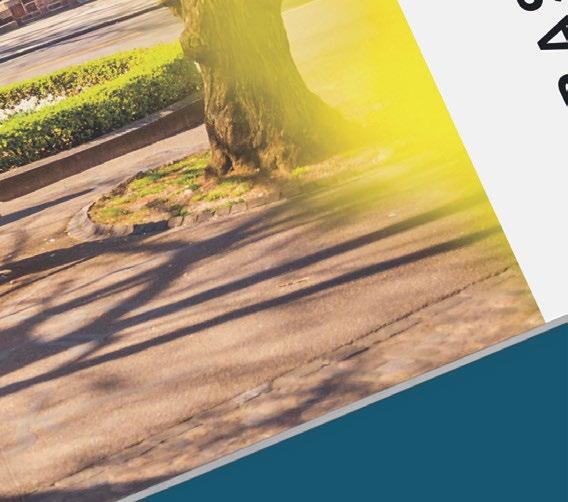





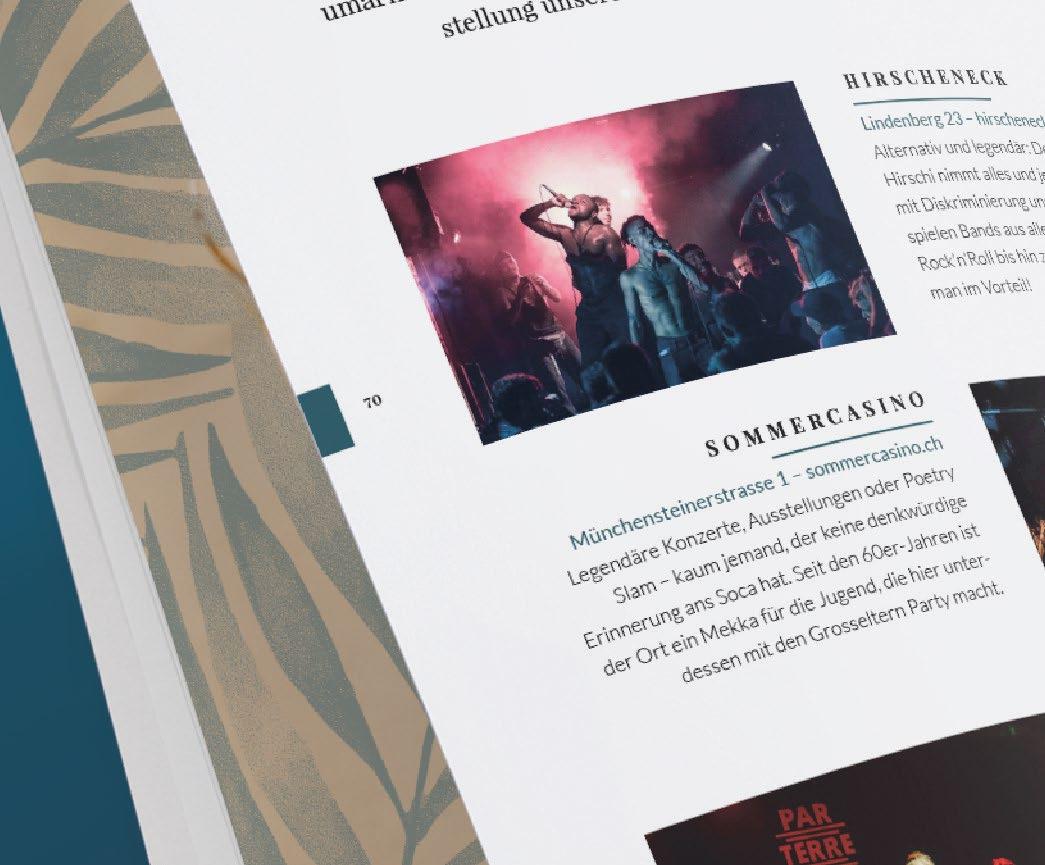
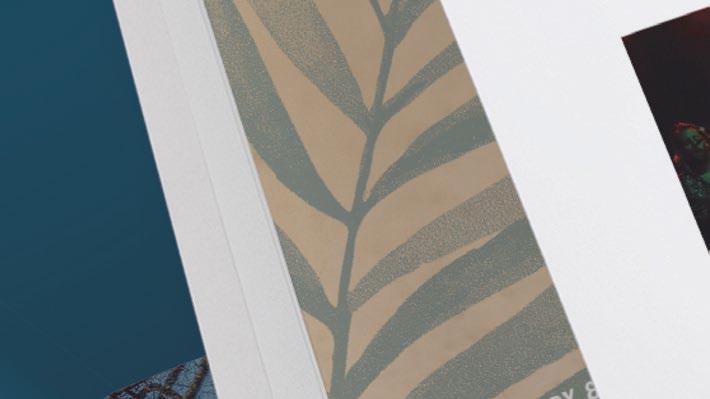




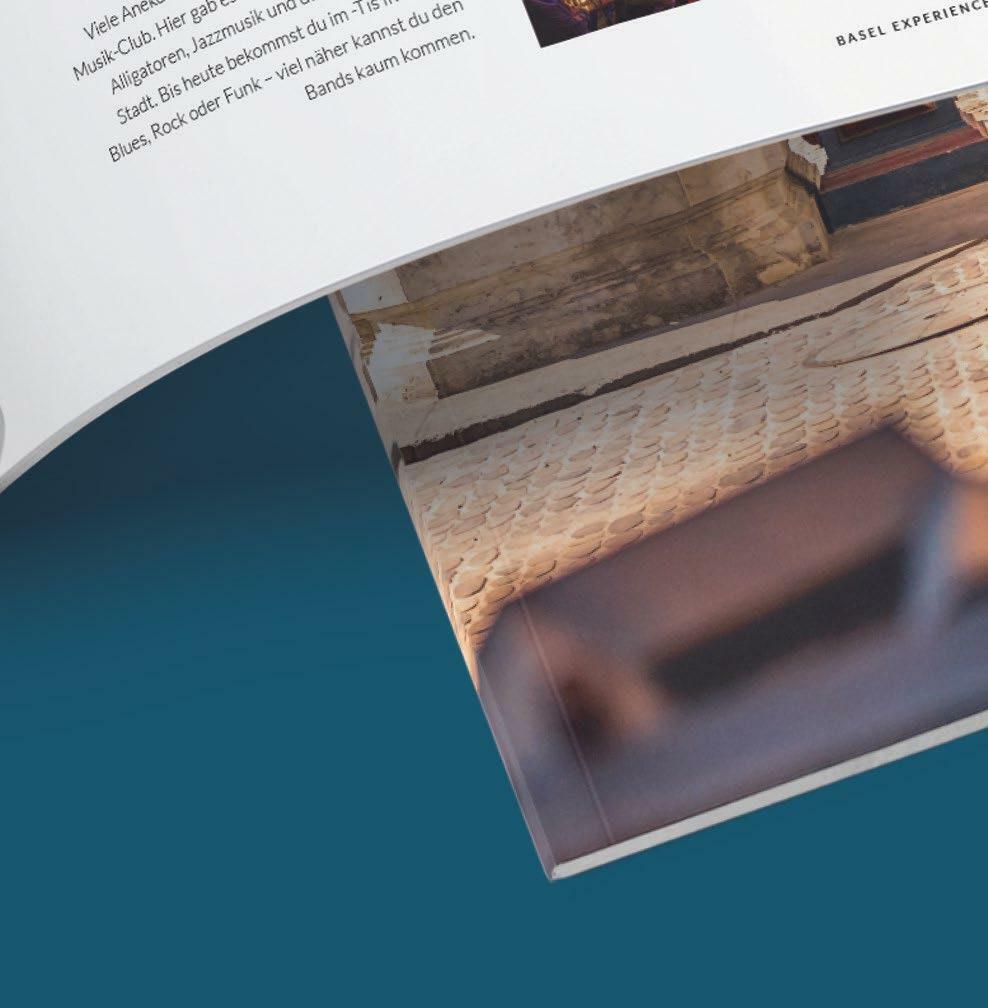

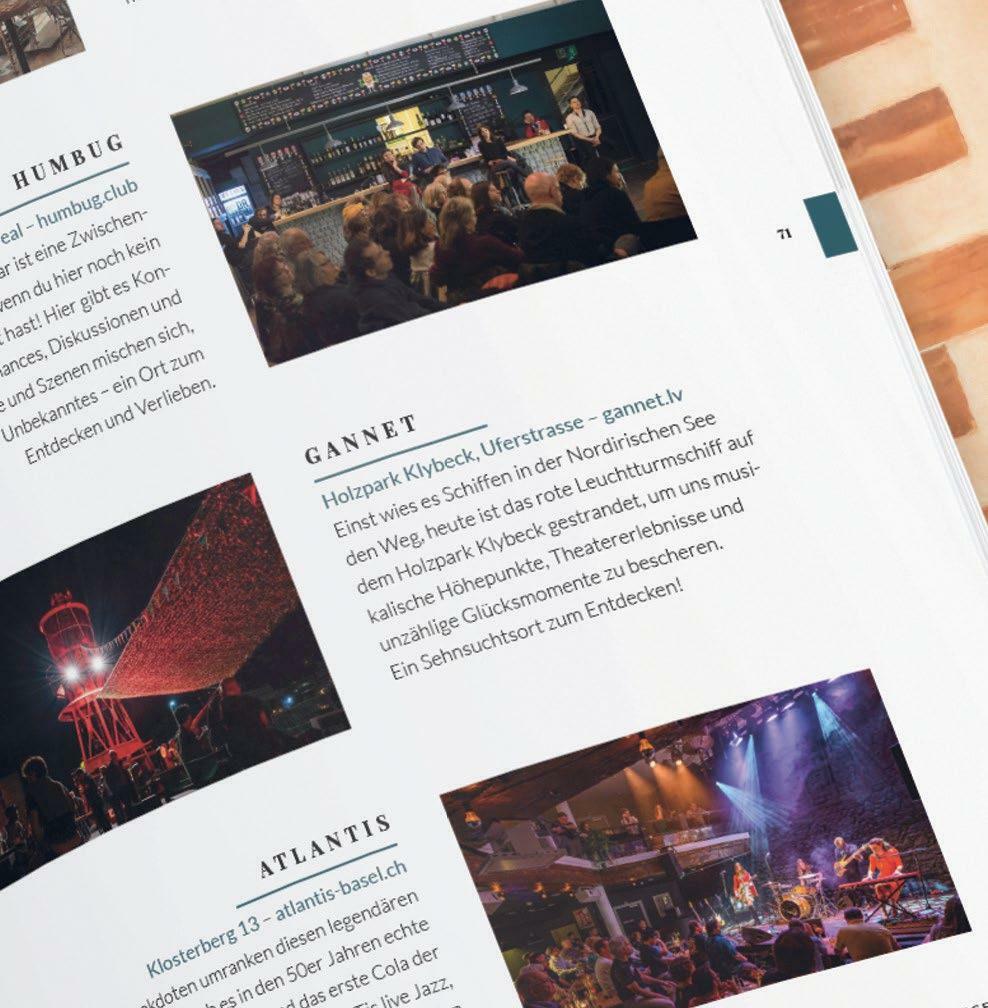



Vollgepackt mit Inspiration für deine Erlebnisstadt Basel. Das LoveYourCity Magazin in drei attraktiven Editionen. Magazine jetzt lesen!
STADTOASE, ERLEBNISWELT & RETTUNGSRING

Er mag Reptilien, Hausspatzen und Menschen: Olivier Pagan, seit 20 Jahren Direktor des Zoo Basel, kennt sich aus mit hohen Wellen und mag den Rhein – ist jedoch selbst ein eher stilles Wasser. «Unsere Hauptakteure sind nicht die Direktoren», stellt er gleich zu Beginn des Gesprächs augenzwinkernd klar. Um danach sehr fokussiert, bestimmt und unterhaltsam von Herausforderungen und Zielen eines Zoos inmitten der Stadt zu erzählen.
Text: Janine Wagner Bilder: StadtKonzeptBasel
42 BASEL MOMENTS
INTERVIEW OLIVIER PAGAN
«Auch die Basler Innenstadt finde ich wunderschön und spaziere darum abends gerne durch die Gassen.»
Olivier Pagans Büro liegt direkt über dem Eingang des Zolli und besteht zur Hälfte aus Fenstern. Am Schreib tisch sitzend sieht der Zoo-Direktor daher nicht nur seine Arbeit, ein volles Bücherregal und einen vor Jahren im Garten eines Freundes ausgekochten Kamelschädel, sondern vor allem die fröhlichen Besucherinnen und Besucher. Etwas getrübt wird diese Sicht allerdings durch ziemlich schmutziges Fensterglas. Es ist Spatzen-Kot, der da rundum klebt.


In den Rolladen-Kästen von Olivier Pagans Büro haben sich nämlich Hausspatzen eingenistet – als hätten sie geahnt, dass sie hier ganz bestimmt nicht verjagt würden. Tatsächlich gesteht der Chef, er habe ein «petit faible» für die kleinen Tierchen; der ver schmierte Ausblick sei ihm egal. Im Gespräch zeigt sich denn auch sofort, dass er überaus klarsieht, was die Zukunft seines KMU angeht oder den Wert des Zolli für Basel.
Sie hatten kürzlich Ihr 20-jähriges DirektorenJubiläum – haben Sie gefeiert?
Nein, tatsächlich bin ich darüber erschrocken – ich hatte das gar nicht auf dem Radar. Zudem feiert man ja eigentlich erst ab 25 Jahren und dieses Jubiläum hatte ich bereits, da ich schon 1993 als Zoo-Tierarzt eingestellt wurde.
Was verbindet Sie mit dem Zolli?
Zum einen meine Jugend: Ich bin in St. Blaise bei Neuenburg aufgewachsen und wir waren immer wieder im Zoo Basel. Zudem war ich als Bub ein «Schlängeler», ein Reptilien-Fan. Nach dem Studium habe ich über Reptilien-Krankheiten doktoriert und hatte dadurch das Glück, die Stelle als Zoo-Tierarzt in Basel zu erhalten. Das war für mich wie ein Sechser im Lotto. Der zweite Sechser war dann die Direkto ren-Stelle. Damals war ich in einer einjährigen Auszeit und gerade mit dem Segelschiff auf Trinidad. Ich behaupte ja, dass ich heute nur hier sitze, weil diese wunderschönen Briefmarken voller bunter Vögel auf meinem Bewerbungscouvert klebten …
Als der Zolli vor bald 150 Jahren eröffnete, hiess es, er solle der Stadtbevölkerung die Natur- und Tierwelt näherbringen. Wie beurteilen Sie dieses Ziel aus heutiger Sicht?
Ich finde es hochmodern! In den Urkundepapieren von 1874 steht, die Leute der Stadt hätten keine Ahnung mehr von Tieren und der Natur. Und ganz ehrlich: Das ist heute nicht anders. Darum finde ich, dass wir hier als Stadtoase am richtigen Ort sind. Wir müssen der urbanen Gesellschaft des 21. Jahrhun derts zeigen, was es bedeutet, sich für Tiere zu enga gieren: Das heisst nämlich, den Tieren einen Lebens raum zu ermöglichen. Der Zoo Basel tut alles dafür, vitale, florierende Populationen bedrohter Tierarten
aufrechtzuerhalten. Damit ist er auch ein Rettungsring, denn unsere Reservepopulatio nen könnten theoretisch wieder in natürliche Lebensräume integriert werden. Allerdings funktioniert das nur, wenn wir als Gesellschaft es schaffen, diese Lebensräume zu be wahren. Deshalb ist unsere Zusammenarbeit mit Naturschutzorganisationen wie dem WWF, Pro Natura oder der International Union for Conservation of Nature (IUCN) so entscheidend. Aber auch unsere Vernetzung mit anderen wissenschaftlich geführten Zoos – national und international. Das Ganze ist ein hochkomplexes Mosaik und der Zolli ein wichtiges Steinchen davon.
Haben Sie hin und wieder mit Tierschützern zu tun? Ja, das kommt vor. Mit dem generischen Begriff «Tierschützer» muss man allerdings aufpassen. Wir verstehen uns ebenfalls als Tierund Artenschützer. Wir engagieren uns für den Schutz diverser Arten und sorgen kompromisslos für unsere Tiere. Tierschutz kann aber extremistische Forderungen beinhalten. Wenn Tierschutz heisst, keine Tiere zu halten, dann können wir uns mit dieser Idee natürlich nicht anfreunden. Wir haben als Zolli einen zentralen Bildungs- und Vermittlungsauftrag. Auch mit den Tierrechtlern haben wir Mühe. Wir sagen: Um einem Tier Rechte zusprechen zu können, sollte man es sehr gut kennen und wissen, was es braucht, damit es ihm gut geht. Oder anders ausgedrückt: Nur, wer ein Tier hält, kann es so gut kennen, dass er es schützen möchte. Ich setze mich eigentlich tagtäglich mit solchen Themen auseinander. Oft schaue ich dann auch zum Fenster raus, sehe die lachenden Gesichter und denke mir: So falsch machen wirs vermutlich nicht.

Die Lage des Zolli in Basel ist sehr speziell: Mitten in der Stadt ist Wachstum ausgeschlossen und Platzmangel garantiert … Das ist gleichzeitig Herausforderung und riesiges Glück! Die Annahme, dass es den Tieren besser geht, wenn sie mehr Platz haben, ist nämlich ein Trugschluss. In der menschlichen Denkhaltung bedeutet mehr immer besser – aber die Biologie funktioniert nicht so. Entscheidend ist die richtige Gestaltung des Raums. Nehmen wir zum Beispiel eine Schildkröte: Mit dem richtigen Bodensubstrat, der richtigen Temperatur, mit adäquaten Rückzugsorten und den richtigen Pflanzen geht es ihr besser, als wenn ich sie auf den Joggeli-Rasen setze und ihr sage: Jetzt lauf los und geniess deinen Platz!
Natürlich ist es eine Herausforderung, auf unserem 12 Hektar grossen Gelände einen modernen Zoo zu gestalten. Die beschränkten Platzverhältnisse erfordern, dass wir die bestmöglichen Anlagen für unsere Tiere bauen. In der Natur hat ein Tier ja auch nicht unendlich viel Raum zur Verfügung. Es hat ein Territorium, welches es gegen Artgenossen und Feinde zu verteidigen hat. Die Idee, dass man in der Natur als Tier frei ist und im Zoo eingesperrt, ist falsch. Ich finde deshalb, der Zolli ist hier absolut am richtigen Ort. Die Bildung der urbanen Gesellschaft erreichen wir hier. Wir haben eine Million Besucherinnen und Besucher pro Jahr. Das würden wir vermutlich ausserhalb der Stadt nicht hinbekommen.
BASEL MOMENTS
Die Baslerinnen und Basler sind ja auch sehr stolz auf ihren Zolli … Schon der liebevolle Name sagts. Wenn ich in der Romandie sage «Je travaille au Zolli», dann werde ich erst einmal gefragt: «Tu travailles où?» Man spürt hier stark die Regio Basiliensis und dass sie am Zolli hängt. Deshalb müssen wir ihm auch besondere Sorge tragen.
Sie öffnen die Anlage extra bereits um 8 Uhr, damit die Anwohnerinnen und Anwohner durch den Park zur Arbeit gehen können.
Das ist jetzt nicht wissenschaftlich fundiert, aber ja, ich behaupte, dass wir im engsten Umkreis viele Abonnenten verlören, wenn wir den Zolli erst um 9 oder 10 Uhr öffnen würden
Wo trifft man Sie in der Stadt, wenn nicht im Zoo?

Am Rhein – ich bin ein grosser Fan von Wasser! Aber auch die Basler Innenstadt finde ich wunderschön und spaziere darum abends gerne durch die Gassen.
Was berührt Sie am Zolli am meisten?
Das tönt jetzt vielleicht etwas seltsam, aber es sind die Menschen. Das Engagement unserer Mitarbeitenden für die Tiere und ihre Begeisterung für das Ziel, einen guten Zoo zu führen – das macht mir Eindruck. Jeden Tag.
Was wollen Sie den Leserinnen und Lesern noch mitgeben?
Wenn man das Glück hat, in einem Zoo zu arbeiten – egal in welcher Position –, will man den Menschen, die dieses Glück nicht haben, einen möglichst nachhaltigen Besuch ermöglichen. Heute herrscht so viel Hektik, Druck und Stress, dass ich es extrem wichtig finde, den Zolli auf altbewährte Art und Weise weiter zu betreiben. Mit Fokus auf die Tiererlebnisse und die wunderschöne Parkanlage. Vermutlich können wir alle bereits in wenigen Jahren in unserem Wohnzimmer ein Hologramm eines Blauwals aufspringen lassen. Die Begegnung mit dem Original ist und bleibt jedoch unsere Qualität.

45 BASEL MOMENTS
Binningerstrasse 40 – zoobasel.ch
ZOO BASEL
RAUM FÜR KUNST & KULTUR
Drei für Besucher:innen kostenlose Ausstellungen pro Jahr, Einbezug aktueller kulturpolitischer Diskurse, innovative Kunst- und Themenaus stellungen, konzipiert aus individuellen und divergierenden Perspektiven. Mit diesem Konzept und sechs erfolgreichen Ausstellungen hat sich die Kulturstiftung Basel H. Geiger | KBH.G seit Eröffnung im Jahr 2020 im Basler Kulturbetrieb etabliert.

Mit MUSIC A CONVERSATION THROUGH SONG TITLES präsentierte die KBH.G im Herbst 2021 das neuste Kunst- und Buchprojekt der Schweizer Konzept-, Medien- und Installationskünstler Jahic / Roethlis berger. Nach dem internationalen Erfolg ihres Buchprojektes ARTISTSʼ RECIPES hatte das Künstlerduo erneut nationale und internationale Künstler:innen zum Dialog eingeladen.


Dem rasanten Bevölkerungswachstum und seinen dramatischen Folgen für Mensch, Tier und Umwelt widmete die KBH.G ihre sechste Ausstel lung. Die raumfüllende, begehbare Installation SLEEPING WITH THE GODS, das namensgebende Hauptwerk der im Sommer 2022 gezeig ten Schau des Schweizer Künstlers und Objektbauers Carlo Borer, hielt beides eindrücklich fest.
TRANSYLVANIA’S HIDDEN TREASURES umschreibt die private Passion des Galeristen Miklós von Bartha für Keramik und Textilien aus Sieben bürgen, der Heimat seiner Familie. Vom 25. August bis 6. November 2022 zeigt die KBH.G nicht nur 186 seiner Exponate, sondern auch, wie aus seiner zufälligen Begegnung mit der amerikanischen Designerin JJ Martin vom Label La DoubleJ eine Mode und Interieur-Kollektion entstand.
Die erste reine Fotoausstellung der KBH.G trägt den Titel of CORSE und zeigt die fotografische Auseinandersetzung mit dem eigenen Körper eines rein weiblichen Kollektivs. Vom 8. Dezember 2022 bis 12. Februar 2023 präsentiert die KBH.G die in einer gemeinsamen Woche auf Korsika entstandenen Arbeiten der neun internationalen Fotografinnen. Öffnungszeiten während der Ausstellungen: Täglich (ausser Dienstag) von 11h bis 18h. Eintritt und Ausstellungskatalog sind jeweils kostenlos. +41 61 262 01 66 | info@kbhg.ch | kbhg.ch
«MUSIC A CONVERSATION THROUGH SONG TITLES», 2021
Kulturstiftung Basel H. Geiger Spitalstrasse 18, Basel kbhg.ch
«SLEEP ING WITH THE GODS», 2022
OASIS
He likes reptiles, house sparrows and people: Olivier Pagan has been the director of the Basel Zoo for 20 years now, is at home on the high seas and loves the Rhine – but himself is more of a still water runs deep kind of person. “Our most important players are not the directors”, he makes that clear right at the start of our interview, with a twinkle in his eye. But then he talks about the challenges and goals of running a zoo in the middle of the city in a very focussed, determined and entertaining manner.

Olivier Pagan’s office is situated directly above the entrance to the Zoo and half of it consists of windows. So sitting at his desk, the zoo’s director doesn’t just see his work, the bulging bookcase and a camel skull he boiled down to the bone in a friend’s garden years ago, but all the cheerful visitors too. The view is, however, a bit blurred due to the very dirty windows: sparrows’ droppings, stuck to everything. House sparrows have nested in the coffers of his window blinds – as though they had somehow guessed that they wouldn’t be chased away here. And the boss does indeed admit that he has “a bit of a thing” for the tiny animals; he doesn’t mind the blurred view. During our interview he quickly demonstrates that he has a very clear view about the future of his SME and how valuable the zoo is for Basel.
It was recently your 20th anniversary as director of the zoo – did you celebrate? No, actually I was rather shocked about it – it hadn’t really featured on my radar. And you really only celebrate after 25 years, and I had celebrated that, because I was already recruited as the zoo’s veterinarian in 1993.
How are you connected with the zoo?
Well firstly, my childhood: I grew up in St. Blaise near Neuchâtel, and we often came to visit the zoo in Basel. And then I was a great fan of reptiles when I was a boy. When I finished my degree, I wrote a doctorate on reptile diseases and because of that I was lucky enough to be given the job of veterinarian at Basel Zoo. For me, that was like winning the lottery. The second lucky strike was when I was made director. At the time I was taking a year-long sabbatical and was on a sailing boat in Trinidad. I still say that I am only sitting here today because I stuck such a beautiful stamp full of colourful birds on the envelope for my application …
47 BASEL MOMENTS
AN
IN THE CITY, A WORLD OF EXPERIENCES & A LIFELINE
When the zoo opened almost 150 years ago, the aim was to bring the urban population closer to the natural world and animal kingdom. What do you think of this aim from today’s perspective?

I think it is very modern! In the deeds dating from 1874 it says that the people living in town no longer had any idea whatsoever about animals or nature. And to be perfectly honest: that is no different today. That’s why I think we’re perfectly located here, an oasis in the middle of town. We have to show the urban population of the 21st century what it means to actively care for animals: meaning providing the animals with a living environment. Basel Zoo does everything it possibly can to maintain vigorous, thriving populations of endangered species. This also makes it a lifeline, because our reserve populations could theoretically be reintroduced into natural habitats. Although this would only work if we as a society manage to preserve those habitats. That is why our collaboration with nature conservation organisations such as the WWF, Pro Natura and the International Union for Conservation of Nature (IUCN) is so crucial. But also our networking with other scientifically managed zoos –in Switzerland and abroad. The whole thing is a very complicated mosaic and the zoo is an important stone in that mosaic.
Do you have dealings with animal welfare activists from time to time?
Yes, sometimes. But you have to be careful with the generalised term “animal welfare”. We also consider ourselves protectors of animals and species. We are actively enga ged in the protection of various species and are uncompromising in the care of our animals. But animal rights activism can involve extremist demands. If animal welfare means not keeping any animals, then obviously we have a bit of a problem accepting it. As a zoo we have a crucial role to fulfil as educators and mediators. And we have some problems with the animal rights activists. Our view is: in order to be able to guarantee an animal its rights, you have to be very familiar with it and know what it needs, so that is well. Or to put it slightly differently: only someone who looks after an animal knows it so well that they really want to protect it. I actually grapple with these issues on a day-to-day basis myself. But then I look out of my window and see all the smiling faces and think to myself: we’re probably not doing everything so badly.
48 BASEL MOMENTS
The zoo’s location is quite unusual: right in the middle of town, with nowhere to expand, so a lack of space is guaranteed …
Yes well, that is a challenge but at the same time a huge blessing! The assumption that the animals are better off the more space they have, is actually a misconception. The way that people think is that more is always better – but that is not how biology works. The most crucial issue is that the space be arranged properly. For example, a tortoise: with the right soil, the correct temperature, enough places to hide and the right plants it will be better off than if I put it in a field the size of a football pitch and say: off you go, enjoy the space!
Of course it is a challenge to arrange a modern zoo in the confines of our 12 hectares. The limited space means we have to construct the best enclosures possible for our animals. Even out in the natural world an animal doesn’t have an unlimited amount of space at its disposal. It has a territory which it has to defend from its own species and predators. The idea that an animal is free in the natural world and imprisoned in a zoo is not really correct. I think the zoo here is perfectly located actually. We manage to educate urban society here. We have a million visitors a year. We would probably never achieve those kinds of numbers if we were located outside the city.
The people of Basel are very proud of their zoo … Well yes, they even have an affectionate nickname for it. When I say “I work at the Zolli” in the French-spea king part of Switzerland, the first question is always: “You work where?” You get a very strong sense that the “Regio Basiliensis” (Basel and region) are very attached to their zoo. Which is why we have to look after with special care.
You open the complex at 8 a.m. just so that the people who live around here can walk to work through the grounds.
Yes well, there is no scientific evidence to support my claim, but I think we would lose a lot of the annual subscriptions from people who live in the immediate vicinity if we only opened the zoo at nine or ten in the morning.
Where would we meet you in town, when you are not at the zoo?
At the Rhine – I am a great fan of water! But I find the city centre of Basel incredibly beautiful too and I like strolling around its alleys in the evening.
What do you find most touching about the zoo?
This might sound a bit strange, but it’s the people. The dedication of our employees to the animals and their eagerness to run a good zoo – that really impresses me. Every day.

Is there anything else you would like to share with our readers?
If you are lucky enough to work in a zoo – no matter what your position – you want to make the visits of the people who don’t have this luck as long-lasting a memory as possible. Everything these days is so hectic, there’s so much pressure and stress, that I think it is particularly important that we continue to run the zoo in the old tried and trusted manner. With a focus on experiencing the animals and the beautiful grounds. In a few years we will probably all be able to call up a hologram of a blue whale in our living rooms. But an encounter with the real thing is our defining quality and will remain so.
49 BASEL MOMENTS
“
I find the city centre of Basel incredibly beautiful too and like strolling its alleys in the evening.”

















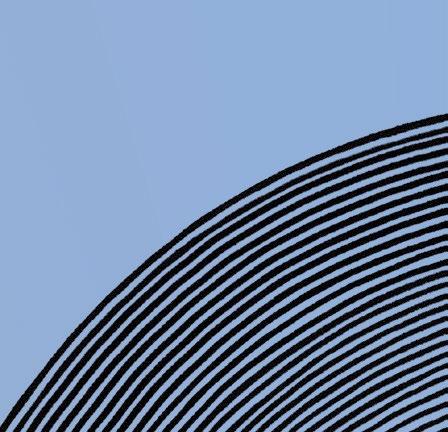

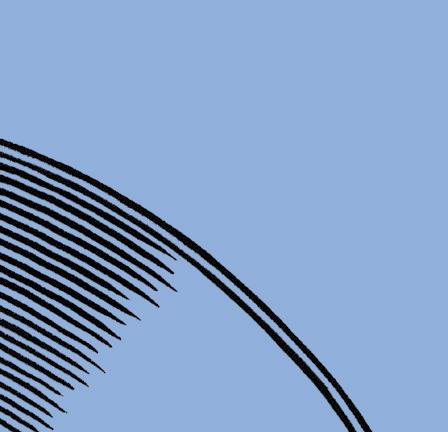



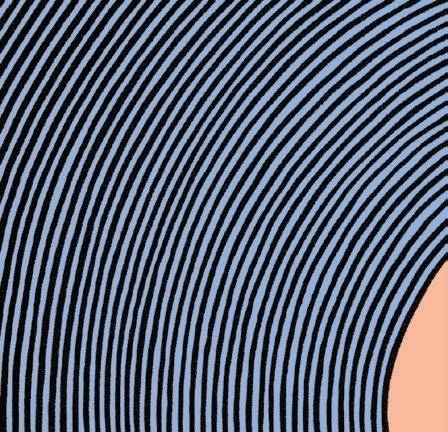
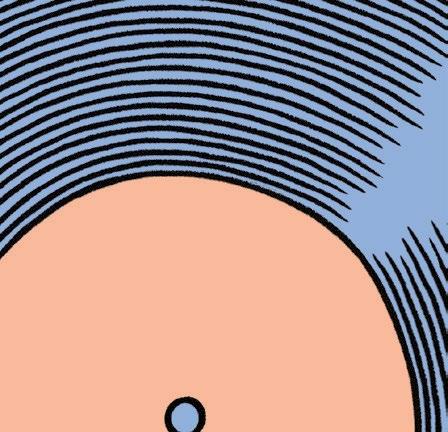
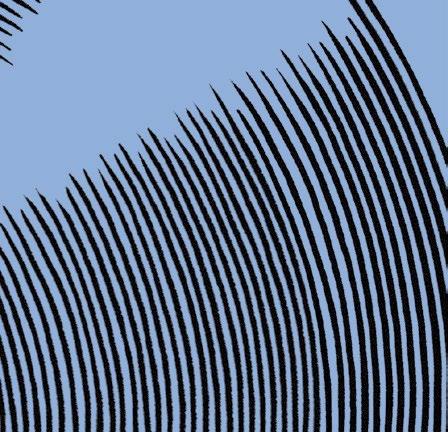

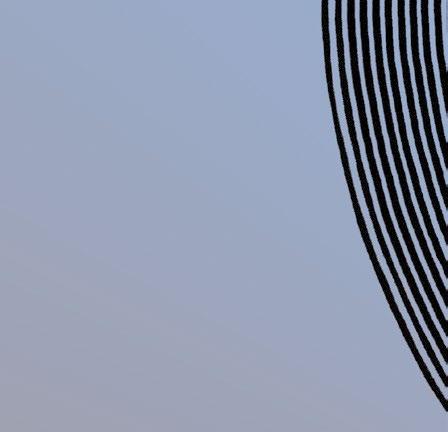

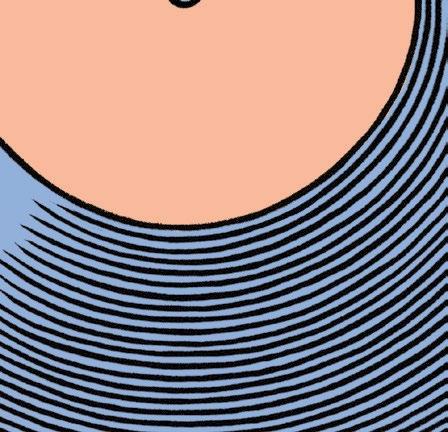
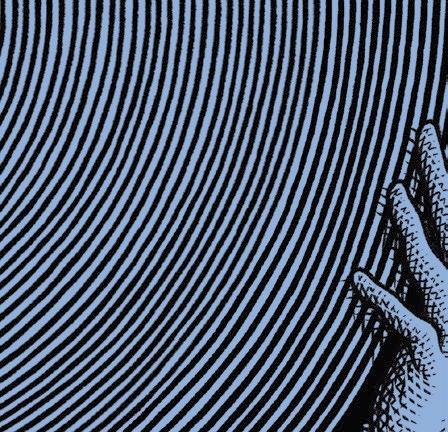
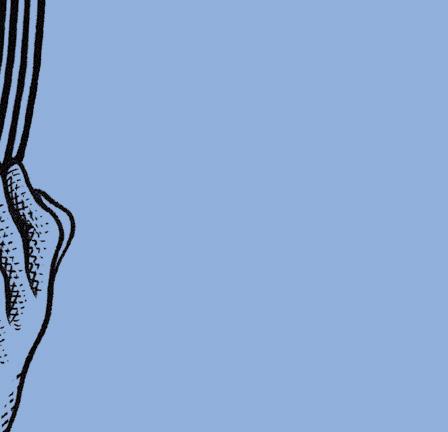




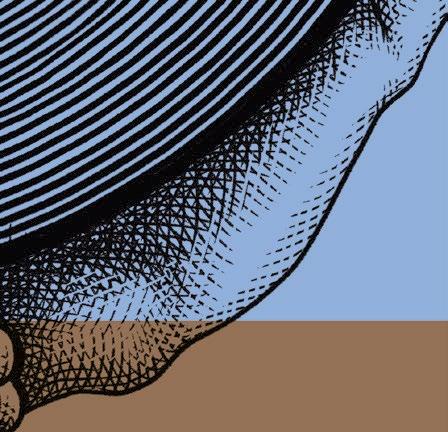



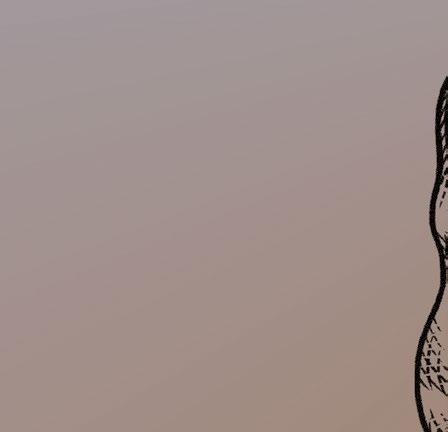
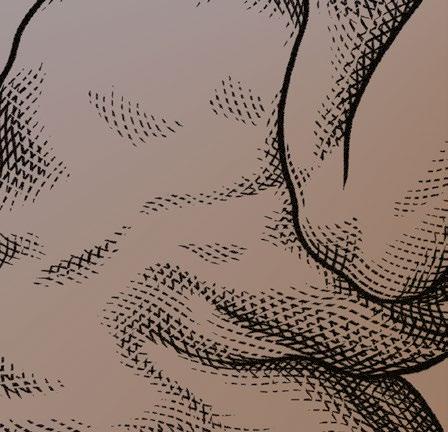
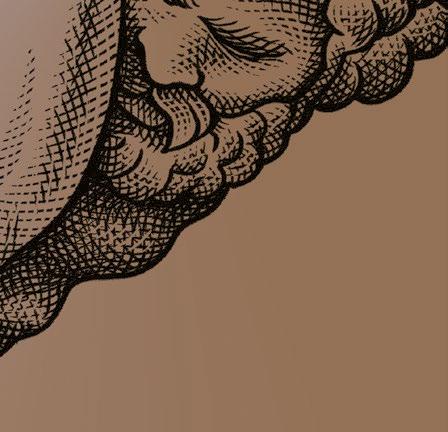




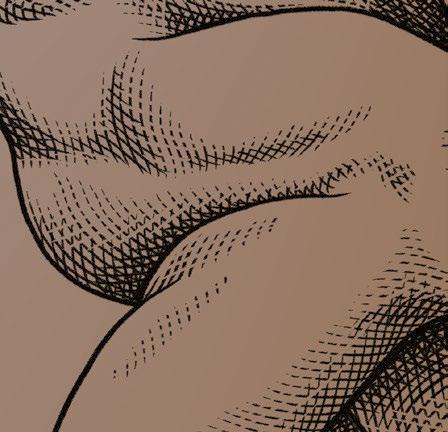






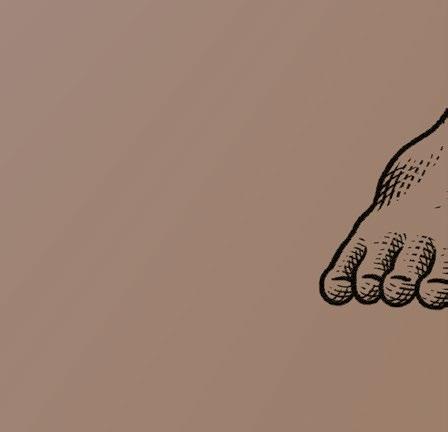




























BASEL MOMENTS SAISON 22/23 SOUND ATLAS Illustration: Janine Wiget @ GROSSE SINFONIK IN SPITZENQUALITÄT 6 KONZERTE AM DONNERSTAG Mit Pekka Kuusisto, Violine Rachel Nicholls, Sopran Yeol Eum Son, Klavier Frank Peter Zimmermann, Violine und vielen mehr www.sinfonieorchesterbasel.ch
EINE NEUE SICHT AUF DIE WELT
Zeitgenössische Kunst hat in Basel schon immer für Stirnrunzeln gesorgt. Elena Filipovic, Direktorin der Kunsthalle Basel, erzählt von irritierten Vätern, zukünftigen Weltstars und von einem Schulausflug, der ihr Leben veränderte. Und sie stellt klar: Die Kunsthalle Basel ist seit 150 Jahren wegweisend für die Kunst des «Jetzt» – eine Tatsache, die wohl überall bekannter ist als in Basel selbst.
Text: Janine Wagner
Bilder: Gina Folly

Kunst auszustellen, die populär ist, weil weltweit anerkannt, teuer gehandelt und heiss begehrt – das ist eine sichere Bank. Ein Risiko aber ist es, Kunst auszustellen, die so noch nie dagewesen ist, von deren Erschafferinnen und Erschaffer man noch nie etwas gehört hat. Seit 150 Jahren geht die Kunsthalle Basel dieses Abenteuer ein. Und ist damit in der internationalen Kunstszene laut Direktorin Elena Filipovic «absolut aussergewöhnlich».
In Basel ist diese Tatsache weniger verbreitet. «Die Kunsthalle Basel ist überall sehr viel bekannter als hier», ist sich Elena bewusst. Seit sieben Jahren ist sie für das Programm und den internationalen Ruf verantwortlich. Sehr viel länger schon weiss sie um das hohe Ansehen des Ausstellungshauses in der Szene. «Wenn du dich in Europa umschaust nach Institutionen, die am Puls zeitgenössischer Kunst arbeiten, dann gelangst du sehr schnell zur Kunsthalle Basel», erzählt sie. Hier wurden schon Paul Klee, Edvard Munch, Emil Nolde, Pablo Picasso, Sophie Taeuber-Arp oder Piet Mondrian gezeigt –lange bevor sie weltweit berühmt waren.
Die zeitgenössische Kunst stiess bei der Basler Bevölkerung immer wieder auf Unverständnis und sorgte für starke Reaktionen. Dass sein Sohn, obwohl noch in der ersten Klasse, ein Konstruktivist sei, steht auf einer Kinderzeichnung, die ein begeisterter Vater 1937 nach dem Besuch der Mondrian-Ausstellung an die Kunsthalle Basel schickte. Nach der Ausstellung von Jackson Pollock 1958 versuchte der damalige Konservator der Kunsthalle das Kunstmuseum vom Kauf eines PollockGemäldes für 12 000 Dollar zu überzeugen. Weil dieser Künstler wichtig sei und dereinst Kunstgeschichte schreiben werde. «Die Antwort war: Nein!», schmunzelt Elena heute. «Das Publikum war erschrocken angesichts dieser Art von Kunst. Und ist es manchmal heute noch. Ich glaube daher, dass es auf der ganzen Welt keine Institution gibt, die in dieser Hartnäckigkeit und Konsequenz getan hat, was die Kunsthalle Basel seit 150 Jahren tut.»
Elena ist sich unterdessen gewohnt, auf Zurückhaltung zu stossen, wenn sie sich nach finanziellen Patenschaften für eine geplante Ausstellung umsieht. Während sie in ihren Anfängen an sich und ihrer Arbeit zweifelte, wenn sie mal wieder vor verschlossenen Türen stand, weiss sie heute: Die Direktoren der Kunsthalle Basel hatten es noch nie leicht. Ihre Überzeugungs-Strategie hat Elena unterdessen angepasst. «Wenn mir heute eine potenzielle Förderin sagt; sorry, aber diese Künstlerin kennt ja keiner, dann sage ich: Genau, und das bedeutet, dass ich meinen Job richtig mache! Diese jetzt noch unbekannte Person erhält durch uns die Chance, der Paul Gauguin oder der Henri Matisse von morgen zu werden. Manchmal komme ich mit dieser Argumentation zum Ziel – manchmal eben nicht.»
51 BASEL MOMENTS
Tatsache ist: In der Kunsthalle Basel begannen unzählige Karrieren und sie tun es bis heute. Für die Besuchenden ist das besonders reizvoll, weil sie live dabei sein können, wenn ein neuer Stern zu leuchten beginnt. Aber auch, weil die Kunstschaffenden fast immer explizit neue gewagte Werke für ihre Ausstellungen in Basel kreie ren. «Das erhöht für uns natürlich das Risiko», erklärt Elena. «Wir müssen ihnen vertrauen, dass sie das bedeutungsvollste, spektaku lärste oder provokanteste Werk ihrer bisherigen Karriere für uns schaffen. Das ist ein bisschen wie Zocken im Casino – hat bisher aber immer funktioniert!» Die Stars von morgen gewinnen durch dieses Vertrauen und die Unterstützung in Basel Selbstbewusstsein. «Sie sehen, dass das, was sie machen, wichtig ist und dass Menschen an sie glauben», so Elena. Die enorme Liste ausgestellter Kunstgrössen spricht jedenfalls Bände: Claude Monet, Vincent van Gogh, Ernst Ludwig Kirchner, Fernand Léger, Miriam Cahn, Fischli/Weiss, Mark Rothko, Jenny Holzer, Jeff Wall, Katharina Fritsch, Cindy Sherman, Mike Kelley, Roni Horn, Ólafur Elíasson, Maurizio Cattelan … Sie alle und noch viele weitere waren hier, als noch kaum jemand sie kannte.
Einige von ihnen haben ihre Spuren in der Stadt hinterlassen, auf die mich Elena auf einem Spaziergang hinweist. Jonathan Borofsky zum Beispiel zeigte einen «Hammering Man» der heute am Aeschenplatz steht, zuvor im grossen Oberlichtsaal der Kunsthalle. Richard Serra hatte hier eine grosse Einzelausstellung, Jahre bevor er der Stadt die Skulptur «Intersection» auf dem Theaterplatz vermachte. Auch der Fasnachtsbrunnen von Jean Tinguely, dessen Idee sich während dem Aufbau seiner Ausstellung in der Kunsthalle manifestierte, oder die Amazone von Carl Burckhardt bei der Mittleren Brücke, welche der Basler Kunstverein in Auftrag gegeben hatte, sind mit der 150 Jahre jungen Institution verknüpft. Im Café Spitz traf sich der Basler Kunstverein, bevor der Architekt Johann Jakob Stehlin das neoklassizistische Gebäude am Steinenberg entwarf. Und eben dieses Gebäude konnte nur gebaut werden dank der Einnah men aus dem Fährbetrieb in einer Zeit, als es am Rheinknie erst eine, die Mittlere, Brücke gab – auch die Basler Fähren sind also wichtiger Teil der KunsthalleGeschichte.
Elena Filipovics Energie und ihre Begeisterung für die Kunst sind so eindrücklich wie mitreissend. Sie brennt für das, was sie tut, man könnte meinen, die Leiden schaft für das Aussergewöhnliche sei in ihrer DNA verankert. In Los Angeles aufgewachsen, kam sie jedoch nicht in ihrem Elternhaus mit Kunst oder Kultur in Berührung. Ein Ausflug war es, der ihr Leben veränderte: «Als ich fünf Jahre alt war, gingen wir mit dem Kindergarten in ein Museum. Es war pure Magie!», erzählt sie mit leuchtenden Augen. «Von da an war ich besessen von Kunst und Museen und ging meiner Mutter so sehr auf die Nerven, dass sie beschloss, mir die echten Museen zu zeigen. In Europa. Um Geld zu sparen, suchte sie sich einen zweiten Job. Im folgenden Sommer sah ich den Louvre zum ersten Mal von innen. Da war ich sechs.»

Seit 20 Jahren lebt Elena Filipovic unterdessen in Europa, wohnte in Paris, Brüssel, Berlin. Klar, hatte sie vor der Kleinstadt Basel erst einmal Respekt. Heute fühlt sie sich in Basel jedoch zu Hause – «oder vielleicht eher: In der Kunsthalle!», ergänzt sie lachend, «ich bin ja physisch und gedanklich meistens hier.» Allerdings habe sie sich in Basel nie wie in der Provinz gefühlt. «Die Kultur macht Basel enorm gross», findet sie. Ob sie im Sommer auch mal in den Rhein hüpfe, will ich von ihr wissen: «Ja!», sagt sie energisch und in gepflegtestem Deutsch: «Natürlich!» Sie versteht prima Deutsch unterdessen, antwortet aber lieber auf Englisch. In der Muttersprache erzählt es sich einfach besser.
Und erzählen kann Elena viel. Zum Beispiel davon, wie sie die Stars von morgen findet. «Das ist ein bisschen, wie die grosse Liebe zu finden – du weisst nie, wo sie sich versteckt!» Das Problem sei aber weniger, auf talentierte Künstlerinnen und Künstler zu stossen. «Die wahre Kunst ist es, den richtigen Zeitpunkt zu finden, an dem Kunstschaffende bereit sind für die Kunsthalle. So dass eine Ausstellung bei uns das Beste aus ihnen hervorbringt und sie nicht unter dem Gewicht der Aufgabe zerbrechen. Diesen Punkt zu finden ist heikel und reine Intuition.»
«Bis heute ist die Kunsthalle ein Ort, an dem du nie weisst, worauf du dich als Nächstes einlässt. Du siehst aber garantiert immer etwas, das dich zum Nachdenken anregt – ungeachtet dessen, obs dir nun gefällt oder nicht», ist sich Elena sicher. Ob sie noch nervös sei vor einer neuen Ausstellung, will ich von ihr wissen. «Ich bin immer nervös!», lacht sie. Und wird dann nachdenklich. «Auch weil wir gerade zwischen Krieg, ökologischer und humanitärer Krise leben und man sich natürlich fragen kann, was Kunst hier noch auszurichten imstande ist. Dennoch bin ich jeden Tag von Neuem überzeugt davon, dass Kunst eine riesengrosse Rolle spielt. Weil die zeitgenössischen Kunstschaffenden unsere Gedanken provozieren, unsere Herzen, unseren Geist. Weil sie unsere Sichtweise auf die Welt verändern.»
«Die wahre Kunst ist es, den richtigen Zeitpunkt zu finden, an dem Kunstschaffende bereit sind für die Kunsthalle.»
Steinenberg 7 – kunsthallebasel.ch KUNSTHALLE BASEL 52

BASEL MOMENTS
Contemporary art has always been a bit frowned upon in Basel. Elena Filipovic, the director of the Kunsthalle Basel, tells tales of irritated fathers, soon-to-be international stars and a school outing that changed her life. And she makes one thing very clear: The Kunsthalle Basel has been a pioneer in the art of “now” for 150 years – a fact that is probably better known almost everywhere than in Basel itself.

Exhibiting art that is popular because it is internationally recognised, sells at a high price and is in great demand – now that’s a safe bet. But exhibiting art that has never been seen before, by artists whose names no-one has heard of, that’s taking a risk. And for 150 years now, the Basel Kunsthalle has been going out on the limb like this. Which makes it “absolutely exceptional” in the international art scene according to its director, Elena Filipovic.
In Basel this fact is not so well known. “The Basel Kunsthalle is much more famous everywhere else than it is here”, Elena is very aware of this fact. She has been responsible for its program and international reputation for seven years now. But she has been aware of the exhibition hall’s excellent reputation in the art scene for much longer. “If you look around Europe for institutions that are working with their finger on the pulse of contemporary art, then you will find the Basel Kunsthalle very quickly”, she explains. Paul Klee, Edvard Munch, Emil Nolde, Pablo Picasso, Sophie Taeu ber-Arp and Piet Mondrian were all exhibited here –long before they became world famous.

Contemporary art has been repeatedly met with incomprehension by the people of Basel and has also provoked some strong reactions. In 1937, after visiting the Mondrian exhibition, a “proud” father sent his son’s drawing to the Kunsthalle, with a note on the drawing that the child was a “constructivist” although still in the first grade at school. After the Jackson Pollock exhibition in 1958, the curator of the Kunsthalle at the time, tried to convince the Basel Art Museum to buy a Pollock painting for 12,000 dollars; because he was an important artist and would one day write art history. “The answer was: No!”, Elena now smiles. “The public were shocked by this kind of art. And it is still like that sometimes nowadays. Which is why I think there is not another institution in the whole world that has shown such tenacity and consistency in doing it does as the Kunsthalle Basel over the last 150 years.”
Elena has got used to encountering reluctance when she starts looking around for financial sponsorship for an exhibition she is planning. In the early days she was plagued with doubt about herself and her work, when yet again faced with closed doors, but now she is well aware: The directors of the Kunsthalle Basel never had an easy time of it. And in the meantime, Elena has modified her strategy to convince donors. “Nowadays, when a potential sponsor says; sorry, but nobody has ever heard of this artist, then I reply: Precisely, and that means I am doing my job properly! Because this completely unknown person is going to be given the chance to be the Paul Gauguin or Henri Matisse of tomorrow. Sometimes I achieve my goal with this line of reasoning – but sometimes not.”
“The cultural life here makes Basel huge.”
54 BASEL MOMENTS
A NEW WAY OF LOOKING AT THE WORLD
And the fact is: Countless careers have been launched at the Basel Kunsthalle and still are these days. For the visitors this is particularly fascinating, because they are there to witness live when a new star is beginning to shine. But also because the artists almost always create new and daring works specifically for their exhibitions in Basel. “Of course, that makes it riskier for us”, explains Elena. “We have to believe in them, that they are going to create the most significant, spectacular or provocative piece in their career so far, for us. It’s a bit like gambling in a casino – but it’s always worked out well so far!” The stars of tomorrow gain confidence from the trust and support they are given in Basel. “They see that what they are doing is important and that people believe in them”, says Elena. In any case, the formidable list of major artists who have been shown here speaks volumes: Claude Monet, Vincent van Gogh, Ernst Ludwig Kirchner, Fernand Léger, Miriam Cahn, Fischli/Weiss, Mark Rothko, Jenny Holzer, Jeff Wall, Katharina Fritsch, Cindy Sherman, Mike Kelley, Roni Horn, Ólafur Elíasson, Maurizio Cattelan … were all here, and many more, when hardly anyone had even heard of them.
Some of them have left their traces in the city, and Elena points them out to me as we take a stroll together. Jonathan Borofsky, for example, exhibited a “Hammering Man”, which now stands at the Aeschenplatz, but was previously in the spacious glass-roofed hall of the Kunsthalle. Richard Serra had a major solo exhibition here, years before he donated his “Intersection” sculpture, now at the Theaterplatz, to the city. Also linked to this still-fresh 150-year-old institution are the Carnival Fountains by Jean Tinguely, who had the idea for them while setting up his exhibition in the Kunsthalle, and Carl Burckhardt’s Amazon standing next to the Mittlere Brücke, which was commissioned by the Basel Kunstverein. This Basel Kunstverein, an association of artists and art-lovers, used to meet at the Café Spitz, before the architect Johann Jakob Stehlin designed the neo-classical building on the Steinenberg. And the const ruction of this building was only possible thanks to the revenue from the ferry services, at a time when there was only one bridge at the “knee of the Rhine” – the Mittlere Brücke. The Basel ferries are also an important part of the Kunsthalle’s history.

Elena Filipovic’s energy and her enthusiasm for art are as impressive as they are captivating. She is consumed with what she does, you could almost imagine that her passion for the extraordinary is somehow written into her DNA. She grew up in Los Angeles, but it wasn’t at home that she came into contact with art and culture. It was an excursion that changed her life: “When I was five years old, we went to a museum with my kindergarten. It was pure magic!”, she tells me, her eyes shining. “From that moment on, I was obsessed with art and museums and I got on my mother’s nerves so much that she decided to show me the real museums. In Europe. To save enough money for the trip she took a second job. The following summer, I saw the Louvre from the inside for the first time. I was six years old.”
Elena Filipovic has been living in Europe for 20 years now, in Paris, Brussels, Berlin. At the beginning of course she was a bit worried about moving to a town as small as Basel. But nowadays she feels at home here – “or perhaps I should say, at the Kunsthalle!”, she adds laughing, “I am usually here, in body and spirit.” Mind you, she has never felt as though she is living in the provinces here in Basel. “The cultural life here makes Basel huge”, she says. I ask her whether she ever leaps into the Rhine in the summer: “Yes!”, she says vigorously and then in perfect German: “Natürlich!” She now understands German very well, but prefers to answer in English. It’s just easier to talk about things in your native tongue.
And Elena has plenty to tell. For example, how she discovers the stars of tomorrow. “It’s a bit like finding true love – you never know where it’s going to be hiding!” But the problem is not finding talented artists. “The real skill is identifying the right moment, when the artists are ready for the Kunsthalle. So that an exhibition with us brings out the best in them and they don’t collapse under the weight of the task. It’s tricky to pinpoint that moment and it’s a matter of pure intuition.”
“Even now, the Kunsthalle is a place where you never know what you are going to get yourself involved in next. But you will always definitely see something that gets you thinking – regardless of whether you like it or not”, Elena is quite sure about that. I want to know whether she is nervous before a new exhibition starts. “I’m always nervous!”, she laughs. And then she becomes thoughtful. “And because we are currently surrounded by war, ecological and humanitarian crises, of course you can start asking yourself what the point of art is under the circumstances. Nevertheless, I am convinced, each and every day, that art does have an enormous role to play. Because contemporary artists provoke thoughts, our hearts, our minds. Because they change the way we look at the world.”
55 BASEL MOMENTS
neu kombiniert schmeckt einfach besser.
Rheingasse 12, 4058 Basel, T +41 61 690 91 30 restaurant@krafftbasel.ch, www.krafftbasel.ch/restaurant
GENIESSEN STAUNEN, LERNEN &
Wer in Basel haltmacht, kommt um Kunst und Kultur nicht herum. Der Besuch von mindestens einem Museum – am besten jedoch von zwei, drei oder sogar zehn – wird deinen Basel-Aufenthalt nachhaltig prägen!
KUNSTHALLE BASEL
Reflektieren und debattieren erwünscht Steinenberg 7 – kunsthallebasel.ch

Ums Diskutieren kommst du in der Kunsthalle nicht herum: Hier wird nämlich nicht nur zeitgenössische Kunst ausgestellt, sondern bereits seit der Muse ums-Gründung 1872 auch reflektiert und debattiert. Aufsehenerregende Ausstellungen, Künstlergespräche, Performances und Filmvorführungen unterstützen den Diskurs an diesem überaus spannenden Begegnungsort.
You cannot evade a discussion at the Kunsthalle: from the moment the museum was founded in 1872, it was never a place where contemporary art was just exhibited, but also reflected upon and debated. Spectacular exhibitions, talks by artists, performances and film screenings all foster the discourse at this incredibly intriguing meeting place.
FONDATION BEYELER
Kunst, Ruhe & Ausblick Baselstrasse 101 / Riehen – fondationbeyeler.ch

Warum du die Fondation Beyeler regelmässig besuchen solltest? Weil ein Besuch dieses Hauses Wellness ist für deinen Geist. Das liegt an den hellen, ruhigen Räumen des Gebäudes von Renzo Piano, am Blick ins Grüne und natürlich an den spektakulären Ausstellungen. Entspann dich und gönn dir etwas Zeit für dich.
Why should you visit the Fondation Beyeler regularly? Because a visit to this museum is balm to the spirit. Thanks to the bright, peaceful rooms of the buil ding designed by Renzo Piano, the view out into the countryside and of course the spectacular exhibitions. Relax and take some time to treat yourself.
VITRA DESIGN MUSEUM

Im Mekka des Möbeldesigns Charles-Eames-Str. 2 / Weil am Rhein – design-museum.de
Hier triffst du auf Frank Gehry, Verner Panton, Renzo Piano, Charles Eames, Zaha Hadid oder Jean Prouvé – hier küssen sich Design, Architektur und Kunst. Das Vitra zählt zu den weltweit führenden Designmuseen, ist eine Forschungsstätte des modernen Möbeldesigns. Die Sammlung umfasst rund 20 000 Objekte, 400 davon werden im Schaudepot präsentiert, hinzu kommen wechselnde Ausstellungen.
You will encounter Frank Gehry, Verner Panton, Renzo Piano, Charles Eames, Zaha Hadid and Jean Prouvé here – design, architecture and art intertwined. Vitra is conside red one of the world’s leading design museums and it is a research centre for modern furniture design. The collection comprises around 20,000 objects, 400 are exhibited in the show warehouse, complemented by the series of temporary exhibitions.
57
KUNSTMUSEUM BASEL

Zeitreise durch die Kunstgeschichte St. Alban-Graben 16 (Haupt- und Neubau) St. Alban-Rheinweg 60 (Gegenwart) – kunstmuseumbasel.ch

Drei Häuser – eine Institution: Im Hauptbau und Neubau des Kunstmuseum Basel findest du Werke von Holbein über Böcklin bis van Gogh, Picasso, Klee, Rothko, Warhol, Beuys oder Richter, viele davon stammen aus der Öffentlichen Kunst sammlung Basel, die mit dem 1661 angekauften Amerbach-Kabinett ihren Anfang nahm. Die Kunst der Gegenwart wird seit 1980 am St. Alban-Rheinweg gezeigt. Ein kulturelles Muss – auch wegen der Architektur!
Three buildings – one institution: In the main building and the new building of the Kunstmuseum Basel you will find works by Holbein and Böcklin through to van Gogh, Picasso, Klee, Rothko, Warhol, Beuys and Richter, many of them from the public art collection of Basel, which was launched in 1661 with the purchase of the Amerbach Cabinet.
HISTORISCHES MUSEUM BASEL
Geschichte erleben
Im Lohnhof 9 / Barfüsserplatz 7 / Elisabethenstrasse 27 – hmb.ch
Der Lohnhof, das Haus zum Kirschgarten und die Barfüsserkirche: Das Historische Museum Basel ist nicht nur in denkwürdigen drei Gebäuden untergebracht, es hat auch Denkwürdiges zu bieten: Die grösste Musikinstrumentensammlung der Schweiz, die prächtigsten Basler Innenräume des 18. Jahrhunderts und Spannendes zur Stadtgeschichte.

The Lohnhof, the Haus zum Kirschgarten and the Barfüsser church: the Historical Museum in Basel is not only housed in three memorable buildings, it also has a wide range of memorable exhibits: the largest collection of musical instruments in Switzerland; the most magnificent Basel interiors dating from the 18th century; and exciting details from the city’s history.
Archiv des Lebens Augustinergasse 2 – nmbs.ch
Es ist vor allem der Sammelleidenschaft des Basler Bürgertums zu verdanken, dass das Naturhistorische Museum Basel heute über rund 11 Millionen Objekte und somit über ein einzigartiges Gedächtnis der Welt verfügt. In Ausstellungen und Veranstaltungen wird das Wissen über Zoologie, Mineralogie, Anthropologie oder Paläontologie Gross und Klein weitergegeben.
It is mainly thanks to the Basel bourgeoisie’s passion for collecting that the Natural History Museum in Basel now has around 11 million objects and with them a unique memory of the world. Knowledge of zoology, minerology, anthropology and palaeontology is shared with young and old, in exhibitions and events.
MUSEUM DER KULTUREN BASEL

Für mehr Kultur-Verständnis Münsterplatz 20 – mkb.ch
«Die Welt mit anderen Augen sehen», so das Motto vom Museum der Kulturen Basel (MKB). Es ist eines der bedeutendsten ethnologischen Museen Europas und besitzt mit der Sammlung von über 340 000 Objekten, rund 50 000 historischen und etwa 200 000 dokumentarischen Fotografien einen wahren Kultur-Schatz. Ums Reflektie ren und neu Interpretieren kommst du hier nicht herum – gut so, denn nur so kannst du das Verständnis für deine wie auch für andere Kulturen fördern.
“Seeing the world through other eyes” is the motto of the Museum der Kulturen Basel (MKB). It is one of the most important ethnological museums in Europe and possesses a veritable cultural treasure trove, including more than 340,000 objects, around 50,000 historical and 200,000 documentary photographs. You will certainly take pause for thought and find new interpretations here – which is good, because that is the only way to promote understanding of your own and other cultures.
NATURHISTORISCHES MUSEUM
58
ANTIKENMUSEUM
Von früher lernen St. Alban-Graben 5 – antikenmuseumbasel.ch
Von 5000 Jahren Kultur können wir einiges lernen – so wird denn auch hier die Antike als Fundament und Anregung für die Gegenwart verstanden. In spannen den Ausstellungen und Veranstaltungen werden die Kulturen Ägyptens, des Vorderen Orients, Griechenlands und Italiens lebendig.
We can learn a lot from cultures that flourished 5,000 years ago – and at this museum antiquity is seen as the foundation and inspiration for the present. The exciting exhibitions and events bring to life the cultures of Ancient Egypt, the Near East, Greece and Italy.

Kunst für alle Sinne Paul Sacher-Anlage 2 – tinguely.ch

Im Museum Tinguely am Rheinufer findest du die weltweit grösste Werksammlung von Jean Tinguely – 218 Skulpturen, mehr als die Hälfte davon sind permanent ausgestellt. Zudem finden immer wieder spektakuläre Ausstellungen von Künst lern des 20. und 21. Jahrhunderts statt. Spannend auch für Kinder, da hier immer etwas rattert und sich bewegt.
At the Tinguely Museum, on the banks of the Rhine, you will encounter the largest collection of Jean Tinguely’s works anywhere in the world – 218 sculptures, more than half of them on display in the permanent exhibition. In addition, there are plenty of spectacular exhibitions of artists from the 20th and 21st centuries. Exciting for children too, because there are plenty of exhibits that rattle and move.
TINGUELY HEK
Abstrakt? Mitten aus dem Leben! Freilager-Platz 9 – hek.ch

Seit zehn Jahren befasst sich das Haus der elektronischen Künste (HeK) mit technologischen Entwicklungen, die unser Leben verändern. Die Ausstellungs-Titel klingen zwar meist abstrakt, die Themen sinds jedoch nicht: Es geht um drängende Umweltfragen, künstliche Intelligenz, interaktive Mode oder Virtual Reality.
For ten years now the House of Electronic Arts (HeK) has been delving into the technological developments that have a profound effect on our lives. The titles of the exhibitions usually sound quite abstract but the content is not: they deal with urgent climate issues, artificial intelligence, interactive trends and virtual reality.
MUSEUM
59 BASEL MOMENTS
DER MANN, DER UNSER VISUELLES

GEDÄCHTNIS PRÄGTE
Einer der grössten Schweizer Grafiker gestaltete in Basel weltweit bekannte Plakate; Celestino Piatti. Auch wer seinen Namen nicht kennt, kennt doch seine Bildsprache und garantiert seine Eulen. Bis heute sieht es in Piattis Atelier in der St. Johanns-Vorstadt so aus, als würde er sich gleich wieder zum Zeichnen an den Tisch setzen.
Text
& Bilder: Janine Wagner
© Verein «Celestino Piatti –das visuelle Erbe» 60 BASEL MOMENTS
Die Kartonschachteln stapeln sich im Atelier von Celestino Piatti. Darin haufenweise beschriftete Mappen. «Frauenverein Basel» steht drauf, «Mon Chérie» oder «Pro Juventute». Weitere Kisten sind angeschrieben mit «Verbrauchte Stifte», «Zu Sortieren» oder der ganz lapidar mit «Mumpitz».


Der Föhn, den Celestino Piatti jeweils benutzte, um die aufgemalten Farben für die Weiterarbeit möglichst schnell trocken zu kriegen, liegt noch im Regal. Model Solis, tiefe 70er-Jahre. Dazwi schen Pinsel, Farbkarten, Tintenfässchen, Zündholzschachteln, stapelweise Papier, kleine Zeichnungen und Skizzen. Eulen, immer wieder Eulen.
Celestino Piatti ist vor 15 Jahren gestorben. In seinem Atelier sieht es aus, als hätte er gestern noch hier gesessen, auf seinem abgewetzten Ledersessel am Pult, hätte auf den Rhein geschaut, gezeichnet und gemalt. Hier betritt man eine – leider nicht öffentlich zugängliche – Schatzkiste. Darf in kleinen Schubladen kramen, in Schachteln wühlen und Ablagen durchforsten. Laufend entdeckt man Neues, Spannendes, Witziges.
Selbst seine Familie hat noch längst nicht alles gesichtet. Weder im Atelier in der St. Johanns-Vorstadt, das voll ist bis unter die Decke, noch in der alten Lagerhalle im Baselbiet mit ungezählten Zeichnungen, Lithografien, Plakaten, Skizzen und Briefen. Celestino Piattis Tochter Barbara geraten ständig neue Blätter in die Finger, Erinnerungen an ihren Vater und sein rund 70jähriges Berufsleben. Es ist ein Kulturerbe, das sie gerade mit ihrer Familie bearbeitet. Und dabei laufend in die eigene Vergangenheit reist.

«Es ist fast erschlagend, wie produktiv er war.»

Celestino Piatti war ein Arbeitstier. Immer wieder lud er sich ein enormes Pensum und Termindruck auf, legte Nachtschichten ein, ermöglichte das Unmögliche. «Er hat seine Arbeit wahnsinnig geliebt, war unglaublich fleissig. Aber er war kein guter Organisator», weiss Barbara Piatti rückblickend. «Wir finden viele Kisten, in die er sämtliches Material eines Auftrages reingeworfen hat. Skizzen, Korrespondenz, Korrekturen und Notizen wie «noch abrechnen?» – durch die Masse an Arbeit wusste er oft nicht, ob er schon Rechnung gestellt hatte. Archivieren, ordnen und planen war nicht seins. Aber es ist fast erschlagend, wie produktiv er war.» Dabei war Piatti ein Perfektionist. Selbst nach 30 Jahren Arbeit beim dtv korrigierte er jedes kleinste Detail. Falsche Wortabstände oder unpassende Farbtöne liess er nicht durchgehen. «Wo man doch denken könnte, mein Gott, es ist der 6000ste Umschlag, lass gut sein», schmunzelt seine Tochter heute.
Laufend kramt sie während des Erzählens neue Blätter mit Skizzen und Ideen hervor. Vieles sieht sie selber zum ersten Mal, lächelt, hält kurz inne, taucht weiter ein. Berichtet dabei zum Beispiel vom legendären Basler Café Spillmann, in dem sich ihr Vater und ihre Mutter zum ersten Mal gesehen und sofort ineinander verliebt hatten. Vom Geruch von Cementit, der sie bis heute an ihren Vater erinnert. Von Ausflügen und Reisen. «Es hat meinen Vater immer wieder ans Meer gezogen, um zu zeichnen», erwähnt sie. «Es gibt unglaublich viele Zeichnungen mit Schiff-Motiven, Fischkuttern und Hafenszenen.»
«Seine letzten Aufträge sind aus dem Jahr 2005 –da war er 83 Jahre alt.»
«Eigentlich hat er gar nie aufgehört zu produzieren», erzählt Barbara Piatti im Gespräch, «seine letzten Aufträge sind aus dem Jahr 2005 – da war er 83 Jahre alt.» Im Januar 2022 wäre Celestino Piatti 100 Jahre alt geworden. 2019 begann seine Familie gemeinsam mit Fachleuten und Freunden, sein immenses Schaffen zu sichten und zu sortieren. Gründete den Verein «Celestino Piatti – das visuelle Erbe» mit dem Ziel, das Werk des international renommierten Illustrators und Grafikers der Öffentlichkeit zugänglich zu machen. Bis heute liegen Tausende Zeichnungen, Skizzen, Entwürfe und Briefe ungesehen in fein säuberlich angeschriebenen Kisten herum. Piattis Hinterlassen schaft ist unfassbar umfangreich.
«Hinter jeder Grafik standenunzählige Studien und Entwürfe.» Barbara Piattis Schilderungen lassen das Bild eines gutmütigen, bescheidenen Mannes entstehen. Eines Familienmenschen, der gerne Zeit mit seinen Kindern in der Natur verbrachte, für sie Geschichten zeichnete und dessen Atelier-Türe immer offenstand. Den Rummel um seine Person nahm er zwar billigend in Kauf, viel wohler fühlte er sich jedoch an seinem Arbeitstisch. Und doch, «obwohl er sein Handwerk beherrschte wie kaum ein anderer, fiel ihm nichts in den Schoss», ist sich Barbara heute bewusst. «Hinter jeder Grafik standen unzählige Studien und Entwürfe.» Beim Blick ins Basler Atelier wird schnell klar: Jeder Strich liegt noch in irgendeiner Kiste.

Mit seinen Plakaten, Skulpturen, Büchern, Lithografien, Zeich nungen und Buchumschlägen hat Celestino PIatti das visuelle Gedächtnis der Menschen beeinflusst. Seine Hinterlassenschaft ist ein gestalterisches Universum, darin einzutauchen weckt Erinnerungen und beflügelt. Den wahren Umfang dieses Universums – oder die ungefähre Anzahl der herumflatternden Piatti-Eulen – wird zumindest die Öffentlichkeit kaum je erfassen.

62 BASEL MOMENTS
ZUM LEBEN UND SCHAFFEN VON CELESTINO PIATTI

Celestino Piatti kam am 5. Januar 1922 als Sohn eines Tessiner Steinhauers und einer Zürcher Bauerntochter zur Welt. Er machte seine Ausbildung zum Grafiker in Zürich und kam 1944 für seine erste und einzige Anstellung als Werbegrafiker nach Basel. Bereits 1948 – mit 26 Jahren – machte er sich selbst ständig. Fortan warb er für Konsumgüter von Rolex, Campari, Knorr, Sandoz oder Pfizer. Aber auch für die Einführung des Frauenstimmrechts, gegen Atomstrom oder gegen das Tragen von Pelz. Es war ihm ein Bedürfnis, sich mit seinen Mitteln für humanitäre Anliegen und für den Schutz von Tier und Umwelt einzusetzen. Zwischen 1961 und 1992 gestaltete er über 6300 Buchumschläge für den dtv in München. Daneben illustrierte er sieben Kinderbücher, machte Ausstellungen, kreierte über 500 Plakate. Piattis Kunst ist bis heute weltweit bekannt und gefragt. Am 17. Dezember 2007 verstarb Celestino Piatti. Seine drei Töchter und seine zweite Frau leben nach wie vor in Basel und der Region. Zu Ehren seines 100. Geburts tags sind mehrere Publikationen erschienen: Ein Bildband zu Leben und Werk mit dem Titel «Celestino Piatti. Alles, was ich male, hat Augen», eine Gesamtausgabe der berühmten Bilder bücher («Piatti für Kinder») und eine mehrbändige Sonderedition bei dtv.
celestino-piatti.ch

63 BASEL MOMENTS
© Verein «Celestino Piatti –das visuelle Erbe»
THE MAN WHO SHAPED OUR VISUAL MEMORY
One of Switzerland’s greatest graphic artists created posters in Basel that were famous all over the world; Celestino Piatti. Even people who haven’t heard of him will recognise his visual imagery and definitely his owls. And Piatti’s studio in St. Johanns-Vorstadt still looks exactly as though he is just about to sit down at his table to start drawing again.
There are heaps of cardboard boxes in Celestino Piatti’s studio. Containing labelled portfolios by the dozen. The titles, “Women’s Association Basel”, “Mon Chérie” or “Pro Juventute”. Other boxes are marked with “used pencils”, “to be sorted” or very succinctly “rubbish”. The hairdryer that Celestino Piatti always used to dry the colours he had painted as quickly as possible so he could continue working, is still lying on the shelf. A Solis hairdryer, straight from the depths of the 1970s. Strewn around, paintbrushes, colour cards, inkwells, matchboxes, heaps of paper, little drawings and sketches. And owls, owls and more owls.
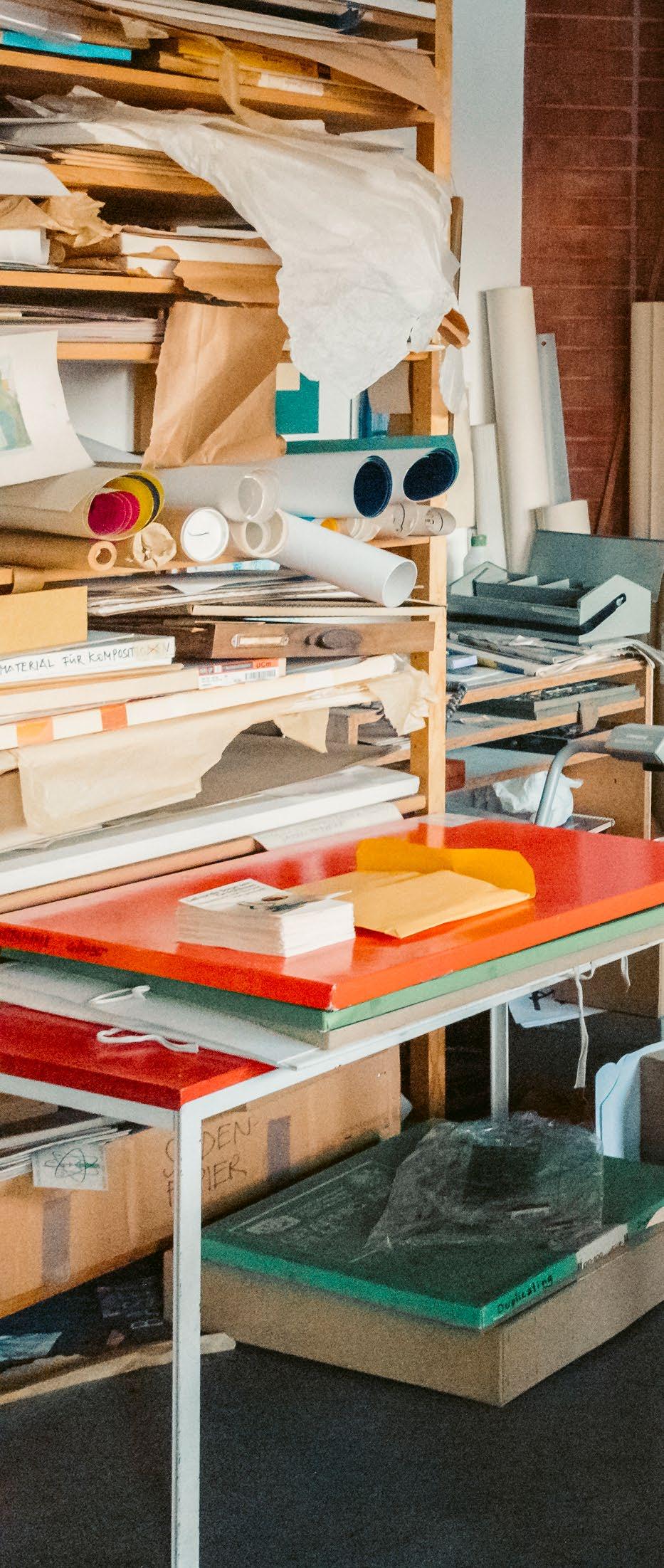
Celestino Piatti died 15 years ago. But in his studio, it looks as though he was still sitting here yesterday, on the worn leather chair pulled up to his desk, gazing at the Rhine, sketching and painting. When you walk into this room, you enter a treasure chest, although unfortunately it is not open to the general public. You can rummage in little pigeonholes, root around in boxes and comb through trays; constantly discovering something new, exciting or amusing.
Not even his family have looked through anywhere near everything. Neither in the studio in the St. Johanns-Vorstadt, which is packed full of things, up to the ceiling, nor in the old warehouse outside Basel containing countless drawings, lithographs, posters, sketches and letters. Celestino Piatti’s daughter Barbara constantly finds herself holding new pages, mementoes of her father and his career spanning almost 70 years. It is a cultural inheritance that she is currently working through with her family. And constantly delving back into her own past at the same time.
His last assignments were in 2005 – when he was 83 years old. “Actually, he never stopped being productive”, explains Barbara Piatti during our conversation, “his last assignments were in 2005 – when he was 83 years old.” In January 2022 Celestino Piatti would have celebrated his centenary. In 2019 his family, with experts and friends, began to sift through and sort out his immense body of work. They founded an association, “Celestino Piatti – the visual heritage” with the aim of making the work of this internationally renowned illustrator and graphic designer available to the general public. There are still thousands of drawings, sketches, drafts and letters lying around unseen in neatly labelled boxes. Piatti’s legacy is absolutely vast.
It is quite staggering, how productive he was.
Celestino Piatti was a workaholic. Time and again he burdened himself with enormous workloads and deadline pressures, worked night shifts, made the impossible possible. “He loved his work to distraction and was unbelievably hardworking. But he was not a good organiser”, Barbara Piatti realises that now, with hindsight. “We are finding a lot of boxes where he has simply thrown in everything to do with an assignment. Sketches, correspondence, corrections and notes such as “submit an invoice?” – the sheer mass of his work meant that he often didn’t know whether he had sent a bill or not. Archiving, sorting out and planning were not his strong points. But it is quite staggering how productive he was.” At the same time, Piatti was a perfectionist. Even after 30 years of working at dtv he corrected even the tiniest details. He never let a single wrong word-spacing or wrong colour tone slip through. “Whereas you might think, my God, it’s the six-thousandth book cover, let’s just leave it”, his daughter smiles today.
While telling us all this, she is constantly pulling out new sheets of paper covered in sketches and ideas. She herself is also seeing a lot of these things for the first time, she smiles, pauses, dives in again. She tells us, for example, about the legendary Café Spillmann in Basel, where her father and mother caught sight of each other for the first time and immediately fell in love. Or the smell of the glue Cementit, which still reminds her of her father today. About excursions and journeys. “My father always felt drawn back to the sea, to sketch”, she mentions. “There are an incredible number of drawings depicting ships, fishing boats and harbour scenes.”
64 BASEL MOMENTS
Behind each print were countless studies and drafts. Barbara Piatti’s accounts create the image of a goodnatured, modest man. A family man who enjoyed spending time with his children out in the countryside, who drew stories for them and for whom the door of his studio was always open. Although he accepted the fuss surrounding his person, he felt much more comfortable at his work table. And yet “although he mastered his craft better than almost anyone else, nothing just fell into his lap”, Barbara has now realised. “Behind each print were countless studies and drafts.” A glance into the Basel studio quickly reveals: Every stroke is still lying in a box somewhere or other.
Celestino Piatti’s posters, sculptures, books, lithographs, drawings and book covers have influenced people’s visual memories. His legacy is an artistic universe, immersing yourself in it awakens memories and is inspiring. The true scale of this universe – or the approximate number of Piatti’s owls – will probably never be fully appreciated, at least not by the general public.
THE LIFE AND WORK OF CELESTINO PIATTI

Celestino Piatti was born on 5 January 1922, his father a stone carver from the Ticino and his mother the daughter of a farmer from Zurich. He trained as a graphic designer in Zurich and came to Basel in 1944 for his first and only position as a graphic designer in advertising. In 1948 – at the age of 26 – he already began to work as a freelancer. He started working on advertising for consumer products by Rolex, Campari, Knorr, Sandoz and Pfizer. But also for the campaigns for women’s right to vote, against atomic energy and against wearing fur. He felt the urge to employ his resources to further humanitarian causes and for the protection of animals and the environment. Between 1961 and 1992 he designed over 6,300 book covers for the dtv (German publisher) in Munich. In addition, he illustrated seven children’s books, held exhibitions, created over 500 posters. Piatti’s art is still famous and in demand all over the world. Celestino Piatti died on 17 December 2007. His three daughters and second wife all still live in Basel and the area around it. Several books have been published in honour of his centenary: An illustrated book on his life and work with the title “Celestino Piatti. Everything I paint has eyes”, a complete edition of his most famous story books (“Piatti for children”) and a special edition in several bands published by dtv.
celestino-piatti.ch
65
#L OVEYOURCITY
Aus Liebe zur Basler City entstanden, mit Leidenschaft und Gefühl für unsere Stadt kreiert und durch authentische und emotionale Geschichten bereichert.

Born out of love for Basel City, created with passion and devotion to our town and enriched with authentic and emotional stories.


SHARE YOUR MOMENTS IMPRINT
PUBLISHER
StadtKonzeptBasel Grenzacherstrasse 79 4058 Basel
PRINT
Printed in Switzerland Birkhäuser+GBC AG
GET YOUR INSPIRATION
stadtkonzeptbasel.ch basellive.ch loveyourcity.ch
CONTENT
StadtKonzeptBasel / BaselLive
Translation: Jane Wolff
Proof Reading: Friedrich Reinhardt Verlag
DESIGN
Das Atelier Basel dasatelier-basel.com
© 2022 StadtKonzeptBasel EDITION 03 – 2022/23
Ihr Partner für neue Perspektiven.
Basel | Zürich | Olten baumann-banquiers.ch

03-2022















 AHOI AHOI
AHOI AHOI














 Theatertrasse 7 – theater-basel.ch
Theatertrasse 7 – theater-basel.ch
































 AU VIOLON
AU VIOLON


 KRAFFT
KRAFFT

 Text & Bilder: Janine Wagner
Text & Bilder: Janine Wagner
































































































































